
10 Best Sailboats for Solo Sailing (One Person)

Last Updated by
Daniel Wade
December 27, 2023
The idea of single-handed sailing or solo sailing appeals to racers and cruisers alike. But what are the best sailboats for solo sailing? Well, let's find out.
Whether you've been thinking of going for a day's sail without assistance or dreaming of a solo passage to Bermuda, the desire and the magic of venturing out alone at the sea is something that any sailor can experience. It doesn't matter if you're cruising or racing, solo sailing, of course, requires you to change your thinking as you'll be solely responsible for the entire operation of the boat. More importantly, choosing a well-founded boat is critical to solo sailing.
When sailing with a crew, things may seem a little easy because you share the responsibilities among the crew and support each other in case of anything. But what happens when you decide to venture out alone or sail single-handedly? Whatever motivates you to go out sailing solo, you should choose a good boat that you can perfectly operate single-handedly.
In this article, we'll highlight 10 best sailboats for solo sailing, their prices, their best rigs, and everything else that you might need to sail them comfortably and safely.
Table of contents

General Features of Best Sailboats for Solo Sailing
Here are the general features to look for when choosing the best sailboat for solo sailing.
The Availability of Automation Systems
The forces that you sometimes have to deal with when out sailing can be extreme, to say the least. It doesn't matter whether you're sailing solo or with a crew, it's always very important not to underestimate the power of the wind and tide. While you can do a lot on your own, having some automation systems in place is an important feature if you're planning to sail single-handedly. In other words, a good sailboat for solo sailing should have various automation systems to make your work a lot simpler.
So if you're planning to go solo sailing, it would be great to consider a boat with the following systems:
- Autopilot for steering
- Lines running aft (running to the cockpit)
- Roller furling
- Electric windlass
- Hydraulic bow/stern thrusters with remote
Stability and Ease of Use
Again, the best sailboats for solo sailing are generally not known for their speeds. This is because they typically have wide beams and short waterlines, which are vital in providing stability thereby limiting their speeds. In short, the best sailboats for solo sailing usually sacrifice speed and additional performance for ease of use and stability.
Boat Features
When it comes to the structure of the boat itself, it's important to go for a boat that is close to the water, relatively small when compared to the wave height, and has lighter ballast, especially when compared to the displacement ratio. The idea here is that these features can combine to increase the boat's performance when you're sailing solo.
Additionally, a good solo sailing boat should be designed with a flat profiled aft bottom section. This is to ensure that the boat can come up on a plane when the wind conditions are breezy or marginal.
When it comes to the best sails for solo sailing, you can go for the unique sail design that combines both a Bermuda sail and a gaff sail. This can be essential in giving you a more sail area on a shorter mast than is possible when using either a gaff sail or a Bermuda sail. More importantly, the combination of a gaff sail and a Bermuda sail not only gives you a greater sail area on a shorter and easy to control mast but can also reduce the heeling force that's common in boats with taller and narrower sails.
Still on sails, it makes a lot of sense to choose easily operated sail controls. You certainly want a sail that one person can tuck a reef in quickly and be able to easily adjust the sheets. You should, therefore, prioritize the reefing and sail handling systems.
In terms of rigs, the gaff rig is arguably the best when solo sailing. Although the Bermuda rig is the most common, especially in modern sailboats, you can lose some windward abilities because of its lower aspects. As such, you can choose to use the gaff rig thanks to its ease of use and superior downwind performance.
10 Best Sailboats for Solo Sailing
There are numerous sailboats out there that can be easily and properly handled by a skilled and experienced sailor. To make it a lot easier for you, the following boats are great choices when solo sailing. Whether you're just looking to experience how it feels to solo sail or short-handed, they all offer easy, comfortable, and safe sailing.
Jeanneau Sunfast 3200
{{boat-info="/boats/jeanneau-sun-fast-3200"}}
From the outset, it's easy to see that the Jeanneau Sunfast 3200 is designed with offshore short-handed sailing in mind. In addition to being a purist's sailing boat, this boat is a small and light boat that can be easily handled. Even better, it has the stability and strength to handle long passages and that's exactly why it was initially designed with the Trans-Atlantic race in mind.
With this boat, you can easily attain double figures in terms of speed even if you're sailing downwind. In essence, the Sunfast 3200 is designed with some of the latest technology to afford you the best strength-to-weight ratios. It has all the necessary features to allow you to easily adapt it to perform perfectly either as a cruising or racing sailboat. Some of its greatest features include the two double cabins, the chart table, a galley, and a head compartment.
This boat is particularly impressive when sailing off the wind and it's designed to ensure that it's functional and reliable even when solo sailing. This is perhaps because it's designed and set up for racing, so it can be great for you especially if you're looking for a coastal cruiser that can be easily handled.
Using the sloop Marconi can be the best way to go given that this vessel has a keel-stepped mast. Its maximum beam begins at 60% aft of the stem before extending to the transom, which can result in the sled hull being driven by a mainsail-heavy rig. This can then fly the masthead asymmetrical off a short sprit.
Given that the Jeanneau Sunfast 3200 is a very modern boat that's equipped with some of the latest boating technology; it comes with a base price of about $160,000. This is a vessel that's built by one of the world's premier builders and offers an intriguing blend of technology, reliability, functionality, practicality, and performance.
Having been the European Yacht of the Year for 2008, the Sunfast 3200 may just be the godsend boat for your solo sailing dreams.
{{boat-info="/boats/hanse-371"}}
If you're looking for a slippery cruiser-racer that's always ready to sail single-handedly, you might perhaps want to take a serious look at the Hanse 371. Introduced in 2003, the Hanse 371 is a mid-sized boat that was designed in a true blend of old and new boating technology. Thanks to its furling and self- tacking jib, the Hanse 371 becomes an instant single-handed sailing vessel that takes much of the strain out of your solo sailing adventures. That's not all; this boat is more popular as a result of its autopilot system. Press a few buttons and you'll be ready to go.
Although it's a little bigger and not one of the smallest boats out there, it can be a great option if you're planning to sail solo but on a vessel that offers a tremendous amount of space. Whether you love a boat with a shallow or deep center of gravity, the Hanse 371 has a commendable large galley and a spacious cabin layout.
Everything about rigging this boat is designed to be easy. Again, the jib on a roller furler is self-tacking. In essence, everything is standard and easy to use, which makes this boat a dream when sailing single-handed.
Already a classic that's known for its stylish interior, timeless look, and ultimate performance, the Hanse 371 is a coveted vessel that may cost you around $60,000.
Hunter Channel 31
{{boat-info="/boats/hunter-channel-31"}}
Launched in 2001, the Hunter Channel 31 is structured with a hull and keel design that makes it easy to sail single-handed. This is a British-made vessel that has steadily moved from the racing scene to become a well-respected cruiser, especially among the solo sailing community. Thanks to its faultless handling and impressive turn of speed, the Hunter Channel 31 provides near uncomplicated sailing without losing its impeccable handling features.
Its well-balanced hull shape can either be structured with a low or deep center of gravity. It also has an efficient twin keel to give it more stability, which is perfect for solo sailing. This is, without a doubt, one of the main reasons why Hunter Channel 31 has proved popular among solo sailors trying to sail across narrow channels.
The Hunter Channel 31 is also designed with a great standard deck layout, as well as a non-compulsory self-tacking jib that comes with a single line mainsail reefing. That's not all; the tiller steering is also efficient if you're sailing single-handed as you can steer it with your legs while trimming sails.
It should, therefore, not come as a surprise that owners of the Hunter Channel 31 keep them for a long time, so finding them on the market will be a long shot. But if you're lucky enough to find one, you'll be getting a great vessel that will never let you down if you want to sail solo.
Like many Hunter designs, the Hunter 31 can be fractionally rigged given that it has a relatively large mainsail to give it a more sail area in light winds and a small headsail with a lower sheet load. In other words, you can efficiently and easily reef from the cockpit.
At about $35,000, the Hunter Channel 31 is quite affordable and is a great bargain in its category.
{{boat-info="/boats/j-boats-j109"}}
The J/109 is unquestionably one of the best single-handed or double-handed sailboats that money can buy. Whether you're looking for a coastal cruiser or a long-distance single-handed vessel, the J/109 will rarely disappoint. That's essentially why its single-handed offshore capabilities remain popular with sailors looking to make North Atlantic crossings.
Even though it is widely categorized as a planing sailboat, this vessel is too heavy for simple planing. Instead, this is a superb boat that offers an all-round performance. It doesn't matter whether you're solo sailing or sailing with a crew, its performance is always top-notch.
Thanks to its asymmetric spinnaker, you can easily jib it from the cockpit, especially in light wind. But when the wind is on the north of 20 knots, you can pole out the jib to give you a quick downwind speed. No matter which type of rig you choose to use, the J/109 offers a fair degree of control.
In terms of price, the J/109 is one of the relatively expensive sailboats out there, though this is compensated with the high standard equipment and outstanding quality of construction. For about $58,000, you can get a great boat that offers excellent solo sailing adventures.
West Wight Potter 19
{{boat-info="/boats/west-wight-potter-19"}}
Designed for safety and easy handling, the West Wight Potter 19 is a great sailboat for solo sailing. Although its name might not be one of the catchiest in the sailing scene, it's been around for over three decades and is steadily becoming a popular pocket cruiser. The original design draws inspiration from the U.K. but is currently built by the International Marine in California.
Over the years, this boat has seen several improvements even though its original look and features still attract a large and dedicated group of followers. This is not only a tough little boat but its hard-chine hull offers incredible stability. This makes it a very easy and ultimately forgiving sailboat. Whether you're looking to sail from California to Hawaii or across the Atlantic, the Potter 19 is outstanding for solo sailing.
This is a Bermuda-rigged sloop. Its sail plan is huge enough to propel the sailboat in various conditions. This makes it a perfect single-handed boat as you can easily set it up or take it down with no special equipment.
This is a remarkably affordable boat. At around $5,000 you can get a superb solo sailing sailboat. But if you want a new Potter 19 with additional features, you could pay about $25,000.
Beneteau 31
{{boat-info="/boats/beneteau-31"}}
As a small cruiser keelboat, this French-designed boat is primarily built of fiberglass and is perfect if you want a vessel that's great for solo sailing while still offering maximum space for comfort. Its galley is equipped with superb stowage and counter space and even a sit-down navigation station with a small table.
Maneuvering this boat under power is quite easy and is well worth it for any solo sailor who is in the market for a coastal cruiser.
It has a fractional sloop rig, which makes in-mast furling a great option. This makes it easy to handle but also powerful in light winds. If you're sailing the boat off the wind, bow pulpit and an optional asymmetric cruising chute can keep things lively.
The new 31 can cost around $115,000, which is quite expensive but certainly worth it if you want to cruise the world in this French masterpiece.
Catalina 315
{{boat-info="/boats/catalina-315"}}
This is a nifty pocket cruiser that raises the quality bar for solo sailors with extreme comfort and performance. With just a 9.45 meter hull, the Catalina 315 has more internal room than most classics and remains superb for solo sailing.
Although it's a much bigger boat, it has little but significant features that make all the difference. For instance, the split backstays are great for balance and functionality. This is one of the main reasons why it won the Cruising World's 2013 Boat of the Year Best Inshore Cruiser award.
With a masthead sloop, rigging the Catalina 315 is a lot easier as it is equipped with both an in-mast roller furling mainsail and a roller furling genoa.
Even though the Catalina 315 will exceed your expectations when sailing solo, it's a high-end sailboat that will cost you north of $175,000. But if that seems expensive, you can look for a used model, which will cost you slightly lower.
{{boat-info="/boats/vanguard-laser"}}
A boat that has become a staple in the Olympics Games, the Laser may be simple and small but a real-go to boat if you want a vessel that will rarely let you down for your solo sailing escapades. As one of the world's most popular single-handed sailboats, its main feature is its sheer simplicity. This might not be the best boat for you if you love those fussy, big boats. But if you're looking for an amazing boat with a two-part free-standing mast and a sleeved sail, the Laser should be on top of your list.
The fact that it has a lightweight hull and is easy to rig makes it one of the most popular racing sailboats in the world with over 200,000 boats in over 140 countries. This is undoubtedly a perfect boat that's specifically designed for solo sailing.
This boat can be rigged using various rigs, so you should go with whatever works for you. We, however, prefer cat rigging the boat since it has no headsail and only has one mainsail. This is a boat that is designed for speed, particularly in high winds. It's also easy to set up, which makes it a marvelous option for solo sailing.
For around $7,000, this is probably one of the most affordable solo sailing sailboats you could ever get your hands on. You should, however, keep in mind that its price may widely vary depending on their availability in your area.
{{boat-info="/boats/oday-rhodes-19"}}
A real classically-styled sailboat, the Rhodes 19 is an ideal family daysailer that can be perfect for you if you're a spirited solo sailor. Whether you're planning to sail in heavy weather or fast, the Rhodes 19 is designed with a forgiving hull and is an accomplished heavy-weather performer. For over 5 decades, and with more than 3,500 boats built, this sailboat has proven time and time again that it has the characters for both beginners and experienced sailors.
With a low center of gravity, this boat remains a classic beauty that's very fast, easy to trailer, and will get many compliments whenever you're solo sailing. No wonder it is still actively raced throughout the United States.
A simple sprit rig can work greatly on this boat but you can also consider Bermuda-Rigged sloop, which is efficient in propelling the boat in various wind conditions.
Its price may vary depending on your location but something around $20,000 will get you a sailboat that's still in tip-top condition.
{{boat-info="/boats/dehler-29"}}
If like most Americans, you have a soft spot for finely engineered German automobiles, the Dehler 29 can be a great option for your solo sailing escapades. Even though the Dehler 29 hasn't attracted a huge following in the American shores, it remains an excellently-structured German sailboat, especially for sailors looking for a stable, agile, adaptable, and comfortable sailboat.
Whether you enjoy a smooth and solo cruise on a breezy afternoon or is energized by speed, the Dehler 29 is one of the most adaptable sailboats. This is certainly why it has received numerous accolades in the boating scene including the 1998 Cruising World Magazine Boat of the Year, as well as Sailing World Boat of the Year award.
Given that it's a single-handed sailboat, you can tiller steer it and cat rig it with ease to give you easy maneuverability, confidence, and absolute versatility.
With powerful dynamics and maximum safety, the Dehler 29 is one of the best German-produced sailboats that will set you back around $55,000.
Related Articles
I've personally had thousands of questions about sailing and sailboats over the years. As I learn and experience sailing, and the community, I share the answers that work and make sense to me, here on Life of Sailing.
by this author
Best Sailboats
Most Recent

What Does "Sailing By The Lee" Mean?
October 3, 2023

The Best Sailing Schools And Programs: Reviews & Ratings
September 26, 2023
Important Legal Info
Lifeofsailing.com is a participant in the Amazon Services LLC Associates Program, an affiliate advertising program designed to provide a means for sites to earn advertising fees by advertising and linking to Amazon. This site also participates in other affiliate programs and is compensated for referring traffic and business to these companies.
Similar Posts

Affordable Sailboats You Can Build at Home
September 13, 2023

Best Small Sailboats With Standing Headroom
December 28, 2023

Best Bluewater Sailboats Under $50K
Popular posts.

Best Liveaboard Catamaran Sailboats

Can a Novice Sail Around the World?
Elizabeth O'Malley
June 15, 2022

4 Best Electric Outboard Motors

How Long Did It Take The Vikings To Sail To England?

10 Best Sailboat Brands (And Why)
December 20, 2023

7 Best Places To Liveaboard A Sailboat
Get the best sailing content.
Top Rated Posts
Lifeofsailing.com is a participant in the Amazon Services LLC Associates Program, an affiliate advertising program designed to provide a means for sites to earn advertising fees by advertising and linking to Amazon. This site also participates in other affiliate programs and is compensated for referring traffic and business to these companies. (866) 342-SAIL
© 2024 Life of Sailing Email: [email protected] Address: 11816 Inwood Rd #3024 Dallas, TX 75244 Disclaimer Privacy Policy
7 Legendary Solo Bluewater Sailboats Worth Considering
When setting out to explore the open seas solo, you'll have to choose the right bluewater sailboat from so very many available options. The perfect boat for sailing single-handed is one that's not only safe and seaworthy, but also easy to handle on your own. In this article, we've handpicked the top 7 legendary solo bluewater sailboats worth considering for their excellent track records.
The most legendary solo bluewater sailboats are the Contessa 32, Westsail 32, Hallberg-Rassy 42F, Pacific Seacraft 37, Island Packet 38, Tayana 42, and Amel 54. These boats have it all: from robust designs to a world-renowned reputation for performance and reliability. They are known for their seaworthiness, durability, and comfort.
We understand the importance of balancing comfort and performance when spending prolonged periods at sea. Each of these sailboats has been proven to provide a harmonious blend of these attributes. Let's get to know them more below.
- Solo bluewater sailboats are designed to be sailed by a single person, making them ideal for solo circumnavigation or long-distance cruising.
- You can get the Contessa 32 and Westsail 32 for as little as $30,000.
- The maintenance and repair costs of the seven boats range from $5,000 to $50,000 per year.
- Marina fees and insurance can range from $5,000 to $20,000 per year.
- Factor in upgrades and equipment costs that can reach up to $100,000.
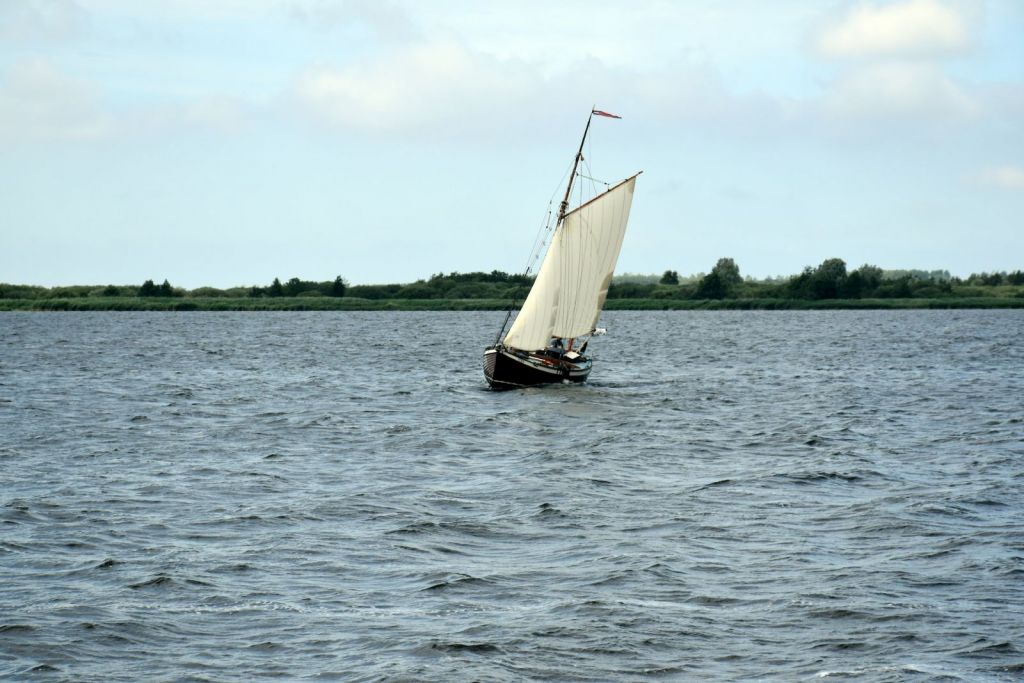
On this page:
The best solo bluewater sailboats, what makes a good solo bluewater sailboat, cost considerations when choosing a sailboat, maintaining your bluewater sailboat, contessa 32 is a classic, compact, and seaworthy sailboat.
Contessa 32's sturdy construction and excellent sailing performance have earned it a legendary reputation among sailors. With a well-designed interior layout, it has space for living aboard during your solo adventures. The Contessa 32 is a classic bluewater sailboat designed by David Sadler in the 1970s. It is known for its excellent balance, seaworthiness, and speed. It has a full keel, moderate displacement, and a classic design that has stood the test of time.
Westsail 32 is known for its rugged construction
The Westsail 32 gained fame as an affordable, rugged, and capable long-distance cruiser. Its full keel and sturdy hull ensure a comfortable ride in rough seas. The practical, function-driven interior makes it easy for solo sailors to maintain and navigate the vessel while providing essential amenities for an extended voyage.
Westsail 32 is another classic bluewater sailboat that was designed by William Crealock in the 1970s. It is known for its rugged construction, spacious interior, and excellent performance in heavy weather. The Westsail 32 has a full keel, heavy displacement, and a classic double-ender design.
Hallberg-Rassy 42F is known for its top-notch craftsmanship
The Hallberg-Rassy 42F is another superb choice for single-handed bluewater sailing. This Swedish-built yacht is well-renowned for its top-notch craftsmanship, stability, and comfort. It offers a spacious, well-lit interior, ensuring you'll enjoy your time below deck while cruising the open seas.
Hallberg-Rassy 42F is a modern bluewater sailboat designed by German Frers in the 1990s. It is known for its luxurious interior, excellent performance, and high-quality construction. The Hallberg-Rassy 42F has a fin keel, a spade rudder, and a modern design that combines comfort and performance.
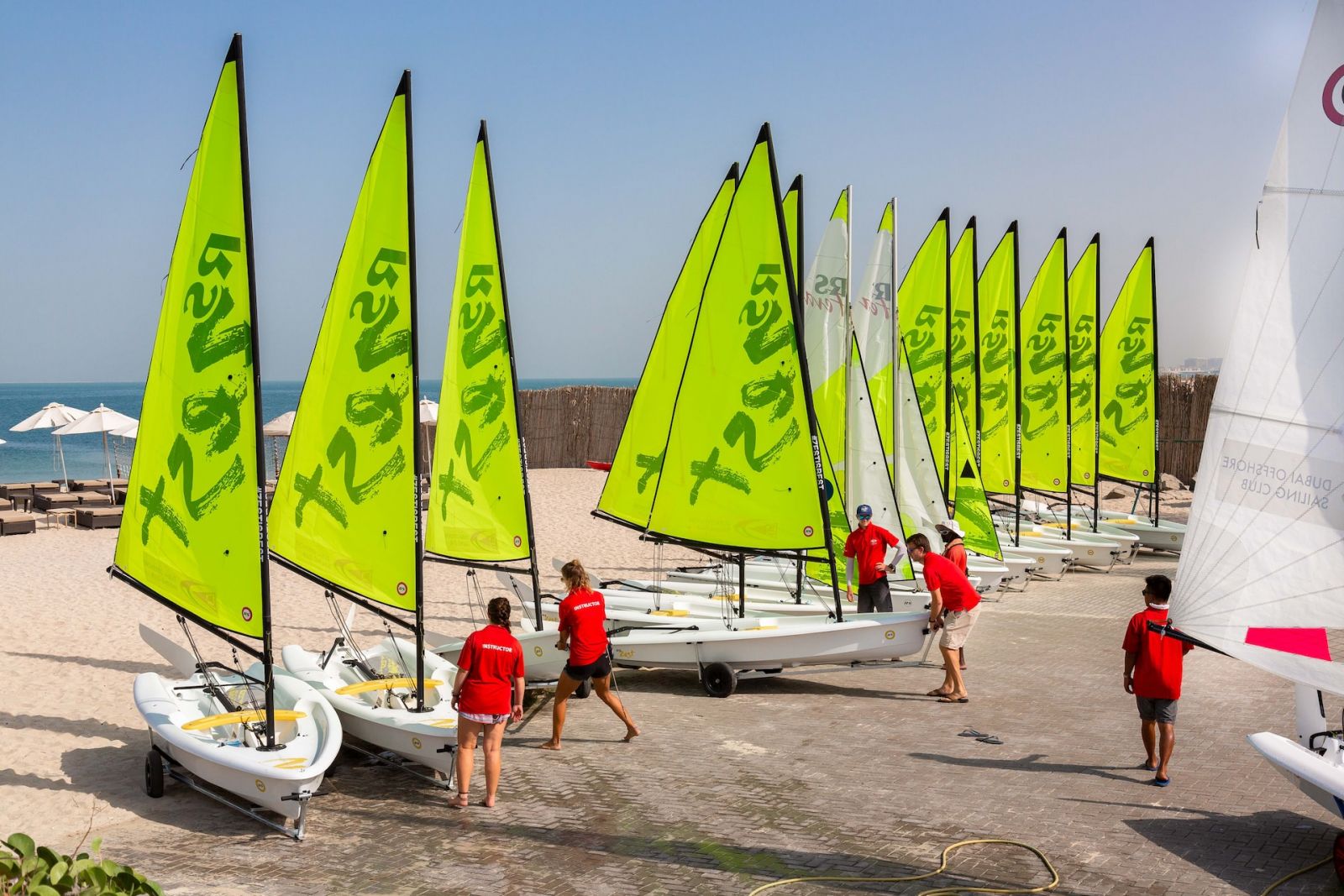
Pacific Seacraft 37 is designed for serious cruising
Pacific Seacraft 37 is a sturdy and reliable boat for solo sailors. Its moderate displacement and full keel provide excellent stability, while the well-thought-out interior layout includes abundant storage and comfortable living quarters. Its reputation as a proven bluewater cruiser makes it a top choice for solo sailors. The Pacific Seacraft 37 is another classic bluewater sailboat designed by Bill Crealock in the 1970s. It is known for its excellent balance, seaworthiness, and comfort.
Island Packet 38 is known for its spacious interior
Island Packet 38 is a popular choice among solo cruisers, thanks to its stable full keel design and living space. Its build quality, comfort, and performance make it well-suited for long-distance sailing. The spacious interior and practical layout ensure you have everything needed for a successful solo journey. Island Packet 38 is a modern bluewater sailboat designed by Bob Johnson in the 1990s. It 38 has a full keel, moderate displacement, and a modern design that combines comfort and performance.
Aside from bluewater sailing , there are other types of sailing discussed in this article.
Tayana 42 is known for its excellent balance, seaworthiness, and comfort
Tayana 42 is a comfortable, sea-kindly sailboat, ideal for single-handed offshore cruising. Its balanced performance, easy handling, and well-equipped interior ensure a safe and comfortable journey. It is well-regarded among sailors for its proven bluewater capabilities and timeless styling. The Tayana 42 is another classic bluewater sailboat designed by Bob Perry in the 1970s. It has a full keel, heavy displacement, and a classic design that has stood the test of time.
The Amel 54 is known for its luxury and exceptional build quality
This French-built vessel offers a spacious and comfortable interior with top-of-the-line amenities, making it an excellent option for solo sailors seeking a bluewater cruiser to explore the world in style and comfort. Its easy-to-handle design with advanced sailing systems allows you to sail solo with confidence and ease. The system includes electric winches, furling sails, and a self-tacking jib, which make it easy to handle the boat in all conditions.
To learn more about bluewater sailing , here's our comprehensive article on it.
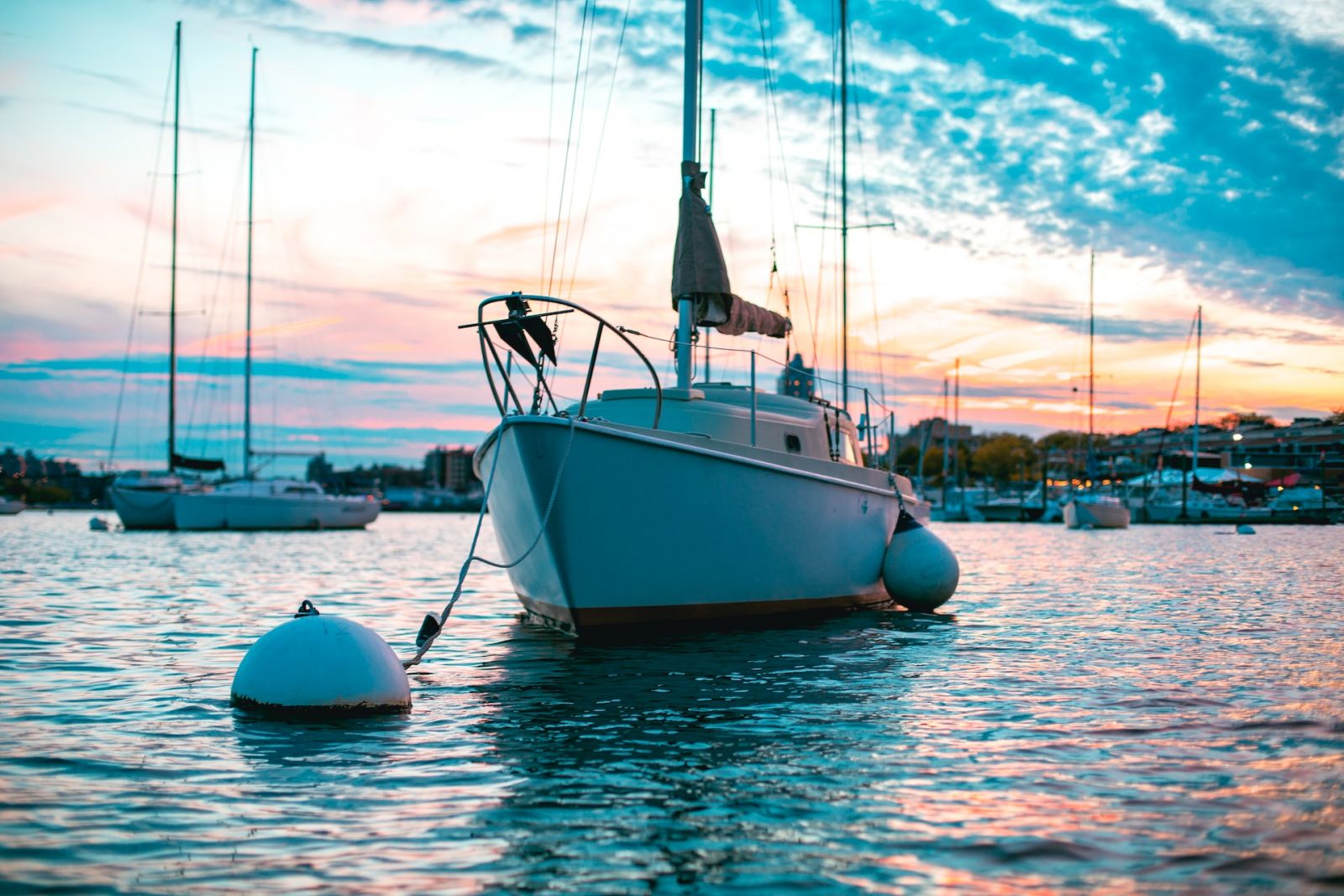
These factors will ensure not only your safety but also your comfort and ease during your sailing adventure.
Size and stability of a solo sailboat
A boat with a wide beam and short waterline provides more stability, making it easier for you to handle the vessel on your own. Some popular sailboat models known for their size and stability include the Westsail 32 and the Hunter Channel 31.
A good solo bluewater sailboat should be large enough to provide adequate storage space for supplies and equipment, while also being stable enough to handle rough seas and high winds. It should also have a well-designed hull shape that provides good stability and balance, and a keel that provides good tracking and prevents the boat from capsizing.
Ease of use and maneuverability of any solo sailboat
Features like roller furling and an electric windlass can make handling the sails and anchor much more straightforward. Also, hydraulic bow/stern thrusters with remotes can help you maneuver your boat easily and safely. Make sure to look for these features when choosing your bluewater sailboat.
A good solo bluewater sailboat should be easy to handle and operate by a single person. It should have a sail plan that is easy to adjust and control, and a steering system that is responsive and easy to use. It should also have a well-designed cockpit that provides good visibility and protection from the elements.
Durability and seaworthiness for long-term safety
A well-built sailboat with a history of proven offshore performance should be at the top of your list. Some of the best and most famous bluewater sailboats include the Alberg 30 and Hanse 371.
A good solo bluewater sailboat should be built to withstand the rigors of extended ocean voyages. It should have a strong, well-built hull that is capable of withstanding heavy seas and high winds. It should also have a well-designed rigging system that is strong and durable, and a keel that is designed to provide good stability and balance.
To learn more about the best keel design for bluewater sailing , here's our article on it.
Comfort and livability of a solo sailboat
Consider the layout and features of the boat, ensuring that it has a comfortable sleeping area, a well-equipped galley, and ample storage space. A good example is the Valiant 40, known for its excellent layout and seaworthiness.
A good solo bluewater sailboat should be comfortable and livable for extended periods of time. It should have a well-designed interior that provides adequate storage space, comfortable sleeping quarters, and a functional galley and head. It should also have good ventilation and lighting, and be well-insulated to provide protection from the elements.
Affordability and availability determine the sailboat's practicality
Set a budget and research suitable sailboats within that price range. Some budget-friendly options include the J/109 and Westsail 32. A good solo bluewater sailboat should be reasonably priced and readily available. It should be affordable for most sailors who are interested in long-distance cruising, and should be available for purchase or charter in most parts of the world.
If you're looking for bluewater sailboats under 40 feet , here's our article where we picked the top 13 most famous ones.
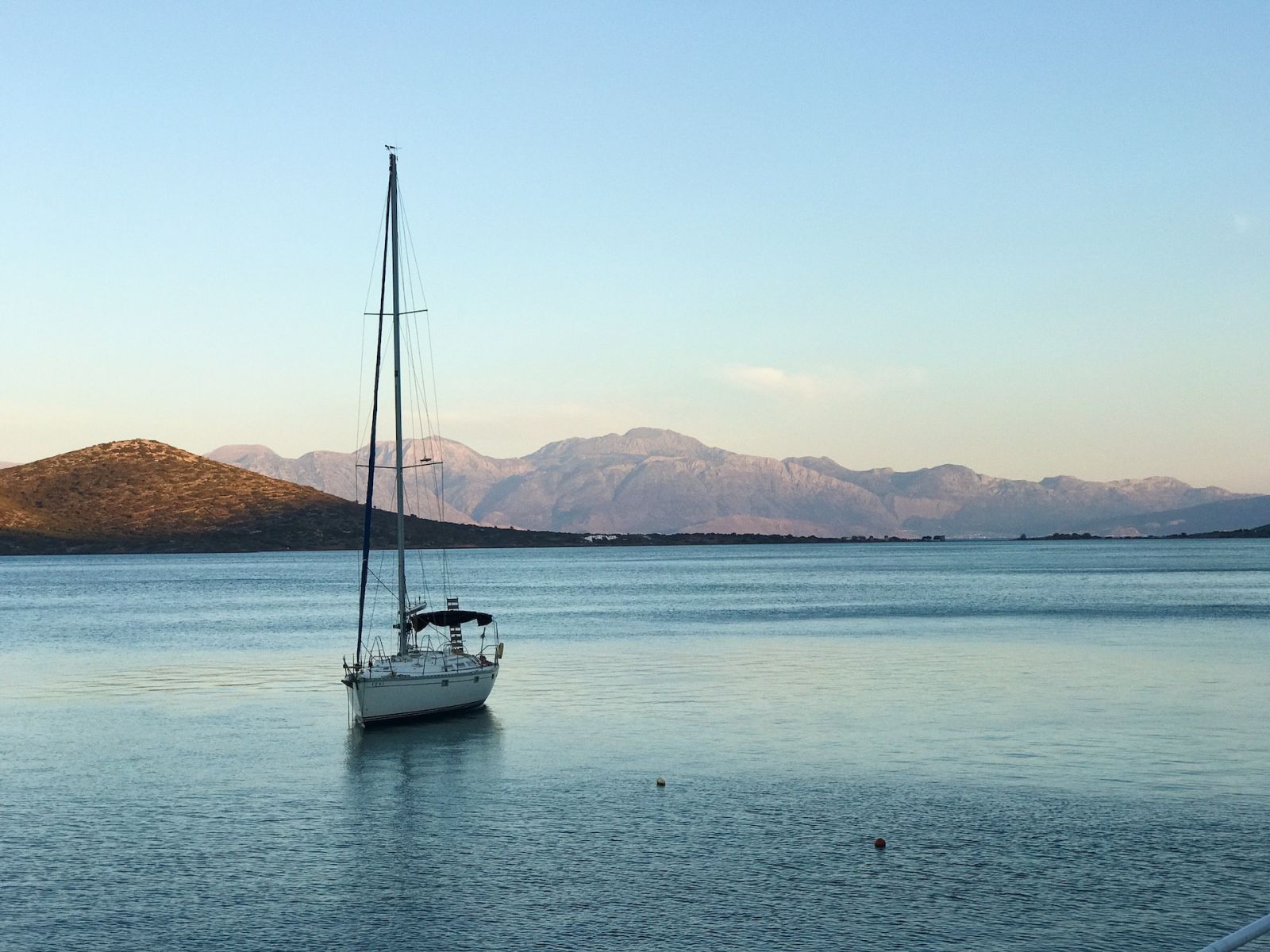
You'll be faced with a range of solo bluewater sailboat options, from budget-friendly to luxury models. Let's explore some factors you should keep in mind to make the best decision for your needs and budget.
Initial purchase price : This is often the first thing people think of when it comes to the cost of a sailboat. There's a wide range in prices, depending on factors like age, size, and brand. For example, a used Alberg 30 might cost between $10,000 and $15,000, while a new Amel 54 could be in the range of hundreds of thousands of dollars. It's important to find a balance between quality and affordability that suits your needs and financial capabilities.
Maintenance and repairs : Owning a sailboat comes with ongoing expenses to keep it in good sailing condition. Regular maintenance tasks like painting, replacing worn rigging, and inspecting safety equipment can add up over time. Be prepared to allocate a portion of your budget for these essential tasks, as neglecting them could lead to more expensive repairs down the line.
Marina fees and insurance : Depending on where you plan to keep your boat, you may incur costs for marina or dockage fees. Additionally, securing insurance coverage for your sailboat is a must to protect your investment. Both of these costs can vary widely, so make sure you factor them into your overall budget.
Upgrades and equipment : To ensure your sailboat is well-suited for solo bluewater sailing, you might need to invest in upgrades to improve its safety and performance. For instance, you may want to add a roller furling system, wind vane, or more advanced navigation equipment. These enhancements can amount to a significant investment, so it's wise to plan financially for any desired upgrades.
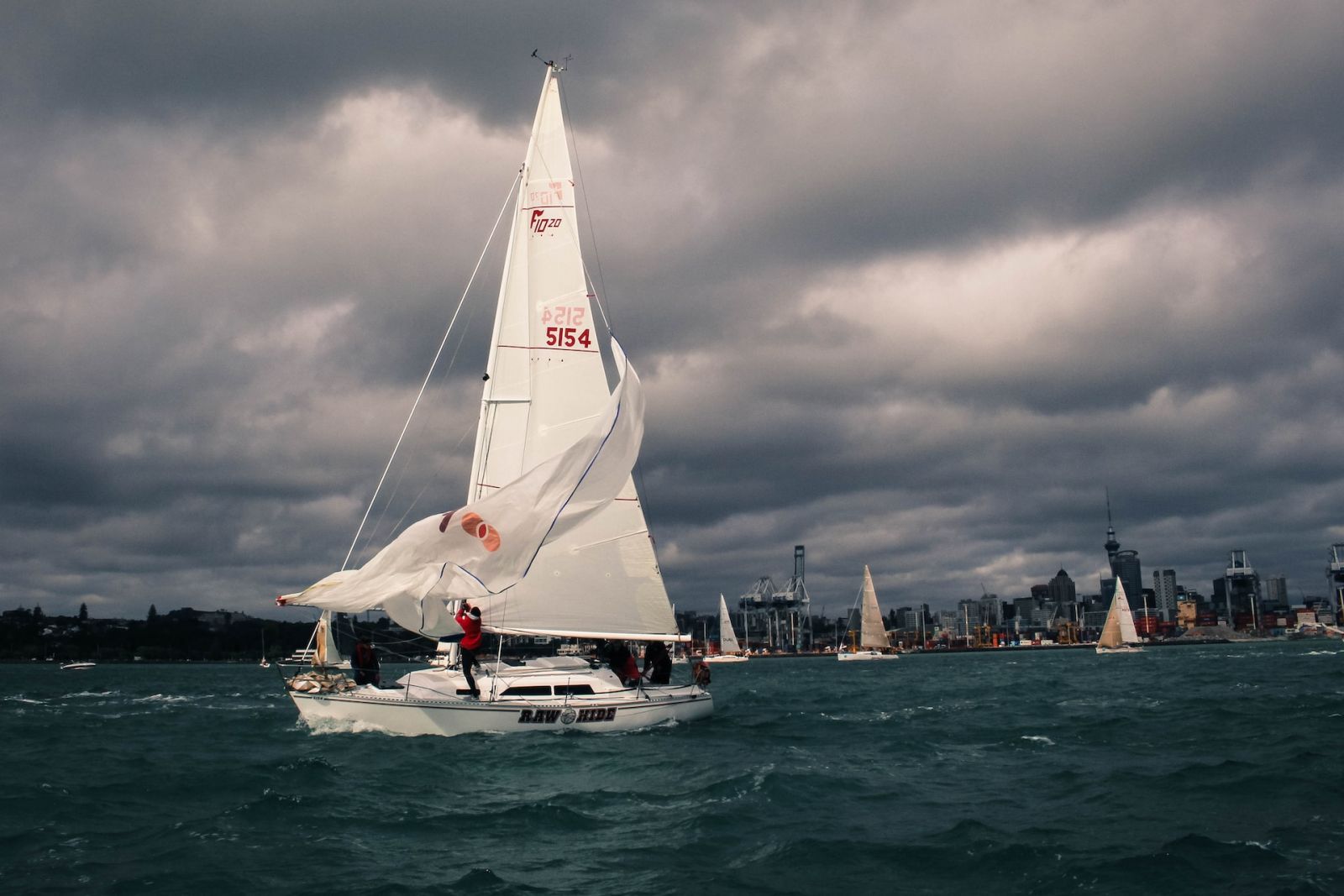
Here are some essential tips to keep your boat in top shape, and ensure its long life and performance during solo journeys:
Regular inspections : Make it a habit to perform a thorough inspection of your sailboat periodically. Examine the rigging, sails, hull, and all mechanical components. Routine inspections allow you to detect any signs of wear, damage or potential problems before they escalate.
Cleaning : Keep your sailboat clean by washing it regularly with freshwater and appropriate cleaning solutions. This simple practice prevents the buildup of dirt, salt, and other debris, which can cause corrosion and damage to your vessel over time.
Checking the bilge : Ensure that your bilge pump is working efficiently and that there's no water accumulating in the bilge area. If there are any signs of water accumulation, investigate the source and address any leaks or issues promptly.
Servicing the winches : Winches play a crucial role in your sailboat’s performance, so it’s essential to inspect, clean, and grease them regularly. This practice will guarantee their smooth operation and prolong their lifespan.
Sail care : Inspect your sails frequently for any tears, wear, or damage. Repair or replace them as necessary. To protect your sails from the sun’s harmful UV rays, always use a sail cover when not in use.
Keeping records : Maintain a logbook to document all maintenance tasks, inspections, and repairs. Not only will this help you keep track of what has been done, but it will also provide valuable information if you decide to sell your sailboat in the future.
Leave a comment
You may also like, what is bluewater sailing.
It's easy to confuse offshore sailing with bluewater sailing - and it's no wonder. Many people do, including myself. So I've decided to list the difference once and …
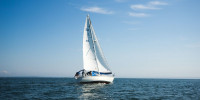
13 World-Famous Bluewater Sailboats Under 40 Feet

What's the Best Keel Design for Bluewater Sailing?

Different Types of Sailing and Racing Explained

41 Sailboat Cruising Essentials for Long Trips
Own your first boat within a year on any budget.
A sailboat doesn't have to be expensive if you know what you're doing. If you want to learn how to make your sailing dream reality within a year, leave your email and I'll send you free updates . I don't like spam - I will only send helpful content.
Ready to Own Your First Boat?
Just tell us the best email address to send your tips to:
Better Sailing

Best Sailboats to Singlehand
Sailing alone can be an extraordinary experience for many boaters. Many have attempted to sail on long passages and explore the oceans. But, a common concern is, which one is the right boat to sail single-handed? We’ll find out together in this article. Fortunately, there are many suitable seaworthy vessels for one person. In this article, I list you the best boats to single-hand as well as find out what makes them appropriate for single-handing. These boats range from small lake dinghies all the way to comfortable cruisers capable of oceanic crossings. So, keep reading!
A Few Things About Single-Handed Sailing
There are many boats that perform particularly well for shorthanded sailing. However, the fact is that the structures on a boat have a greater effect on its suitability rather than the boat’s construction. Main features regarding single-handed sailing include easy sail controls, including the ability for one person to quickly tuck a reef in. And, let’s not forget the ability to easily change the sheets and the mainsheet traveller. If you’re looking for a boat to short-handed sail, start by looking at the reefing and sail handling systems, as well as the pilot’s specifications. It’s a great advantage to be able to reach both mainsheet and the primary winches from the helm. But, when sailing on long passages then the pilot might be steering for almost 100% of the time.
For shorthanded sailing, many sailors prefer smaller vessels. This point has a lot of sense because their compact size, ease in navigation in a small room, and less complicated structures, make them more simple to sail. But, keep in mind that there are also sailboats of 70ft that are set up to be handled by 1 or 2 persons on deck. In which case, the sailors must be experienced and be able to fix any damaged system. So, if a vessel is properly set up it can be easily handled by one or two experienced sailors, no matter its size.
Boats made from the early 1990s onwards are more stable than their ancestors, as well as deep draught low center of gravity keels. These are a great choice for single-handing. The added stability means a reduced need to reef which facilitates the overall sailing experience and performance.
In any case, the below-mentioned boats, and similar others in each respective range, form great choices for single-handed sailing. They all offer easy short-handling for either beginners or experienced. And also for those that want to experience calm sailing to those seeking a fast and responsive, but ultimately safe, vessel.
Handling and Set-up
First of all, when solo sailing, it’s important to focus on the ease of handling your boat. This is because you will be in charge of all roles; skipper, navigator, bow-person, dial trimmer, engineer, and chef! So, what you want to achieve here is making all these roles simpler in order to facilitate all tasks.
So, it’s advisable to take your boat out on a calm sea and experience all possible motions of sailing. Like you were racing or cruising but also hoisting sails, trimming, steering, and navigating. Like this, you will be able to see if any problems come up. The most common problem sailors experience is reefing the mainsail by themselves. Also, the spinnaker pole might be too much to handle by yourself or find it difficult to reach the sheeting positions. In other words, if you’ve never sailed short-handed before, this first experience might seem challenging. And, some things are really important to handle like reaching the main traveler while steering. But, don’t get discouraged! Consider taking notes while onboard, and start finding new ways of facilitating your voyage.
Some simple changes include shifting a halyard clutch. But, there are more challenging ones like switching to a single-line reefing system. Wherever feasible, a single-line reef system is preferable. But, adding a reef tack line and getting back to the cockpit can be even more convenient and require less line that will probably tangle in the cockpit. Keep in mind that the most important factor for single-handed sailing is to make your boat easier to sail. So, now let’s see the best boats for single-handed sailing!
The Hanse 371 was built from 1999 until the mid-2000s. The boat offered a selection of either deep or shallow low center of gravity fin keels. These were joined with the hull and a long waterline. Below the deck, you can choose between 2 or 3 cabin layouts with a comfortable galley. Hanse 371 benefits from self-tacking jibs so when tacking all you have to do is spin the wheel. And, in case you’re sailing on autopilot you just press a few buttons and you’re good to go.
In addition, you can increase sail area when reaching in light air with a Code 0 or asymmetric spinnaker. This model maximizes the amount of space and with a reasonable budget. So, with its great interior and performance, the Hanse 371 is a seaworthy vessel that may cost you around $60,000. Most importantly keep in mind that everything is standard and easy to use. Like this, you simplify your life while sailing single-handed.
Jeanneau Sun Fast 3200
The Jeanneau Sunfast 3200 was manufactured with offshore short-handed sailing taken into account since the beginning. This boat is not only a classical sailing boat but also a small and light one that is easy to navigate. Even better, it has the durability and strength to withstand long passages. And, for this reason, they built it specifically for the Trans-Atlantic race. This boat is especially impressive when you sail off the wind, and totally practical and reliable even when sailing alone. This could be due to the fact that the design and setup are mostly constructed for racing. So, it could be ideal for you if you’re looking for a coastal cruiser that’s easy to handle.
Even when sailing downwind, you can easily achieve double figures in terms of speed with this boat. In particular, the Sunfast 3200 features cutting-edge technology to provide you with the best strength-to-weight ratios possible. It has all of the requisite features to easily adapt it to perform admirably as a sailing or racing sailboat. The boat features two double cabins, a chart table, a galley, and a head compartment.

>>Also Read: Best Sailboats Under 20ft
Beneteau Oceanis 62
Let’s now pass to the bigger fellas! As aforementioned, single-handed sailing doesn’t mean you have to choose small sailboats. This is because nowadays single-handed 60+ ft boats aren’t that rare in terms of production, as they were in the past.
Basically, the Beneteau Oceanis 62 meets the modern demands of today’s market and was specifically designed to provide ease of use. In other words, it can be easily handled and operated by a single person. I know that all this space might be a bit exaggerated, but if you’re the kind of person that enjoys being in oceanic solitude while benefiting from having a moving apartment, then this one is for you! Of course, there are more boats of the same size suited for short-handed sailing, like the Hanses, Bavarias, and Jeanneaus. But, you can find a new Oceanis 62 for around $724,500, which is a great price for boats of that size combining both performance and quality.
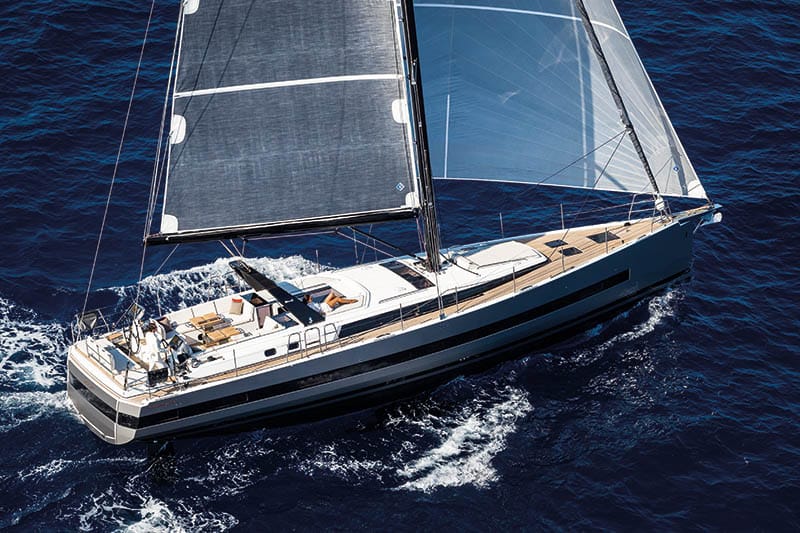
>>Also Read: Is It Dangerous to Sail Around the World?
Hunter Channel 31
From the mid-1980s onwards, this British boatbuilder transitioned from racing to powerful but easy-to-handle small cruisers. As a result, a series of boats has been developed that can sail almost effortlessly without losing handling characteristics.
The deck layout features an effective layout, with an optional self-tacking jib and single-line mainsail. As a short-handed sailor, you’ll benefit from the tiller steering, which allows you to steer with your legs while trimming sails. The accommodation below decks is well-designed and provides considerably more room than the previous Horizon 30 model.
This model, which debuted in 2001, was of higher quality than the majority of Hunter’s other cruising models and greatly focuses on performance. It was also one of the company’s last all-new designs, so it benefited from the most up-to-date design at the time. This was especially apparent in the well-balanced hull shape, which also provided excellent form stability. Joined with high ballast ratios and low center of gravity keels resulted in a boat that doesn’t need continuous trimming to maintain high average speeds or avoid repeated broaching in gusts.
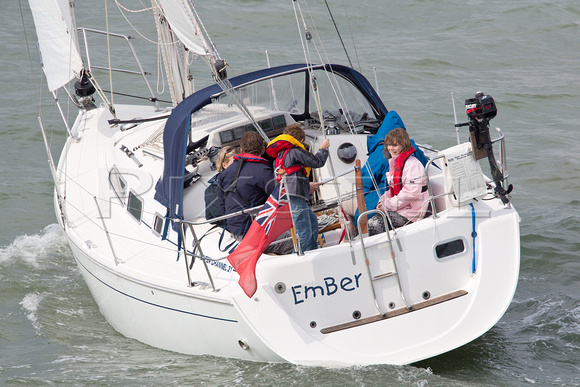
>>Also Read: How Far Can you Sail in One Day?
This is the prototypical short-handed performance boat in several respects. Long-distance single-handed and double-handed sailors love it as well as inshore racing teams. The boat’s offshore reputation has been well established, with many North Atlantic crossings under its belt. Although J/109 is often considered as a planing boat, this 19-year old model is too heavy to be one of that kind. It is basically a moderate all-rounder that offers great performance with the ability for extended surfing when offshore. The boat is also available in a shoal draught form, but it didn’t sell that much.
A great advantage is that the big asymmetric spinnakers can be easily gybed from the cockpit in light airs. And, a poled-out jib can still provide fast downwind speeds with an enviable degree of control in a true wind of more than 20 knots. Almost everyone sailing J/109s short-handed, at least in Europe, hasn’t used the boat’s original overlapping genoas so as to employ blade jibs that are set on roller furling gear.
The only downside is that the boat is expensive for one of this size on the second-hand market. However, its quality of construction and the high standard equipment aren’t going to let you down. Moreover, the interior layout is sparse and has less interior space, although it provides a well-designed and effective two-cabin compartment.
Catalina 315
This is a stylish pocket cruiser that raises the bar for solo sailors by providing exceptional comfort and efficiency. With a hull length of 31′, the Catalina 315 has more interior space than most classics and is still ideal for solo sailing. Rigging the Catalina 315 is a lot simpler with a masthead sloop because it has both an in-mast roller furling mainsail and a roller furling genoa.
Despite the fact that it is a much larger boat, it has a few key features that make all the difference. The split backstays, for example, are excellent for balance and functionality. This is one of the key reasons it was named the 2013 Boat of the Year Best Inshore Cruiser by Cruising World. The boat might surpass your needs when sailing solo, as it is a high-end sailboat with a price tag of more than $175,000. However, if that seems too pricey, you can look for a used model, which will be slightly less expensive.

Pacific Seacraft Flicka 20
The Flicka is a 20-foot sailboat developed and planned for extended cruising and bluewater sailing. The Newport workboats of the 19th century were distinguished by their sweeping sheer, proud bowsprit, blunt bow, broad beam, and low side decks. Flickas by Nor’Star and Pacific Seacraft have withstood the test of time. This is because most Flickas were made with polyester resin or vinlyester resins later on in the production.
For some sailors, this is a disadvantage as you don’t realize just how small the Flicka is until you step into the cockpit. However, it’s a seaworthy vessel and offers a remarkably spacious interior. In addition, the robust tiller is mounted on the transom, thus giving good leverage for steering and freeing up cockpit space. As for the interior, there really is enough standing headroom as well as the open-plan without a full forward bulkhead opens things up. The galley offers all basic equipment and the V-berth is large and comfortable.
On top of that, the Flicka is towable, seaworthy, and you can actually liveaboard. Even though it is a small craft you can still cross the oceans with it. On this one, there’s no denying that everything is within easy reach. At this scale, ergonomics are almost irrelevant. Because of its towability, the fact that it can be parked in your garden, and its short-handed capability, it’s the ideal spontaneous getaway vessel.
Amel 60 definitely got your back while sailing solo in the oceans. The Amel 60 features great advantages and, with its rectangular hull portlights and wraparound windscreen, it takes you on the modern cruising generation.
Fixed bowsprits and plumb bows ensure a modern design and experience. In addition, lines open out into beamy sections aft and benefit from twin rudders. And, since these forms, when paired with the proper buoyancy distribution, can provide a faster hull form, it’s a no-brainer for cruising designs to follow the secondary benefits that come with this fuller form. The watertight bulkheads ensure that the boat won’t sink. Moreover, the cockpit has a sturdy roof and windows, so you’ll be safe no matter the weather. And, the stable hull ensures great handling even in challenging weather conditions.
One of the main benefits is the increased volume, which applies to both the accommodation and the deck lockers. When heeled, twin rudders minimize drag and provide a more balanced feel while underway. However, if they get damaged they provide a redundancy level. The shallower rudders also help in mooring stern-to for those who spend more time in areas like the Mediterranean. In the interior, you get enough space and luxury as well. There’s even a washing machine! So, even if you are an experienced single-handed sailor that wants to benefit from space and performance, then with the $1.5 million price you will get this luxurious boat!
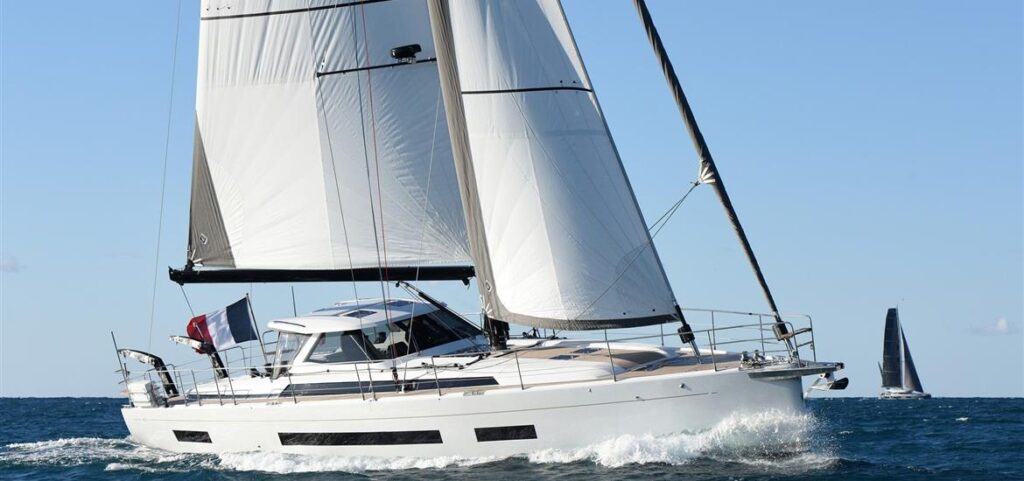
Beneteau 31
As a small cruiser keelboat, this French-designed vessel is predominantly constructed of fiberglass and is ideal for single-handed sailing without minimizing interior space and comfort. Its galley has ample storage and counter space, as well as a sit-down navigation station with a small table. The interior benefits from the straight-lined and elegant thinking of Nauta Design. The comfy seats on either side of a drop-leaf table double the living space. There’s also a spacious athwartship aft-cabin berth and V-berth.
Under power, maneuvering this boat is a breeze, and it’s well worth it for any solo sailor looking for a coastal cruiser. It has a fractional sloop rig, which allows for in-mast furling. This makes it simple to control while also making it strong in light winds. A bow pulpit and an optional asymmetric cruising chute will enhance the performance if you’re sailing the boat off the wind. The new 31 is estimated to cost about $115,000, which is very pricey but well worth it if you want to cruise the globe in this French masterpiece.
Best Sailboats for Solo Sailing – The Bottom Line
Singlehanded sailing is a great achievement in terms of adventure and endurance, especially for lone sailors that cross the oceans. Many experience sleep deprivation, the stress of being alone, and difficult weather conditions that have to be handled by yourself. So, if you decide to set sail for an offshore voyage on your own is a big step to make. And, surely you need a sturdy and seaworthy boat. All the aforementioned boats are considered to be the best cruisers for single-handed sailing. It is up to you to decide which one to choose. This will be determined according to your budget, preferences, needs, and course of your voyage. And, remember that sailing solo learns you to live independently which is a great achievement!
Peter is the editor of Better Sailing. He has sailed for countless hours and has maintained his own boats and sailboats for years. After years of trial and error, he decided to start this website to share the knowledge.
Related Posts

The Ultimate Guide to Choosing the Best Fishing Line for Trolling

Lagoon Catamaran Review: Are Lagoon Catamarans Good?

Best Inboard Boat Engine Brands

Are O’Day Sailboats Good? A Closer Look at a Classic Brand
- Buyer's Guide
- Destinations
- Maintenance
- Sailing Info
Hit enter to search or ESC to close.
- AROUND THE SAILING WORLD
- BOAT OF THE YEAR
- Email Newsletters
- America’s Cup
- St. Petersburg
- Caribbean Championship
- Boating Safety

2022 Boat of the Year: Best Offshore Racer
- By Dave Reed
- December 17, 2021
Sailing World Magazine’s annual Boat of the Year tests are conducted in Annapolis, Maryland, following the US Sailboat Show. With independent judges exhaustively inspecting the boats on land and putting them through their paces on the water, this year’s fleet of new performance-sailing boats spanned from small dinghies to high-tech bluewater catamarans. Here’s the best of the best from our 2022 Boat of the Year nominees »
As interest in doublehanded offshore racing piqued with the expectations it would be an Olympic sailing discipline in 2024, so too did the development and production of several purpose-built 30-footers. Dehler Yachts, Germany’s big production boatbuilder, jumped into the action with its own 30-footer, and as we’d expect of a Judel/Vrolijk and Co.-designed race boat, this one is an all-business shorthanded racing machine jam-packed with cool features found on grand‑prix boats twice its size.
“You can tell they started with a blank slate because the boat is so well-integrated with the design and construction—from bow to stern,” Greg Stewart says. “It hits its design purpose spot on. It’s a complete small offshore one-design, and it’s obvious there was a lot of development required to get things so right.”
Prototypes and mock-ups after mock-ups were required, Dehler says, to efficiently accommodate a lot of boat handling and living in such a compact craft. Virtually every rope on the boat spills into the cockpit, which is the way of life in shorthanded sailing, where everything happens at the back of the boat. Vigilance with line keeping, therefore, is paramount. That and carefully executed and planned maneuvers. In full-tilt conditions, there will be a lot going on in the cockpit, Stewart says, but everything’s easily at hand.
“All the control-line leads are well thought out,” he adds, pointing to the smooth-operating traveler controls and the individual gross and fine-tuned mainsheet flip cleats mounted on the cockpit floor.
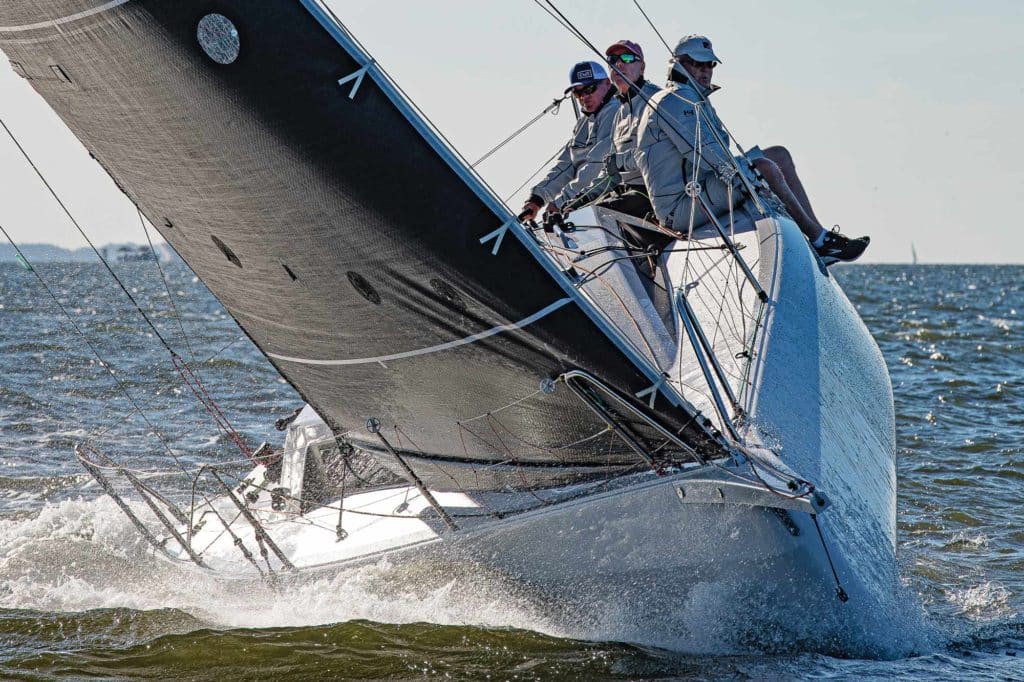
Powlison’s first impression at the dock was that the boat would be challenging to manage, but “once we went sailing, it all was logical. Yes, there’s a lot of line management, but once you’re disciplined to do that, the boat is much easier to sail than it looks.”
With the trio of judges and the owner piled on board during the test sail, it was immediately obvious that two is company and three is definitely a crowd. “It’s also not the type of boat where you’ll want to spontaneously invite an inexperienced crew [to go race],” Powlison says. “You will really need to know what you’re doing, but once you do get comfortable with everything, it will be a really easy boat to sail well.”
Ben Corson, the Annapolis-based owner of our test boat, had spent the better part of a year racing with his female partner and tinkering with the boat, and consequently, the boat is meticulously prepared, race-ready and offshore-compliant. There’s no mistaking what’s what and where—labels pasted throughout the boat identify halyards, sail and ballast controls, safety gear and even the electronics manuals.
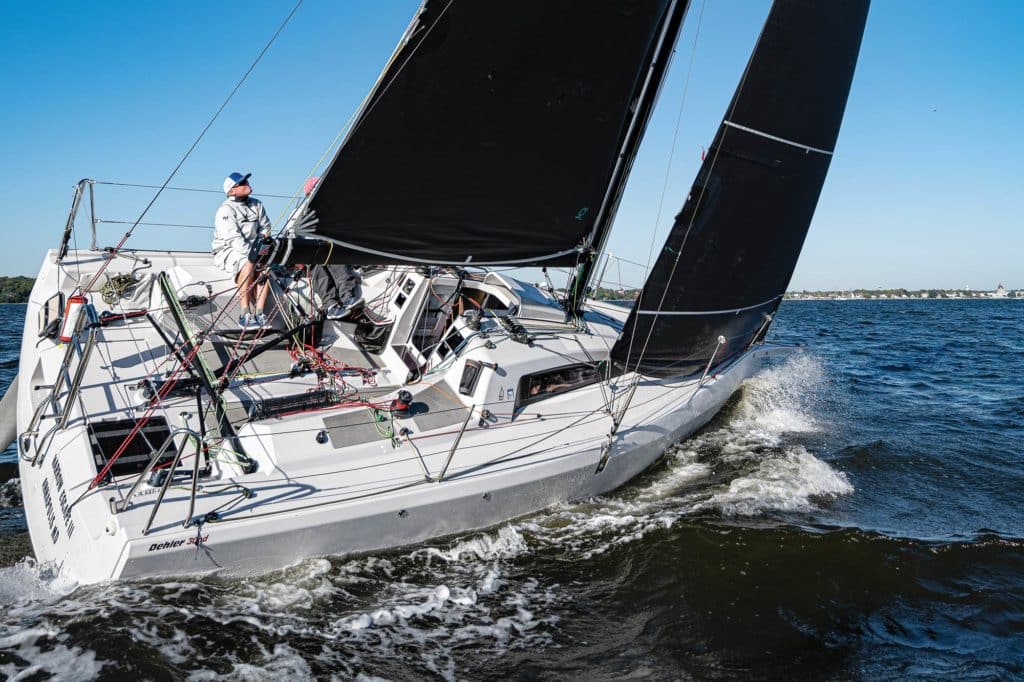
As a tightly controlled one-design class with ratified rules, owners like Corson can’t do much to the boat as it is, but there’s not much—if anything—an owner would need to change anyway. Everything on the boat, the judges agreed, works as it should. Adjustable backstays, for example, lead forward to clutches mounted on the cockpit wall, which allows the backstays to be kept taut or released without having to worry about loading to a winch during a maneuver. With the turn of a locking nut on the tiller arm, the steering system can be adjusted to change rudder toe-in on either side. The traveler track runs nearly the full width of the wide transom, opening up a wide range of adjustability for the 361-square-foot mainsail, and as a bonus, small removable reaching struts open up headsail sheeting angles. Stainless-steel foot braces are easy to deploy and stow, and allow the skipper to lock into a comfortable position over the angled coaming, with great visibility over the bow.
When the boat is powered up and leaning on the chine, Allen says, the sensation is exceptional: “This delivered the best sailing experience of all of the boats we tested. It was easy to tack and jibe, it tracked great, it’s easy to get to the sail controls, and we had no problems whatsoever with wiping out—and we tried hard a few times.”
With Allen on the tiller and Powlison managing the sheets as they started upwind into a 15-knot breeze, Stewart hit the chamfered rail. “My first impression from the rail was how high I was and how it was charging upwind—like a big boat. I couldn’t feel the chop, I didn’t get wet, it didn’t skid out at all. I was also amazed at how solid it felt; there wasn’t one bit of pounding, creaking or anything.”
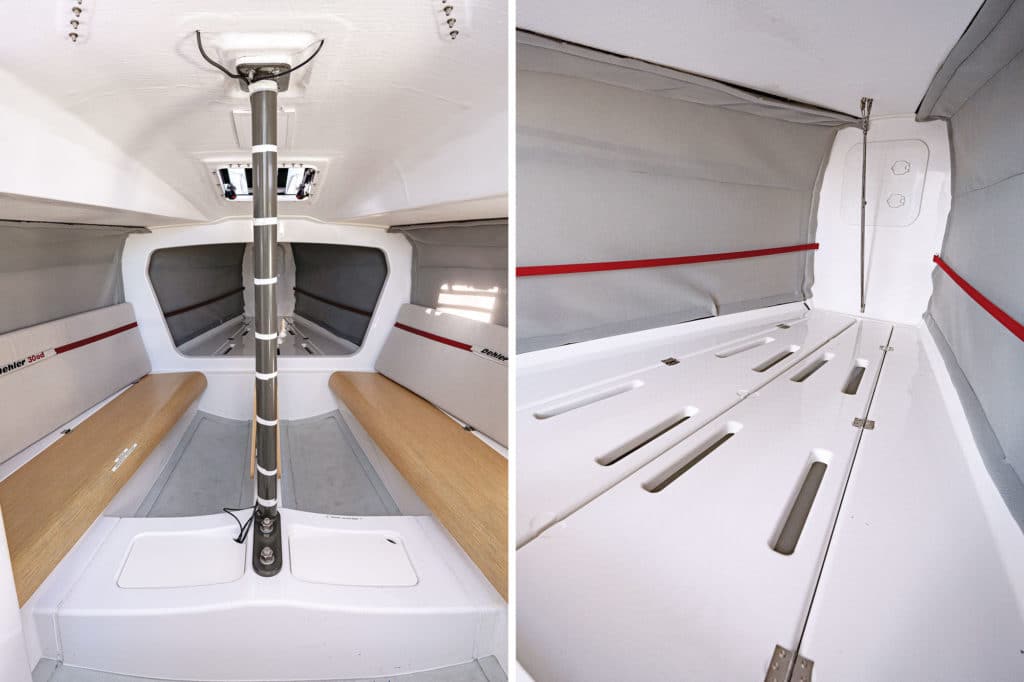
Eventually, Stewart came off the rail and they filled the ballast tank instead—to the equivalent of 400-plus pounds of rail meat. Allen says the gravity-fed water-ballast system took about five minutes to top off, roughly 30 seconds to transfer during a tack, and less than a minute to drain.
“Once we added the water ballast, the boat just powered forward,” Powlison says. “You can really feel the difference when the boat sits on the chine and just tracks straight ahead.”
Impressed as they were with the Dehler 30’s upwind pace, when they set the big red A2 spinnaker (1,076 square feet) and took off down the bay, they had no doubts about the boat’s downwind potential. They only used three of the five class-sail inventory on board, which includes an A2, an A5, a spinnaker staysail and a Code Zero, and if they had more time and distance, they would have certainly piled on more sail area.
“I could see going with the A5, the J3 and the staysail, and maybe a reefed main in a big breeze,” Allen says. “That would be fun—and wicked fast.”
Lightweight and strong is, of course, the holy grail of every race boat, and here too Dehler delivers with what the judges say is an immaculate cored-hull laminate and good detail in the finish work throughout the boat. Dehler was also keen to leave out extraneous weight from the interior to get the boat to weigh in at just over 6,000 pounds. Without any floorboards (there’s thin foam padding glued to the inner hull skin instead), they’re able to get 6 feet of standing headroom at the companionway (which has a sliding hatch hood on rails) and plenty of sitting headroom forward of the mast and into the V-berth.
To achieve a higher level of the camper-sailor experience, comfortable V-berth cushions and removable mesh hull liners are standard, as is a folding centerline table, rounded wooden bench seats, and backrests that double as pipe berths. With storage cubbies scattered about the boat, a marine toilet with a graywater tank, a two-burner stove and two quarter berths, this little race rocket is definitely a legit weekender too. Lithium-ion batteries and a 9.9 diesel with a retractable Stealth Drive shaft that pulls up flush with the hull will get you where you need to go and keep the electronics suite powered up just fine.
The Dehler 30 was a strong contender for Boat of the Year, but the judges couldn’t dismiss the boat’s biggest limitation: It will get hammered by most rating systems, which makes it a one-trick one-design offshore-racing pony. It is, however, an outstanding design for keen shorthanded sailors looking for a race-ready platform for just over $240,000. If—or when—international class racing ever becomes a real thing, the offshore sailing world will be a better place.
- More: Boat of the Year , Boat of the Year 2022 , Dehler , Sailboats
- More Sailboats

Nautor Swan Has A New Pocket Rocket

Pogo Launches its Latest Coastal Rocket

A Deeper Dive Into the Storm 18

2024 Boat of the Year Best Recreational Racer: Z24

Luna Rossa’s New AC75 Marks Its Silver Age

Emirates Team New Zealand Splashes Defense Yacht

Wanderers of the Wayfarer Dinghy

Alinghi Red Bull Racing First to Reveal Its AC75

- Digital Edition
- Customer Service
- Privacy Policy
- Cruising World
- Sailing World
- Salt Water Sportsman
- Sport Fishing
- Wakeboarding
Single Handed Sailboats: The Ultimate Guide for Solo Sailing
by Emma Sullivan | Aug 22, 2023 | Sailboat Gear and Equipment

Short answer single handed sailboats:
Single handed sailboats, also known as dinghies or small keelboats, are sailing vessels designed for easy handling by a single person. They typically feature smaller sizes, efficient rigging systems, and self-tacking jibs to facilitate solo sailing. Popular examples include the Laser, Solo, and Sunfish.
Exploring the World of Single Handed Sailboats: A Comprehensive Guide
Exploring the World of Single-Handed Sailboats: A Comprehensive Guide
Introduction:
Ah, the allure of sailing – the freedom, the wind in your hair, and the sense of adventure as you glide through pristine waters . While sailing with a crew can be a fantastic experience, there is something uniquely special about single-handing a sailboat. It’s just you and the elements, testing your skills and resourcefulness. If you’re ready to embark on this incredible journey, then keep reading as we dive deep into the world of single-handed sailboats .
Getting Started:
Before setting sail on your own, it’s crucial to become familiar with the basics. Single-handed sailing requires heightened awareness and expertise compared to traditional sailing. Begin by understanding how to handle different types of sails and rigging systems. Mastering reefing techniques – reducing sail area during strong winds – is an essential skill that ensures safety.
Moreover, make sure you’re well-informed about navigational tools such as charts, compasses, and electronic navigation systems like GPS. Familiarize yourself with weather patterns specific to your chosen sailing grounds so that you can plan journeys accordingly.
Selecting Your Vessel:
Choosing the right boat for single-handed sailing is paramount. Sailors often opt for smaller vessels due to their maneuverability and ease of handling without crew assistance. Cats, dinghies, pocket cruisers or some cleverly designed keelboats are popular choices among solo sailors.
Determine whether you prefer a monohull or catamaran; both have distinct advantages depending on your desired cruising style. Monohulls offer stability in rough seas while catamarans provide greater living space for extended voyages.
Downsizing to Minimize Hassles:
Sailing alone means taking on multiple roles simultaneously – helmsman, navigator, cook – leaving little time for relaxation if everything feels cluttered onboard. Downsizing becomes crucial in ensuring efficiency and smooth sailing. Opt for compact navigation and communication equipment, such as multifunction displays that combine multiple tools into one device.
Similarly, embrace minimalism in your provisioning strategy; smart food choices that require minimum preparation will save you valuable time onboard. Utilize clever storage solutions to maximize the use of limited space without compromising on essential items.
Safety Measures:
When it comes to solo sailing, safety should always be a top priority. Ensure your vessel is equipped with all necessary safety features including life jackets, fire extinguishers, rescue flares, VHF radios, and an EPIRB (Emergency Position Indicating Radio Beacon). Regularly check and maintain these devices to ensure their reliability during emergencies.
Don’t forget about personal safety equipment as well. Consider investing in a personal locator beacon (PLB), which broadcasts your location in case of man-overboard situations. Stay vigilant by practicing regular drills for emergency scenarios like heavy weather conditions or medical emergencies.
Navigating Challenges:
Single-handed sailing isn’t without its challenges – rough seas, unpredictable weather patterns, mechanical failures – they can all add extra pressure when you’re alone on the water. Mitigate risks by keeping a close eye on changing conditions and take preventive measures such as paying attention to weather forecasts before heading out.
Maintain a well-stocked toolkit onboard with essential spare parts and tools for minor repairs or adjustments. Additionally, familiarize yourself with a pre-determined inspection routine to identify potential issues before they become serious problems at sea.
Embrace Technology:
Technology has revolutionized single-handed sailing over the years. Embrace the digital era by incorporating innovative gadgets like autopilots or windvanes that aid in self-steering while you concentrate on other tasks aboard. High-quality electronic chart plotters can help track your progress accurately while reducing navigational stress.
Online communities are also a valuable resource for connecting with experienced sailors who share invaluable tips and advice on single-handed sailing techniques . Engaging with these communities can provide you with a support network and endless inspiration.
Conclusion:
Single-handed sailboats open up a world of adventure, freedom, and self-reliance that is uniquely rewarding. By understanding the fundamentals, making strategic vessel choices, prioritizing safety measures, and embracing technology, aspiring solo sailors can confidently embark on an unforgettable journey.
So hoist those sails, chart your course, and set out to explore the mesmerizing vastness of the ocean – all on your own terms. Single-handed sailing awaits; prepare yourself for an experience like no other!
Sources: 1. “The Modern Cruising Sailboat” by Charles Doane 2. “Practical Freedom – The Minimalist’s Guide to Sailing & Adventuring” by Heidi Nielsen 3. “Complete Ocean Navigator: Using Celestial Navigation & Electronics Together” by Bob Sweet
How to Master the Art of Sailing Alone: Single Handed Sailboats 101
Are you ready to embark on a thrilling journey filled with adventure, solitude, and the thrill of sailing alone? If so, then mastering the art of single-handed sailing is an essential skill you must acquire. In this comprehensive guide, we will explore the world of single-handed sailboats, providing you with invaluable tips and insights to ensure a smooth and successful voyage. So hoist your sails, grab your compass, and let’s dive into “How to Master the Art of Sailing Alone: Single Handed Sailboats 101.”
1. Understanding Single-Handed Sailboats: Single-handed sailboats are specially designed vessels that allow one person to navigate through open waters effortlessly. With their streamlined hulls and efficient rigging systems, these boats offer enhanced maneuverability while ensuring minimal physical effort.
2. Preparing for Solo Sailing: Before embarking on any solo sailing adventure, it is crucial to be thoroughly prepared. Start by meticulously inspecting your boat and its equipment; check for any signs of damage or wear. Ensure that your safety gear is up-to-date and in good condition – life jackets, flares, first aid kit – never leave anything to chance.
3. Knowledge is Key: To conquer the art of solo sailing, equip yourself with extensive knowledge about navigation techniques like chart reading, buoyage systems, pilotage planning, tide calculations – the more adept you become at handling these skills on your own, the smoother your journeys will be.
4. Harnessing the Power of Technology: With advancements in technology, sailors now have access to an array of gadgets that can simplify their voyages significantly. GPS navigational systems allow for precise positioning while autopilot functions provide temporary relief from steering duties during longer trips.
5. Seamanship Essentials: Developing competent seamanship skills is crucial for navigating alone effectively. Improve your understanding of wind patterns and currents; practice reefing maneuvers (reducing sail area) for varying wind strengths. Knowledge of anchoring techniques and man overboard procedures is essential to ensure your safety in adverse conditions.
6. Optimizing Your Boat’s Setup: Single-handed sailboats are designed with ergonomics in mind, but optimizing the setup according to your preferences is highly recommended. Familiarize yourself with winch mechanisms, ropes, and lines to ensure smooth operation singlehandedly – make adjustments that facilitate ease of use.
7. Safety First: Solo sailing entails a certain level of risk; therefore, prioritizing safety precautions is non-negotiable. Always inform someone ashore about your plans and anticipated return time. Maintain regular check-ins via radio or satellite communication devices to provide updates on your progress. Carry backup essentials like extra food, water, and emergency supplies.
8. Developing Self-Reliance: Becoming self-reliant at sea involves honing skills in all aspects of boat handling. Practicing docking maneuvers solo will boost confidence when facing potential challenges in crowded marinas or unpredictable weather conditions.
9. Enjoy the Solitude: Sailing alone offers a unique opportunity for introspection and personal growth beyond the nautical realm. Embrace the solitude as you connect with nature, appreciating breathtaking sunsets, stargazing under clear skies, and experiencing the freedom that accompanies this lifestyle.
10: Learn from Seasoned Solo Sailors: Lastly, never forget that learning from those who have mastered single-handed sailing before you can be immensely valuable. Seek out books written by experienced solo sailors, join online forums or attend seminars conducted by yachting associations – their wisdom will guide you towards success on your solitary adventures.
Mastering the art of sailing alone aboard a single-handed sailboat requires dedication, knowledge, and experience – but it is an exhilarating pursuit worth undertaking for those seeking solitude amidst nature’s most beautiful expanse: the open ocean. So start preparing today – your solo voyage awaits!
Step-by-Step: Navigating the Waters with Single Handed Sailboats
Sailing, with its romantic allure and sense of freedom, has been captivating adventurers for centuries. However, sailing solo brings a whole new level of excitement and challenge to the table. Enter single handed sailboats – vessels specially designed to be operated by just one person.
In this blog post, we will take you on a journey through the intricacies of handling single handed sailboats step-by-step. From preparation to mastering sailing techniques, we’ll cover it all with a professional touch and sprinkle of wit.
1. Choosing the Right Single Handed Sailboat: Just like finding your soulmate, selecting the perfect boat that matches your skills and preferences is essential. Factors such as size, stability, maneuverability, and equipment options should be thoroughly considered. We will guide you through this critical decision-making process so that you can find your ideal vessel.
2. Planning and Preparation: Before venturing into the majestic waters alone, thorough planning is crucial for safety and success . We will discuss everything from selecting suitable sailing routes to checking weather conditions and tides. Our expert advice will help you prepare both mentally and physically for your solitary voyage.
3. Safety First: Being alone at sea requires extra precautions to ensure your well-being throughout your sailing adventure . We’ll provide comprehensive tips on safety equipment selection, emergency procedures, signaling devices, first aid kits – all geared towards minimizing risks so that you can fully enjoy a worry-free experience.
4. Navigation Tips: As a single-handed sailor, navigating efficiently becomes even more critical without a co-pilot’s assistance. We’ll delve into advanced navigation techniques using charts and GPS systems while imparting wisdom gained from seasoned sailors on how to navigate tricky situations such as strong currents or sudden changes in wind direction.
5. Mastering Sail Trim: Properly adjusting sails is an art that leads to smooth-sailing experiences even on the most challenging waters. With our step-by-step explanations and clever insights, we’ll help you understand the intricacies of sail trim , from setting up your rigging to fine-tuning sail positioning. You’ll be able to catch every whisper of wind with finesse and grace.
6. Simplifying Maneuvers: Single handed sailors need to master various maneuvers that may ordinarily be shared among a crew. We will break down essential skills like tacking, jibing, reefing, and mooring into manageable steps. Equipped with our comprehensive guidance, you’ll smoothly perform these maneuvers as if you had a whole team by your side.
7. Boosting Confidence: Sailing solo can sometimes feel overwhelming, especially for beginners or those transitioning from crewed sailing . Our blog will offer practical strategies and confidence-building techniques derived from experts and experienced solo sailors alike. We aim to inspire you to push boundaries while testing your abilities in a responsible and thrilling manner.
So whether you dream of conquering vast oceans alone or simply desire the freedom that single-handed sailing brings, our step-by-step guide will give you the tools needed for an unforgettable adventure. Join us as we navigate the waters together with single handed sailboats – combining professionalism, wit, and clever insights throughout your journey!
Frequently Asked Questions about Single Handed Sailboats Answered
Title: Demystifying Single-Handed Sailboats: Expertly Answering Your Burning Questions
Introduction: Setting sail on a single-handed adventure can be an exhilarating experience, allowing you to chart your own course and reconnect with the raw power of the ocean. However, before embarking on this thrilling journey, it’s essential to address some frequently asked questions that commonly arise when discussing single-handed sailboats. In this comprehensive guide, we’ll navigate through the most burning inquiries, providing you with professional insights intertwined with witty and clever explanations. So fasten your life jacket and get ready for a voyage of knowledge!
1. What is a single-handed sailboat? Isn’t sailing traditionally a team sport ? Ahoy there! While sailing has historically been associated with collaborative efforts aboard larger vessels, the rise of single-handed sailboats has revolutionized the sport . A single-handed sailboat refers to any vessel designed and rigged specifically for solo sailing, encompassing various sizes and types tailored to meet individual preferences. Solo sailors prove their mettle by skillfully maneuvering these boats all on their own.
2. Is it safe to sail alone? Safety is paramount in any seafaring adventure! Single-handed sailing can indeed be safe if proper precautions are taken. Skippers must ensure they have extensive knowledge of navigation techniques, weather patterns, emergency procedures, and possess adequate skills in boat handling. Additionally, equipping yourself with safety gear such as life jackets, flares, EPIRBs (Emergency Position Indicating Radio Beacons), and having reliable means of communication is crucial.
3. How challenging is it for beginners to learn how to solo-sail? Learning anything new always comes with a learning curve! For beginners venturing into the world of solo-sailing, it’s recommended to start small with simpler boats like dinghies or small keelboats . These vessels provide a manageable learning platform where inexperienced sailors can grasp the fundamentals – like boat handling, maneuvering, and understanding the effects of wind and currents. With time and practice, aspiring solo sailors can organically progress to larger vessels.
4. What are some popular single-handed sailboat designs ? In the vast sea of single-handed sailboats, a few designs have captured the hearts of sailing enthusiasts worldwide. The Mini Transat 6.50, renowned for its compact size and exceptional seaworthiness, is a favorite among adventurers seeking thrilling offshore endeavors. For those craving high-performance precision, the Laser Standard or Radial Olympic-class dinghies offer incredible speed and agility. The Contessa 32, with its classic charm combined with sustainability and simplicity, continues to attract sailors seeking elegance in their lone journeys.
5. How do solo sailors handle sleep during long trips? Sleep – every sailor’s treasure! During extended passages on single-handed sailboats, skippers face the challenge of managing rest alongside navigation duties. Cleverly designed autopilot systems can help maintain course direction while allowing brief periods for napping. Employing alarms, timers, or even physical cues (such as bucket-and-string techniques) enables skippers to wake up periodically to verify their boat’s safety and make adjustments if needed.
6. Can single-handed sails be set up by one person alone? Certainly! Single-handed sailboats are explicitly designed for self-reliance in all aspects – including setting up sails . Innovations such as lazy jacks (ropes that guide sails down into neat piles), furling systems (which allow sails to be rolled away easily), or even simplified rigging techniques grant solo sailors confidence in quickly adjusting their sail plan without relying on additional crew members.
Conclusion: As you navigate your way through these frequently asked questions about single-handed sailboats, it becomes clear that venturing out on solitary voyages holds a unique allure for adventurous souls around the world. Armed with knowledge on boat selection, safety precautions, and learning the art of solo sailing, you can confidently embark on a remarkable journey across tranquil waters or daring offshore expeditions. Single-handed sailboats embody freedom, self-reliance, and the boundless adventure that awaits those who dare to embrace the rhythm of wind and sea alone.
Experience the Majesty of Yacht Sailing in Croatia
Embark on a spectacular sailing journey along the breathtaking coast of Croatia, where the pristine waters and stunning landscapes offer an unparalleled sailing experience. Croatia’s rich maritime heritage blends seamlessly with modern yachting adventures, making it a premier destination for sailors and enthusiasts alike.
Discover the charm of the Adriatic Sea aboard top-tier yachts provided by SkipperCity. Whether you’re a seasoned sailor or a beginner eager to learn the ropes, their expertly maintained fleet and knowledgeable crew ensure a safe and enjoyable voyage. Explore hidden coves, historic ports, and sun-soaked islands in a vessel that combines comfort and performance.
Ready to set sail on a Croatian adventure that combines the tradition of gaff rigged boats with modern luxury? Visit SkipperCity for an unforgettable maritime experience. Click below to watch their enticing sailing videos and to book your next sailing adventure!
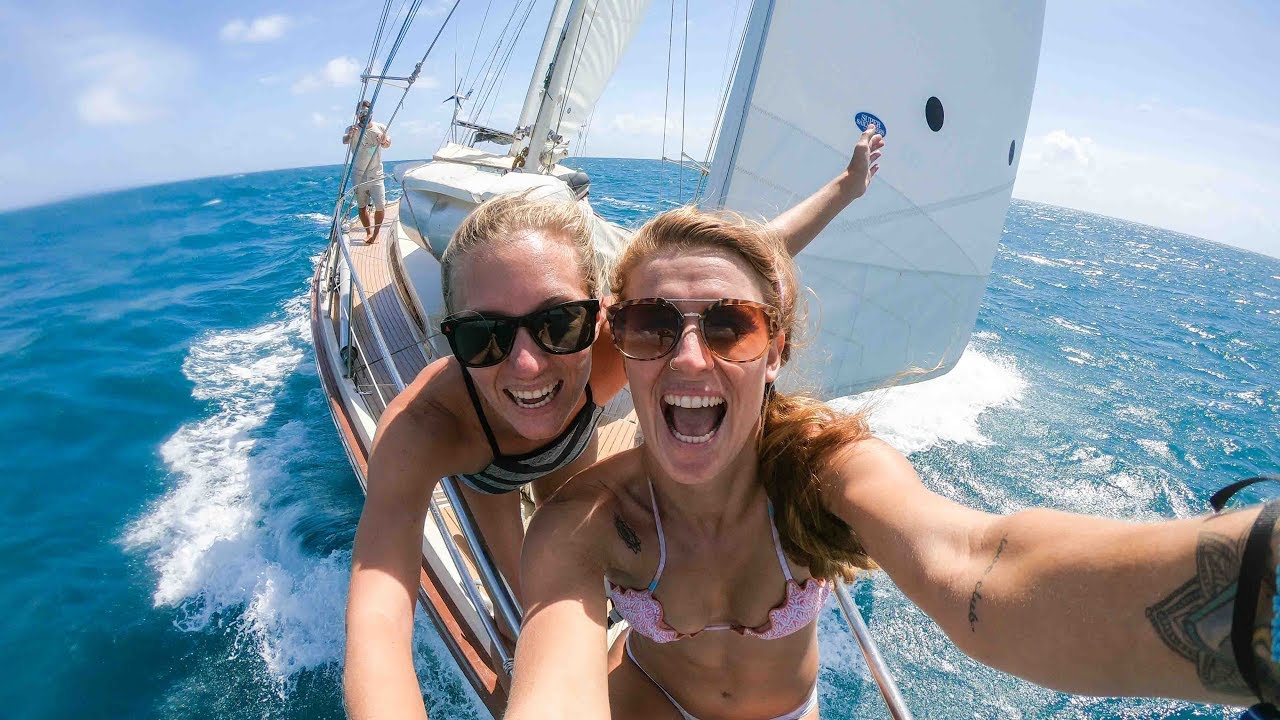

The Advantages and Challenges of Sailing Solo: Single Handed Sailboats Unveiled
Sailing solo is a remarkable feat that demands both courage and skill. It requires sailors to navigate the open seas without any crew members by their side, relying solely on their own strength, experience, and intuition. For those with a longing for adventure or a desire to test their limits, single-handed sailboats provide both advantages and challenges that can truly unveil one’s capabilities.
One of the primary advantages of sailing solo is the unmatched sense of freedom it offers. There are no compromises or limitations imposed by others; you have complete control over every aspect of your voyage. Decisions such as course alterations, speed adjustments, or route planning are made solely by you, allowing for maximum flexibility and independence. This empowering experience not only strengthens your sailing skills but also fosters personal growth and self-reliance.
In addition to freedom, solo sailing allows for an unparalleled connection with nature. The serenity of being alone on a vast expanse of water surrounded by nothing but wind and waves provides an opportunity for introspection and tranquility that few other activities can match. The sheer beauty and vastness of the ocean become your constant companion, promoting a deep sense of appreciation for the natural world.
Moreover, single-handed sailboats often boast innovative designs specifically tailored to meet the needs of solo adventurers. These vessels are equipped with advanced technologies that simplify tasks usually carried out by multiple crew members. Features such as self-steering mechanisms or automated navigation systems make handling the boat more manageable and less physically demanding.
However, despite its many advantages, sailing solo also presents unique challenges that require careful consideration. One must possess extensive knowledge of seamanship techniques as well as advanced navigational skills to handle unpredictable weather conditions or unexpected emergencies effectively. Unlike in crewed voyages where individuals share responsibilities during watch shifts, solo sailors must remain alert at all times throughout their journey—daytime or nightfall.
Loneliness can also pose severe mental challenges during extended periods at sea. The absence of companionship and the constant exposure to solitude can test even the most resilient individuals. It requires a strong sense of self-motivation and mental fortitude to overcome feelings of isolation, boredom, or homesickness. However, for some, this isolation becomes part of the appeal—an opportunity for deep reflection and personal growth.
Furthermore, physical exhaustion is an ever-present challenge for solo sailors. Without crew members to share the workload, tasks such as navigating complex waters, handling heavy sails, or anchoring become physically demanding and potentially exhausting. Stamina and physical fitness are vital attributes that must be cultivated in order to withstand the rigorous demands of solo sailing.
In conclusion, sailing solo on single-handed sailboats offers adventurers a unique experience filled with advantages and challenges that unveil one’s true mettle. The freedom to chart your own course while basking in the beauty of nature is unparalleled. However, it demands a thorough understanding of seamanship skills, mental resilience to combat loneliness, and physical endurance to conquer tiring tasks at sea. For those seeking an extraordinary voyage that tests limits both internally and externally, solo sailing is an adventure worth exploring.
Dive into the Best Single Handed Sailboat Options Available Today
Dive into the Best Single-Handed Sailboat Options Available Today
Are you a sailing enthusiast, yearning for the ultimate solo adventure on the open sea? If so, you’ll be delighted to know that there is a wide array of single-handed sailboat options available today. These boats are specifically designed to empower sailors with the ability to navigate and operate their vessel independently, providing an unmatched sense of freedom and adventure. In this blog post, we will take a closer look at some of the best single-handed sailboat options currently on the market.
First up is the renowned Laser. This iconic boat has become synonymous with single-handed sailing due to its simplicity and maneuverability. The Laser’s streamlined design allows for swift and effortless sailing, making it an ideal choice for beginners and experienced sailors alike. With its durable construction and versatile rigging options, this sailboat offers incredible performance in various weather conditions . Whether you prefer leisurely cruises or competitive racing, the Laser is undoubtedly one of the top choices for any solo sailor .
For those seeking more speed and agility on the water , consider exploring the RS Aero. This cutting-edge sailboat represents a true revolution in single-handed sailing technology. Built with lightweight materials such as carbon fiber composites, the RS Aero offers exceptional speed while maintaining optimal stability even in strong winds. Its sleek design not only enhances performance but also makes it effortless to transport or store. Designed by expert sailors who understand the thrill of sailing solo, this boat guarantees an exhilarating experience like no other.
If you’re looking for a balance between comfort and performance, look no further than the Melges 14. This stylish sailboat combines modern design elements with practical features tailored specifically for solo sailors. Its spacious cockpit provides ample room to move around while ensuring easy accessibility to all controls and rigging systems – essential for those operating alone at sea. The Melges 14 boasts impressive acceleration capabilities and responsive handling, making it an excellent option for both recreational cruising and exhilarating races .
On the more adventurous side, you may want to explore the magic of trimaran sailing with the Corsair Pulse 600. With its innovative folding features, this sailboat offers unmatched flexibility in terms of transportation and storage. Capable of reaching high speeds and exceptional stability, the Corsair Pulse 600 is perfect for those who crave excitement on their solo sailing adventures. Its lightweight construction allows for effortless single-handed operation while being well-equipped with user-friendly systems that maximize control and safety.
In conclusion, if you’re a solo sailor seeking the thrill of navigating alone on the open sea , there is a wide range of remarkable single-handed sailboat options available today. From the timeless simplicity of the Laser to the cutting-edge technology of the RS Aero and Melges 14 to the adventurous nature of trimarans like the Corsair Pulse 600 – these boats are sure to ignite your sense of adventure. So grab your gear, set sail , and let these fantastic vessels take you on extraordinary journeys filled with unforgettable moments. Happy exploring!
Recent Posts

- Sailboat Gear and Equipment
- Sailboat Lifestyle
- Sailboat Maintenance
- Sailboat Racing
- Sailboat Tips and Tricks
- Sailboat Types
- Sailing Adventures
- Sailing Destinations
- Sailing Safety
- Sailing Techniques

My Cruiser Life Magazine
What are the Best Single-Handed Sailboats and Catamarans?
Single-handed boats aren’t just limited to solo travelers. Many cruising couples will tell you that it’s a good idea to have your boat rigged and ready to be sailed single-handed. Why? What if one person gets injured—or just seasick? If your usual crew complement is only two, it makes no sense—from a safety standpoint—to require them both to be “on duty” all the time.
Of course, there are times and situations when you’ll be headed out by yourself. Maybe you like to travel but lack a consistent crew. Or many you’d just rather not bother with a crew.
The good news is that most modern cruising boats can be modified and re-rigged to improve their single-handed abilities. It all comes down to picking the right boat and making the correct modifications. Here’s a look at some of the things you’ll want to consider and five great single-handed monohull and catamaran designs.
Table of Contents
Goals for your boat, the under-rated importance of ease of single-handing, what does a single-hander need, types of autohelm, what does a single-hander want, single-handing rigging considerations, 5 great sailboats for single-handed cruisers, best single-handed sailing catamarans.
To find the perfect boat for you, whether solo or crewed sailing, is to make a list of goals and find the vessel that best meets them. There is no perfect boat. Furthermore, while you might be interested in solo sailing now, you might find yourself with a crew later on.
Start with the basics—why are you looking to single-hand your boat? Are you an adventure seeker looking to break records and find adventure with long-distance cruising? Thinking of entering a single-handed sailing race, like the Vendée Globe ?
Or are you just a solo sailor looking for a production boat that’s easy to operate by yourself? This is more common than you might imagine. Most cruising couples out there will readily admit that one member of the crew does very little to help during the actual act of sailing.
Even on two-person crews where both partners are capable, it’s often desirable for the boat to be equipped to be handled by just one person. What if one partner becomes incapacitated by seasickness—or worse, an injury? What if, even rarely, one person needs to move the boat while the other person is away?
The point is simply this—every boat that is being considered by a couple or a short-handed crew should be able to be handled by a single sailor. Whether you’re on watch while the rest of the crew sleeps or you just want to be ready for an emergency, no cruising boat should be impossible to handle alone.
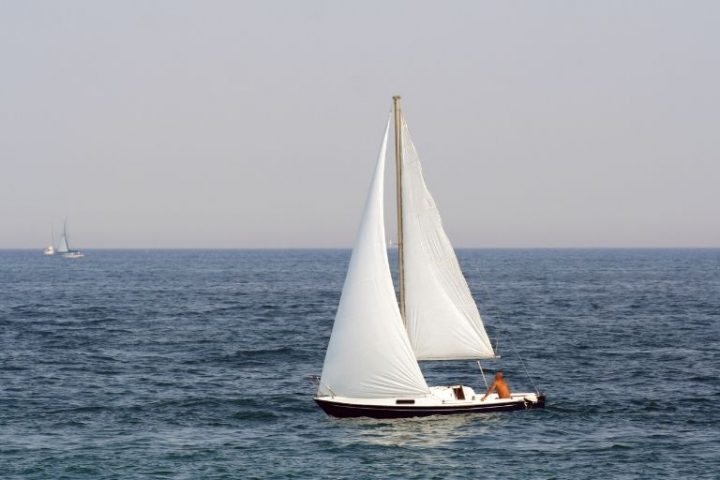
Nearly all modern cruising boats can at least be modified for easier solo handling. Here’s a look at some of the most critical gear and considerations.
The importance of each of these items will vary greatly depending on the boat, its mission, and its crew. Rigging any boat is a very personal choice. Sailors notoriously like to do things their own ways, and their boats demonstrate this character trait. The way the manufacturer or the last owner set things up is just a starting point from which you begin modifying the boat for your use.
Probably the most helpful thing to be able to single-hand is a competent hand on the helm. Thankfully, several modern and old technologies can provide solo sailors with just that.
The goal here is to allow the boat to hold a course without the operator being at the helm. Some form of “autohelm” or “autopilot” is invaluable on long passages. While it’s romantic to think of steering your ship through the dark night, in truth, it is exhausting work. An autopilot or windvane lets you relax and know that the boat will hold its course while you keep watch.
In severe weather at sea, it’s not uncommon for hand-steering crews to stand very short watches, sometimes less than an hour. This is simply due to the workload of controlling the boat in heavy weather. Some boats are more work than others, but all require more helm work when the seas are up.
This is the primary reason why the autopilot system, whatever it is, should be considered an essential part of a boat’s safety gear. A sailboat autopilot system is simply invaluable if you plan to travel far distances or do overnights on your boat.
A windvane is a purely mechanical method to controlling the boat’s heading. It has two parts—the actual windvane and then some form of steering. Many wind vanes are so well regarded as to be recognizably by brand name. Monitor and Hydrovane are probably the two most well-known models.
The windvane assembly is mounted on the transom of a vessel. The windvane itself sticks up like the rudder of an airplane, and it reacts to the wind and spins. As it spins, it uses linkages to either move the ship’s rudder or its own smaller rudder. The operator simply adjusts some small lines to select what direction the boat should be sailing from the wind. The windvane then holds that angle.
There are many advantages to these systems, and their usefulness offshore should not be underestimated. While we’re often dazzled by the digital and the new-fangled, a windvane is dead simple and offers the ultimate in reliability. It uses no battery power and requires very little input to operate. It is nothing more than metal, and short of being severely damaged or bent, there’s just not much that can go wrong with one. And one final bonus—some windvanes can be used as emergency rudders.
For all their pluses, windvanes do have some downsides. They are large and bulky, hanging off the back of the boat. And they are costly to purchase and install, too.
Electronic Autopilots
Most modern boats are equipped with at least a little bit of electronics, and autopilots are now very common. An autopilot can be described as above or below decks, depending on where the drive unit is mounted.
Regardless of the details, all autopilots work in approximately the same way. They use either a motor or hydraulic system to move some part of the boat’s rudder linkages. Some move the wheel, while others attach to an arm on the rudder shaft. Either way, the autopilot uses electronic signals to move the boat’s rudder left or right, just like moving the wheel.
Most simple autopilots are connected to an electronic compass, giving the operator a heading hold. Sailing models may also tie into the wind instruments to allow the holding of an apparent wind angle. New models that talk to the chartplotter may track navigation courses between waypoints or entire pre-planned navigation routes.
The bigger the boat, and the heavier the weather it might encounter, then the beefier an autopilot system needs to be. Autopilots can and do fail—they’re complicated electronics with a lot of moving parts. Single-handers venturing far offshore will likely want to have an entire backup unit installed or use their autopilot in concert with a manual windvane.
For boats looking to travel long distances or make overnight passages, there is no substitution for having a spare set of eyes on board. All vessels operate on the concept of “see and avoid,” meaning each captain’s responsibility to watch out for other traffic. If a single-hander is busy doing something else, like letting the autopilot drive the boat while they make their supper, who’s “on watch?”
There is only one electronic device that can be used as a second set of eyes, and that’s a good quality marine radar. All modern units allow operators to set up “guard zones.” The unit will monitor a pre-determined zone around the boat and notify you if an object is detected inside that zone.
Of course, there are other benefits to having radar on board. It can see through rain and fog. If you’re sailing solo, there’s no reason not to have a second set of eyes on board, even if they’re electronic.
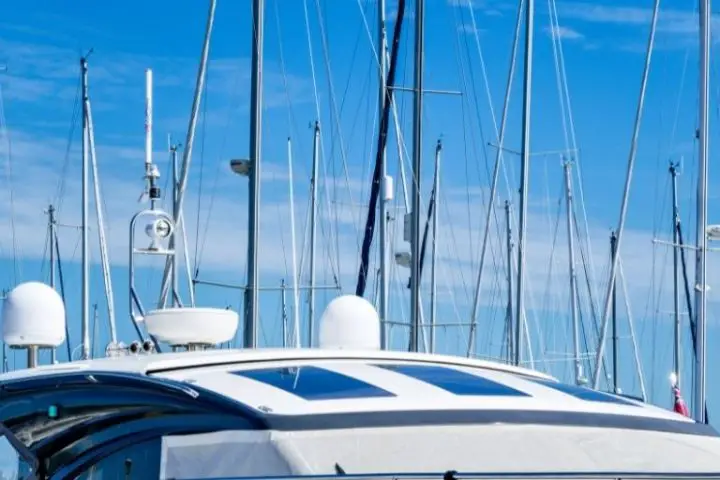
Once you’ve got a reliable autopilot and radar on board, you can move from the items you need into the items you might want. If you have an autopilot that works and you plan your actions carefully, you can likely handle any vessel without the following equipment. But these items might make it all a little more pleasant and are worth considering.
Electric Windlass and Winches
Cruising vessels that anchor regularly often have electric windlasses. These make hoisting the anchor and chain back aboard as easy as pressing a button. While manual windlasses enable you to bring up very heavy ground tackle, they take a long time to do it and require an awful lot of elbow grease.
The same applies to sailing winches on larger boats. Electric winches are complex and do take a lot of power, but they also make hoisting and handling big sails a breeze.
Line Control From the Cockpit
Pretty much every sailboat has the most crucial control lines rigged to the cockpit. Jib and main sheets are the perfect examples. But some boats go one step further, also running halyards and reefing lines to the cockpit, too.
There are plusses and minuses to this approach. Running these lines from the base of the mast aft to the cockpit increases the drag on the system, meaning it will take more effort to hoist or tighten the lines. But the security of not having to leave the cockpit if you don’t have to is worth the investment, so long as you have the rope clutches and winch power to make it all work.
Some sailors balk at the idea of running these lines aft, often citing that they’ll have to go forward if something goes wrong. But most of the time, they won’t have to. Fewer trips up on deck at sea means a safer and easier voyage all around. For the single-hander especially, the more you can do from one position, the better.
The layout of how the lines are run to the cockpit is important, too. This is often more a factor in the yacht’s design than something you can easily play with. But where applicable, a sailor will want to spend considerable time thinking about where they want to put lines and how they want to get them there.
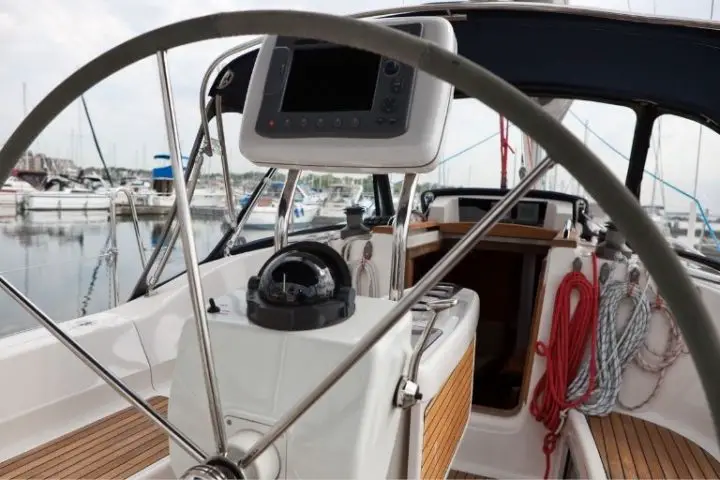
Rig Simplicity
The simpler the rig, the easier it is to sail. While nearly all production boats are sloops, the catboat has some distinct advantages here. With only one big sail to worry about, the amount of work and line handling is instantly reduced by two (or three, in the case of ketches or cutters). Catboats like the Nonsuch are known to be excellent performers and are super easy to sail. There are a few cat-rigged schooners out there, too.
There are many variations of traditional sailplans that have been played with on modern boats. Junk rigs, for example, are simple to create and very easy to sail. They’re complex in their setup and not very common on fiberglass boats, however.
If you’re looking for something easy to handle, efficient, and really wild, check out this article from Sail Magazine featuring some of the cutting-edge things found on yachts and the very interesting AeroRig.
Related: Best Trailerable Sailboats
Self-Tending Headsails
Some sloops have smaller headsails that are “self-tending.” This is another way of saying that these sails don’t need to be tacked, you can trim them like a mainsail, and you can tack the boat simply by turning the helm. That’s a considerable reduction in workload for the crew, whether they’re a single-hander or not.
Roller Furlers on Sails
Headsails can either be hanked on or rolled up on a furler. A furler means less hoisting, and you can open the sail from the cockpit. Although somewhat less common, mainsails can be furled too. Some boats have in-mast furlers. On boats with large full-batten mainsails, in-boom furlers are becoming more common.
The advantage of these systems is that they make reefing and reducing sail extremely easy. The hassle, of course, is that they have more moving parts and are expensive to install.
Cockpit Layout
The cockpit layout is about more than just the rigging. You’ll also want to take note of where and how the electronics are mounted. For example, is there a handheld VHF or do you have to go down below every time you make or answer a radio call? Are the chartplotter and radar in easy view of the helm? These are easy things to fix but worth looking at and thinking about as you set the boat up.
Easy Docking
Finally, the boat should be easy to dock single-handed. Of course, it’s always preferable to have help on the dock to get the slip safely. But this doesn’t always happen, so you should be prepared to do it yourself.
Many sailboats benefit from having a bow thruster installed, as this can help control the bow when docking in close quarters, especially in crosswind situations.
The overall size of the boat is an important factor, too. You can single hand huge yachts, which is all well and good until it comes time to dock it.
Monohulls Rigged for Easy-Operation
The good news is that you can rig nearly any boat for safe and easy single-handing. The newer the boat, the more likely it will already be set up for single-handing. Modern items like line organizers and rope clutches make it all the easier.
The boats below are exceptional in that they step away from the now ubiquitous Bermuda sloop rig. As a result, they may lose some performance abilities in some conditions, but they more than make up for it in their ease of handling.
Nonsuch 36/40
Nonsuches are distinctive boats—they are some of the only large catboats on the water today. They’re rigged with a large mainsail that is made easy to control by a wishbone boom rigging system. In effect, this makes handling a Nonsuch much like sailing a giant windsurfing board. The larger Nonsuches come from the drawing board of respected marine architect Mark Ellis.
With only one sail, the boat is straightforward to operate. First, hoist the main, and then control it with a single sheet. Tacks and jibes are easy. Reefing is as simple as letting out the halyard a little and reducing sail.
Freedom has made various interesting and straightforward rigs that contrast with the run-of-the-mill sloops found in most marinas. The number one thing you’ll notice about Freedoms is their distinctive tapered un-stayed mast. With no spreaders and no standing rigging, Freedoms look sleek from the outset.
Several models of Freedom are catboats rigged with a giant mainsail. Others, like the popular 36, are free-standing, fractionally-rigged sloops with a tiny, self-tending jib. This is the best of both worlds since the jib will provide extra power when going upwind and presents very little extra work for the crew.
Picking a catamaran for solo sailing may seem counterintuitive since they are so much larger than monohulls. But most modern catamarans are rigged from the factory for single-handed sailing. These boats are designed from the ground up for charter work—meaning that a captain will do all the work while their guests enjoy themselves. This flies in the face of the design ethos shared by most older “classic plastic” monohulls built for the club racing scene.
Most cruising catamarans are rigged with straightforward fractional sloop rigs with large, full-batten mainsails. The mains typically feature slab reefing, and the foresails are almost always mounted on furlers. Operating these boats is as simple as hoisting the main and then unrolling the jib.
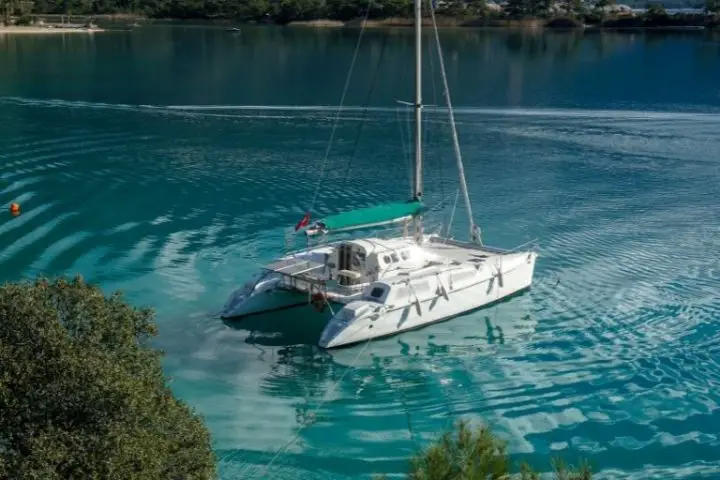
Leopard 39/40 (circa 2010)
Leopard catamarans, built by Robertson and Caine of South Africa, is the sole supplier of catamarans to The Moorings yacht charter company worldwide. But their boats are equally popular among private owners who want the catamaran lifestyle and ease of sailing.
Unlike competing brands, Leopard embraced the idea of the single-handed operator from their earliest designs. Even some of their original boats, the 38, 45, and 47 (circa 1998), had excellent walk-through helm stations with all lines led to them. As a result, you can perform every task on these boats—from hoisting the main, unfurling the jib, reefing, and even trimming the traveler—while keeping one hand on the helm.
Lagoon 39/40/42 (2015 and newer)
Lagoon is Leopard’s main competitor, but if you look at their older designs, they spent years catching up to Leopard in terms of helm positioning and single-handed operations. This changed dramatically when Lagoon introduced the 39 around 2015 and the 42 and 46 a few years later.
This new generation of Lagoons went one step better than Leopard. They have ditched the enormous and powerful mainsail in favor of a larger and self-tending jib. These boats carry their masts much farther aft than other catamarans, and the design is more similar to the Prouts of the 1990s than other modern catamarans.
But this setup makes two significant improvements. First, it reduces the power of the sometimes difficult to control mainsail. Second, it also adds self-tacking abilities to the headsail. And since most cats use furling light-wind sails for downwind and calm-day sailing, no real performance loss results.
Prout Snowgoose (circa 1987)
An older boat that is underrated these days is the Prout 37 Snowgoose. These boats featured a double headsail paired with a very small and easy to tend main. While the headsails aren’t self-tacking, they are both usually mounted on furlers. This provides a lot of sail plan options for offshore adventures. Additionally, the mast on these boats is located so far aft as to be even with the helm, meaning you can do reefing and hoisting chores without leaving the cockpit.
Matt has been boating around Florida for over 25 years in everything from small powerboats to large cruising catamarans. He currently lives aboard a 38-foot Cabo Rico sailboat with his wife Lucy and adventure dog Chelsea. Together, they cruise between winters in The Bahamas and summers in the Chesapeake Bay.

- Setting sail alone: Exploring solo dinghies and single-handed sailing
Are you ready to embark on a solo sailing adventure? Solo dinghies and single-handed sailing offer the thrill of independence and the serenity of the open water. Let's delve into this exciting world.
The thrill of independence
Sailing solo is a unique opportunity to connect with the elements, test your mettle, and savor the thrill of independence. There's no need to coordinate with a crew or compromise on your course. The decisions are yours alone, as are the triumphs.
Your ticket to freedom
A solo dinghy is the gateway to the solo sailing experience. These compact boats are designed for one person, making them the perfect vessel for those who relish solitude at sea. If you're in search of a solo dinghy for sale, you're on the path to boundless aquatic adventures.
Read our top notch articles on topics such as sailing, sailing tips and destinations in our Magazine .
Sailing single-handed: A solitary pursuit
Sailing single-handedly is a unique and solitary pursuit. It's not just about controlling the boat alone but also reveling in the quietude of the ocean. Solo sailors find solace and exhilaration as they navigate the waters with only themselves and the wind as companions.
Mastering the art: Solo dinghies and more
Solo dinghies come in various designs and sizes, catering to both beginners and experienced sailors. Whether you're a novice or a seasoned mariner, mastering the art of single-handed sailing requires skill and finesse. These boats demand precise handling, which can be both challenging and rewarding.
Optimist dinghies
The Sunfish is a classic choice for solo sailors. Its simple design and lightweight hull make it easy to handle, even for beginners. The boat's agility and responsiveness allow for enjoyable solo trips on both calm and challenging waters.
The Laser sailboat is known for its speed and maneuverability. Solo sailors appreciate its single-handed design, which includes a single sail and a simple rigging system. It's a competitive choice for racing enthusiasts.
3. Optimist dinghy
Ideal for young solo sailors, the Optimist Dinghy offers stability and ease of use. It's perfect for kids learning to sail independently, providing them with a safe and enjoyable experience.
The RS Aero is a modern and lightweight sailboat that offers exhilarating solo sailing. Its design focuses on simplicity and performance, making it a top choice for those seeking a thrilling solo adventure.
5. Solo dinghy
As the name suggests, the Solo Dinghy is purpose-built for solo sailing. Its single-handed control and comfortable cockpit design make it a fantastic choice for solo sailors looking for both performance and comfort.
6. Hobie Wave
The Hobie Wave is a catamaran that's remarkably easy to handle alone. Its stability and forgiving nature make it suitable for sailors of various skill levels, including those new to solo sailing.
For those seeking competitive solo sailing, the J/70 is a top-tier choice. Its responsive handling and speed capabilities make it an excellent option for single-handed racing.
8. Melges 14
The Melges 14 is a versatile and lightweight sailboat. It's well-suited for solo sailing thanks to its user-friendly rigging and comfortable cockpit. This boat allows sailors to fine-tune their skills with ease.
9. Catalina 22
The Catalina 22 is a larger sailboat suitable for solo sailors looking to embark on extended journeys. With its spacious cabin and straightforward handling, it provides comfort and reliability.
10. Com-Pac Eclipse
The Com-Pac Eclipse is a cruiser-racer sailboat designed for solo and shorthanded sailing. It offers a balance of performance and comfort, making it an excellent choice for solo sailors looking to explore coastal waters.
In conclusion, solo sailing is a thrilling way to connect with the sea and challenge yourself as a sailor. These ten sailboats offer a range of options for solo adventurers, from beginners to seasoned sailors. Choose the one that best suits your skill level and sailing ambitions, and set sail for unforgettable solo journeys on the open waters.
So what are you waiting for? Take a look at our range of charter boats and head to some of our favourite sailing destinations .

11 Best Single Handed Bluewater Sailboats

Sharing is caring!
We know that you’re serious about sailing when you finally think of venturing to the ocean. Who can resist dreaming of solo sailing through the Atlantic? This is an adventure to prove your advanced skills, strength, and experience.
But before going off on your ocean adventure, you need to plan and prepare . We cannot stress enough the importance of good equipment. There is a lot of sailboat types and models in the market and we want to help you choose the best one for your needs.
Do you know what hull, rigging, and keel types you will need? What’s the best material and model for you to buy?
We will guide you through important sailboat features needed for the cruise. Follow this review until the end and we will share the 11 best single-handed blue water sailboats for your solo ocean sailing!
What Size Sailboat Is Best for Single-Handed Sailing
What type of hull handles rough water the best, sailboat keel types for blue water sailing, keel or decked stepped mast, sloop or ketch, how many spreaders, cutter rig, self steering gear, furling sails, westsail 32, albin vega 27, pacific seacraft 34, canadian sailcraft 36 traditional, hallberg rassy 352, contessa 32, fast passage 39.
If you are planning to manage your boat single-handedly, then size is an important factor to consider. It can affect the size of your accommodation, and maybe the boat’s design for speed and power.
Being alone, you need to have a clear overview of what is happening on your boat. This is especially important when maneuvering or for docking operations.
Experienced sailors can handle a 60-foot sailboat but novices would find it difficult with its steep learning curve . Check out the Vendee Globe if you don’t believe me. In general, a good sailboat size for single-handed sailing would range from 25 to 40 feet.
We recommend sailboats with sizes under 40 feet. These have good displacement and are great when against bad weather. They are solo-friendly and simply the most manageable.
But in the end, choosing a suitable size depends on your experience and preference. You need to consider your overall health, age, and physique. Make sure to have a complete understanding of your sailboat before going on your journey to prevent accidents.
The hull or the main body of your boat comes in varying shapes and sizes. Each different type of hull is designed for specific purposes.
When venturing the blue waters, you need to have a hull design that could handle rough waters easily. The hull shape determines the performance of your sailboat and therefore, should align with your strengths and skills.
Today, the most popular design would be the heavy displacement hull . This design is intended for ocean cruising and longer sailing travels.
It has great stability and performs better the deeper the draft is. With this design, you would expect a slow and steady motion during your sea travels with minimal effort.
V-type hulls, on the other hand, are designed to plane or ride on top of the water. You can usually see these types of hulls on powerboats. The V-type hull usually has a bigger engine and best when dealing with choppy waters while moving at high speed.
Narrow beams are also a great option for those who are looking for another ocean friendly feature . These are usually seen in traditional sailboats.
Canoe stern or the double are considered to be the best sterns for offshore sailing. They help cut through a following sea and really helps prevent the waves from pushing the stern over too much. It also has great buoyancy and balance that is perfect for bluewater cruising.
The best materials for hulls would be fiberglass, metal, and aluminum. These are durable and could last for decades if properly maintained.
Aluminum is lightweight and has resistance to corrosion and impervious to magnetism. Boats built with aluminum are fast, stable, and seaworthy.
Fiberglass hulls need less attention. Currently, boats are usually made of fiberglass as the material is easier for companies and also great for seakeeping and stability.
Metal like steel has high abrasion resistance. It helps retain the boat’s appearance but can be prone to rust and corrosion.

A keel is a fin-like blade found at the bottom of a sailboat. It supports the ballast and helps to control and steer the boat.
It is generally designed to stop the boat from getting blown sideways because of wind pressure. The full keel, modified full keel, fin skeg, and fin spade rudder are all suited for bluewater sailing.
A full keel runs along the full length of the boat – from the bow to the stern – which makes it the most stable in the water. It carries the vessel well and is the safest to use when grounding as it reduces the chances of damage.
This is most ideal when cruising and the most comfortable out of the four keel types with its minimal heel. Although the slowest on the list, it has great directional stability and steering capability.
An improved version is the modified full keel . It is a hybrid with improved windward performance and better heel reduction than the full keel. However, it made small concessions on its stability and comfort.
Meanwhile, the fin keel with skeg rudder has more strength and protection against damage and impact. It also has better mobility and steering capability.
This type has a faster speed and windward performance compared to the modified and full keel types. It is also more balanced, which is ideal for cruiser-racer types of sailboats.
Lastly, we have the fin with a spade rudder. This is the fastest type on the list but also the most vulnerable as the spade rudder greatly relies on the rudder stock. But if you want speed and great windward performance, then this type is the right one for you.
Sailboat Rigging Types
Rigging is the whole system of ropes, chains, and cables. It supports the sailboat mast and controls the sails’ orientation and degree of reefing.
There are two main groups of sailboat rigs, Deck Stepped and Keel Stepped. The main difference lies in the location of its mast step. Both are fine choices and the better rig would depend on your preference.
Just as its names suggests, you can find the mast stand on top of the deck with Deck Stepped and on the hull’s bottom with Keel stepped. This means that to reach the keel, the mast would need to pierce through the cabin.
Deck Stepped rigs have masts that are more flexible because of their contact points, and are easily adjustable for optimal performance. Keel Stepped rig is rigid and strong and offers slow and steady cruising.
Now let’s move on and talk about Slope rigged and Ketch rigged. Which is better?
A sloop rig is simple. It is composed of a mast with a jib and a mainsail. Ketch, on the other hand, is more complex with its two masts with any foresail, main and mizzen mast combinations.
If you are choosing between Sloop and Ketch rigged sailboats for solo sailing, then we recommend Sloop. Although, Ketch is manageable and can be easily used with less strength and effort. This is perfect for cruising as it can work around multiple sailing conditions.

In terms of spreaders, you can freely choose between a single or dual spreader. This deflects shrouds and supports the mast. We do recommend dual spreaders but single spreaders are also good.
It’s just that double spreaders give the rig more strength and better sail control.
The cutter rig is sometime referred to as an inner forestay or baby stay. Simplest way of describing it is that you have two head sails instead of just one. Gives you more options on sail configurations.
Single Person Sailboat Equipment and Gear
Your sailboat would not be complete without gear and equipment. You might want to invest in autopilot or wind vane, furling headsails, electric windlass, life jackets, and AIS to make your voyage much easier.
Wind Vane is an autopilot steering that you can use without electricity. It is usually placed on the back to catch the wind and respond to various wind conditions.
It automatically adjusts the rudders in response to the wind to alter the boat’s course. This is helpful because it’s like having another crew member on board you don’t have to listen to and feed.
Headsail furling or roller reefing is necessary for easier management of your headsails. It is important to have a functioning and updated roller furling system in order to reef, dowse, or stow the headsail efficiently.
Another item we would recommend is an electric windlass . You can choose one that works vertically or horizontally, depending on your needs. This will help you move the anchor effortlessly with a single button. Using the two windlasses that god gave you makes anchoring more difficult then it needs to be.
Life jackets are a must in every sailboat. Just be sure it fits you and that you know how to use it. Also, be sure to buy a coast guard approved product with a harness that could support your weight.
The Automatic Identification System (AIS) will help you avoid collisions . It is recommended to get a receiving and transmitting one when going solo sailing.
This way, you and the other boats with AIS within the radar area are alerted to each other’s speed, course, and direction.
Really, you won’t know what you might encounter in the ocean so you must always be prepared. We hope that these items will help you achieve a safer and more secure sailing experience.
11 Best Sailboats for Solo Sailing
Now, here are 11 sailboats that are best for solo sailing. Any of these vessels are guaranteed to take you safely and comfortably anywhere around the world.

This is a long full keel fiberglass sailboat that was built from 1971 to 1981. Its design was based on a previous model, Kendall 32, and has an amazing interior size geared for comfortable cruising.
W32 is widely noted for its seaworthiness. It is built with a strong and durable design and materials to resist extreme sea conditions.
It was used on various voyages and circumnavigations. Its hull is a heavy displacement and double-ender type designed for long periods of sailing.
It is also a cutter-rigged sailboat equipped with a single mast, forestaysail, mainsail, and jib. Its overall length including the bowsprit and boomkin is roughly 40 feet, which is perfect for sailing single-handedly.
Most people would note that the speed and acceleration of W32 are quite slow. This is due to its larger wetted area and sometimes newbies’ mistake of carrying too much on board.
With the right keel, sails, and rig configurations you can improve on W32’s speed and weaknesses. As seen from David King’s documented modifications, W32 proved to be safe, steady, and fast when sailing on blue waters.

Vega 27 is a modified full keel sailboat with a masthead sloop rig. It was designed around 1966 and became the most popular production sailboat in Scandinavia.
It has a unique look because of its reverse sheer commonly seen in smaller boats to increase the area of its interior. It is made with fiberglass, but has a narrower hull compared to similar sized boats in its class.
Its shallow hull has a large cutaway as seen with modified full keel designs. This can make her quite stiff, heeling to about 15 degrees when its shoulders are buried.
Still, it is great for single-handed sailing because of its manageability and balance under different conditions. You cannot help but admire its light helm and great tracking capability.
Vega’s light air performance is okay but it shines when the wind blows at 15 knots or more. It could even maintain its dryness even with rough waves and weather conditions.
The most comforting feature would be its control and stability at all times unlike other more modern vessels with spade rudders. Overall, it is safe and ideal for longer cruises offshore.

This 30-foot traditional sailboat could take you anywhere. Alberg is notable for its narrow beams, long overhangs, and full cutaway keel with its directly attached rudder.
It is strong and durable. Its materials were mostly aluminum, hand-laid fiberglass, and polyester resin. More ballasts were produced in later productions as the early ballast was built with iron as opposed to the original lead design.
Alberg is greatly influenced by folk boats in Scandinavia. It is built with fiberglass and has an interior with comfortable full standing headroom and a well-vented galley.
This classic design from 1962 is ideal to cross oceans and is used for various circumnavigations. Alberg is a stable and seaworthy boat that could even be used in casual racing. Its best point of sail seems to be a beam reach and close reach.
It is praiseworthy when crossing oceans. Unlike modern designs that tend to be thrown around on rough seas, Alberg’s narrow beam design slices through big and rough waves and moves quickly. Under extreme weather conditions, it could perform heaving-to and lying-a-hull with no problems.
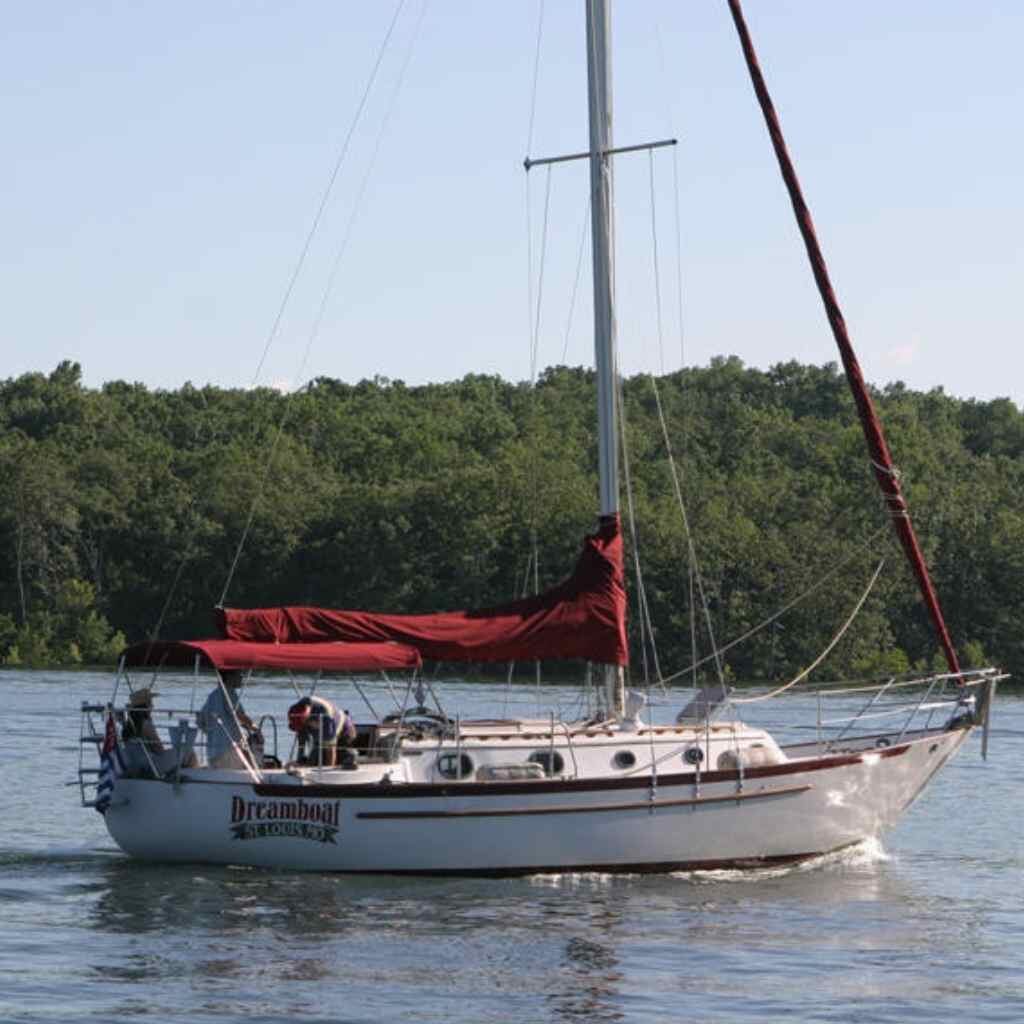
Pacific Seacraft 34 is a smaller heavy displacement semi-long keel sailboat based on the highly successful Crealock 37. It has the same graceful lines and appearance as the Crealock and is known as the Voyagemaker.
It is built with comfort and safety in mind with its large overhanging bow and beautiful sheer line ending with a traditional canoe stern. Constructed with the highest standard, it is a seaworthy sailboat that is ideal for bluewater voyages.
It is a cutter-rigged sailboat with skeg-hung rudders and control lines being fed back to its cockpit. The smaller cockpit may feel cramped but its design lowers the risk of flooding.
Still, it has a great interior suited for living aboard. It has a large headroom, comfortable galley, and up to five berths for comfortable cruising.
Although you may feel some hobby-horsing windward because of the overhangs, Seacraft 34 is overall a very balanced boat with great upwind performance. It has outstanding control capabilities and is able to sustain surfing speed with ease.

This is a double-ended full keel cruiser designed by Bob Perry and built-in Taiwan in response to the rising popularity of Westsail 32. It was offered to the market as a semi-custom boat and built with high-quality materials.
You can modify the internal layout and can choose a ketch, cutter, or pilothouse version. There is an option to use wood or aluminum spars. The mast could also be keel-stepped or deck-stepped.
Before, only 20 were ketch sailboats due to the popularity of the cutter design at that time. Now, ketch has proven to be faster and more balanced between the two.
Tayana is relatively faster than any sailboat in its class. Its best point of sail is in its broad reach. It also tracks well windward, and is an ideal choice for the trades. It is also great how the cockpit is secured from any flooding even when traveling.
Today, a lot of people are still actively sailing this. Tayana 37 has become well known for offshore and blue water sailing.

Canadian Seacraft is well known for its fiberglass racer and cruiser. CS 36 is a small traditional fin keel sailboat with a masthead sloop intended for recreational use. It is seaworthy and has good performance in different weather conditions.
It was designed by Raymond Wall and had a production run between 1978 to 1987. It remains to be popular in both north and south borders.
It is a beautiful sailboat with a graceful sheer line and balanced overhangs at both bow and stern. Its details and quality in design and production are clearly of a higher tier.
It is mostly built with fiberglass and balsa wood. It is equipped with an internally mounted spade transom hung rudder. All of its lines lead to the cockpit, which is ideal for single-handed sailing.
CS 36 Traditional also has a deep-depth draft and wide beams with great access to the cockpit and foredecks. It is wide and spacious, which is perfect for comfortable cruising.
The sailboat has great proportion and traditional aesthetics. It is simple and straightforward, which makes it ideal for bluewater sailing.

This is a sturdy and high-quality sailboat built between 1978 to 1991. It features a progressive design, combining a walk through with the aft-cabin from the main saloon. It is made with a tall and standard rig each supported on double and single spreaders, respectively.
Hallberg Rassy 352 has a nicely balanced hull sporting a fin keel with rudder on skeg, a generous beam, and a 45 percent high ballast ratio. Its water and fuel tanks are placed low in the keel to improve sail carrying ability.
Its production spanning 14 years allowed for continuous improvements in its specifications. Newer sailboats have raised hulls for bigger headroom in the under the deck, aft cabins, and the walkthrough. Engines were also replaced by a Volvo and later a Penta Turbo or the bigger MD 22.
It is impressive how they balanced good interior and sailing performance. It has great seakeeping ability and smooth motion in heavy seas, easily an ideal sailboat for singlehanded sailing.

Corbin 39 was designed based on a Dufour design named Harmonie, increasing freeboard, and flushing the deck. Its style is influenced by the classic Scandinavian cruiser, Westsail 32.
It has a long fin keel, blunt bow, and a high freeboard. It was sold as kits, and various deck molds were produced. They have pilot, aft, and center cockpit variations.
It was made of sturdy and high-quality materials. The earlier version’s decks were of marine grade mahogany but it was later changed with Airex foam. Its lead ballast was encapsulated with fiberglass for added protection.
Earlier boats had a single spreader main or a turbocharged double spreader. Later, Corbin used 49 feet double spreader rigs instead, and all were deck-stepped.
Corbin 39 is truly a strong and seaworthy vessel. With its fin keel and skeg rudder, cutter rig, and reefed main combinations, it could take anyone safely and comfortably anywhere in the world.

Valiant 40 took its looks from Scandinavian double-ender sailboats. It had a successful production run that spanned for 47 years. It proved to be one of the pioneers for modern blue water designs.
Its hull is made from thick hand-laid fiberglass, bolted and covered with teak. Its ballast is cast with lead bolted to the keel stub. Lastly, the skeg is constructed separately from hull molding and encased with fiberglass before being fastened to the hull.
It has a beautiful bow and sheer lines and a longer LWL for maximum speed. At the back are a non-spacious cockpit and a canoe stern ideal for bluewater sailing operations.
Under the waterline is a fin keel with its skeg hung rudder. It perfectly matches with the cruising hall above, minimizing wetted surface area
Overall, Valiant 40 is a seaworthy vessel with great blue water performance. Extremely balanced and well-mannered, it can withstand extreme weather conditions with ease and minimal effort on your part.
It soon gained a reputation as a fast water passage-maker with high integrity. Now, it is regularly used for circumnavigations by solo sailors and voyagers.

If you like a sailboat with a proven track record, then Contessa 32 is for you. It is a seaworthy racer-cruiser with good all-around sailing capabilities released in 1971.
Like its younger sister, Contessa 26, it has great speed, integrity, and affordability . Contessa 32 is a definite combination of old and new with its traditional narrow beam, a full hull with a fin keel, and fiberglass rudder protected by a skeg found in more modern yachts.
It has marked overhangs and a narrow tuck-up stern. It has less headroom below in return for its lesser wind resistance.
This configuration delivers fast racing speed and great stability. It could definitely withstand extreme weather and rough waves. Contessa 32 is claimed to be able to right itself when rolled or capsized.
Contessa 32 is known for its forgiving nature. It has a responsive helm and excellent windward performance. With its astounding stability, it can carry full sail for up to 25 knots.

Fast Passage 39 was designed by William Garden and is said to be a legendary cruiser with speed, ruggedness, and fame. It is a stout double-ender comparable to the Valiant 40.
It has the same LOA and LWL as Valiant and also has nearly identical ballast and displacement. The difference is its narrower frame and more evolved underwater shapes resulting in flatter forward and aft keel sections and less wetted area. It also has great directional stability as its rudder allows great control under wind vane and down steep waves.
It is a high performing sailboat but also difficult to find as only 41 were produced. A part of the group was offered as hull and deck kits intended to be finished by the sailboat owners.
Fast Passage 39 also has a proven track record and has won single-handed blue water races. It performs great under a wide range of conditions, especially in light winds.
By now you should have some idea what makes a vessel Bluewater friendly. There are hundreds of vessels that can make long distance voyage safe and enjoyable. These examples above are just a few examples of the Best Single Handed BlueWater Sailboats.
Leave a Comment Cancel Reply
Your email address will not be published. Required fields are marked *
Save my name, email, and website in this browser for the next time I comment.
Get your "Sailing and Boating" Free Guide
- BOAT OF THE YEAR
- Newsletters
- Sailboat Reviews
- Boating Safety
- Sailing Totem
- Charter Resources
- Destinations
- Galley Recipes
- Living Aboard
- Sails and Rigging
- Maintenance

20 Best Small Sailboats for the Weekender
- By Mark Pillsbury
- Updated: August 4, 2021
In order to go cruising, most of us require a sailboat with a head, a galley, and bunks. The boat, likely a 30-footer and more often a 40-footer, will have electronics for navigation and entertainment, refrigeration if the trip is longer than a coastal hop, an engine for light wind, and, depending on our appetites for food and fun, perhaps a genset to power our toys and appliances.
To go sailing , however, all we really need is a hull, mast, rudder, and sail. To experience the pure joy of sheeting in and scooting off across a lake, bay, or even the open ocean, there’s nothing better than a small sailboat – we’re talking sailboats under 25 feet. You can literally reach out and touch the water as it flows past. You instantly feel every puff of breeze and sense every change in trim.
Some of the boats in this list are new designs, others are time-tested models from small sailboat manufacturers, but every one is easy to rig, simple to sail, and looks like a whole lot of fun either for a solo outing on a breezy afternoon or to keep family and friends entertained throughout your entire sailing season. This list is made up of all types of sailboats , and if you’re looking for a list of some of the best small sailboats for beginners, you’ll find exactly that here.
Any one of these popular boats could be labeled as a trailerable sailboat, daysailer, or even a weekender sailboat. And while most would be labeled as a one or two person sailboat, some could comfortably fit three or even four people.
Marblehead 22 Daysailer
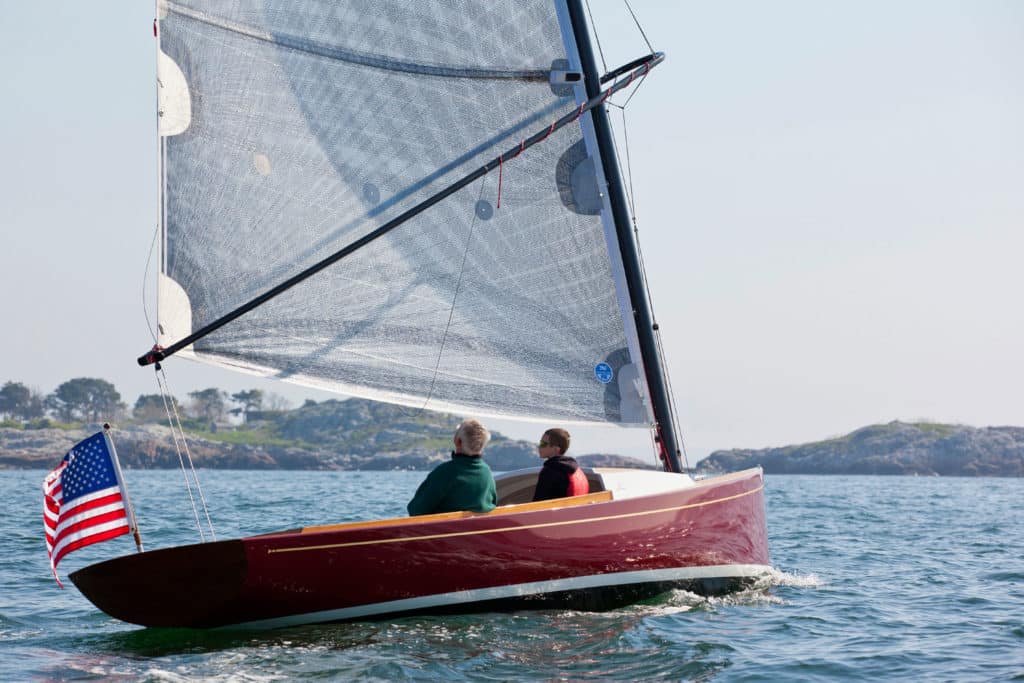
If you have an eye for elegant lines and your heart goes pitter-patter over just the right amount of overhang beneath a counter transom, the Marblehead 22 daysailer, designed by Doug Zurn and built by Samoset Boatworks in Boothbay, Maine, will definitely raise your pulse. Traditional-looking above the waterline and modern beneath, the cold-molded hull sports a deep bulb keel and a Hall Spars carbon-fiber mast with a wishbone rig and square-top main. The 11-foot-9-inch cockpit can seat a crowd, and a small cuddy forward will let you stow your friends’ gear for the day. samosetboatworks.com
Catalina 22 Sport
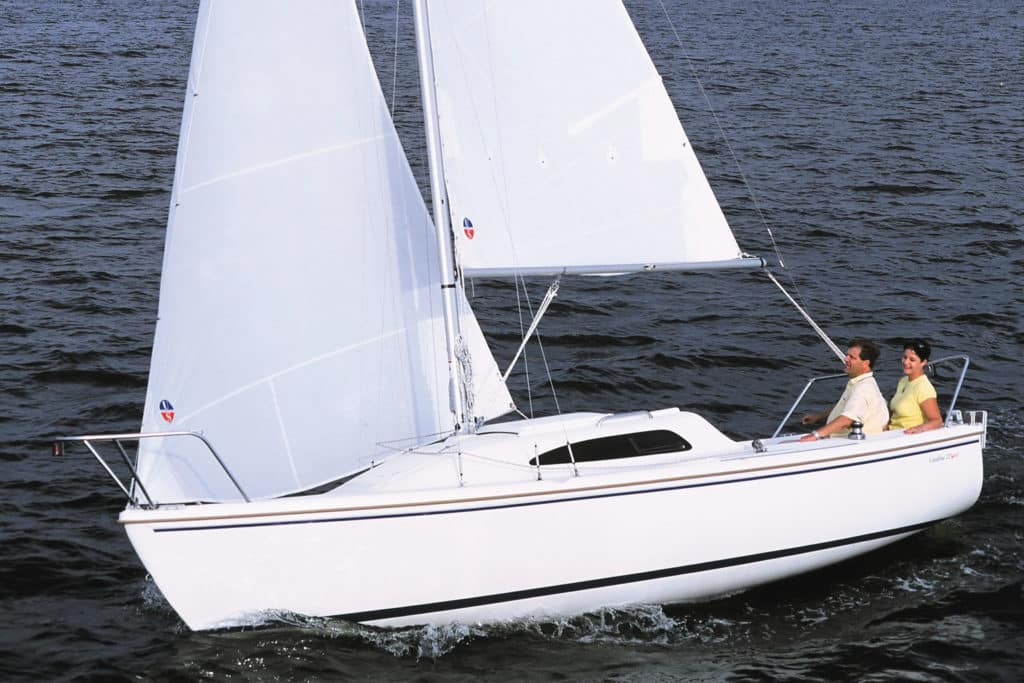
Many a harbor plays host to an active fleet of Catalina 22s, one of the most popular small sailboats over the years, given its basic amenities and retractable keel, which allows it to be easily trailered. Recently, the company introduced the Catalina 22 Sport, an updated design that can compete with the older 22s. The boat features a retractable lead keel; a cabin that can sleep four, with a forward hatch for ventilation; and a fractional rig with a mainsail and a roller-furling jib. Lifelines, a swim ladder, and an engine are options, as are cloth cushions; vinyl cushions are standard. The large cockpit will seat a crowd or let a mom-and-pop crew stretch out and enjoy their sail. It’s clear why the Catalina 22 is one of the best sailboats under 25 feet. catalinayachts.com
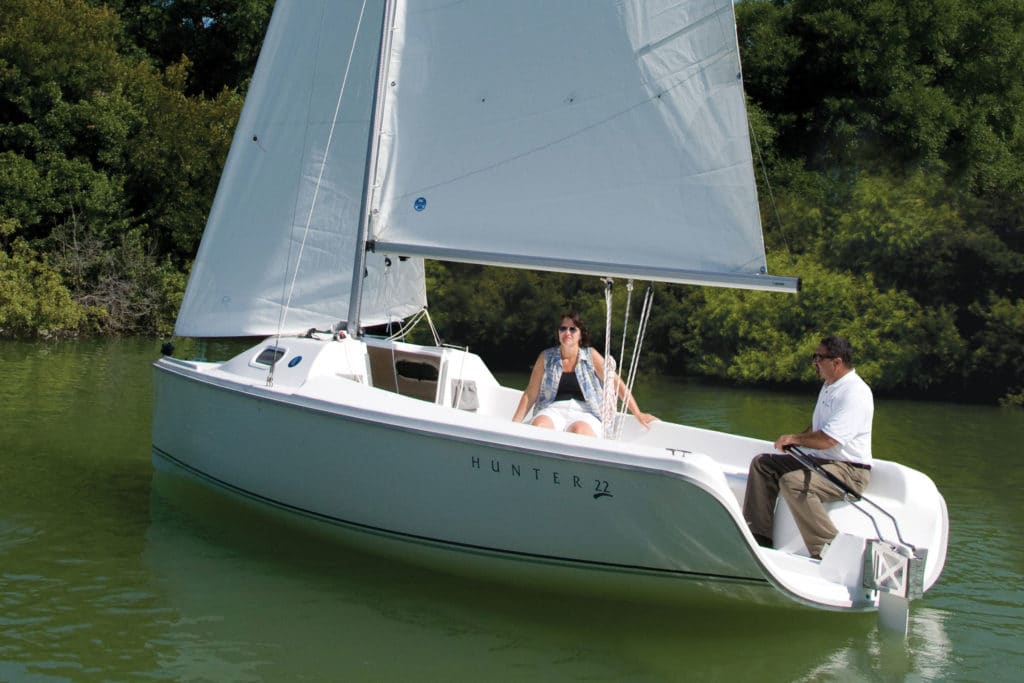
With its large, open-transom cockpit and sloop rig, the Hunter 22 makes a comfortable daysailer for family and friends. But with its cuddy cabin, twin bunks, optional electrical system, opening screened ports, and portable toilet, a parent and child or a couple could comfortably slip away for an overnight or weekend. Add in the optional performance package, which includes an asymmetric spinnaker, a pole, and a mainsheet traveler, and you could be off to the races. The boat features a laminated fiberglass hull and deck, molded-in nonskid, and a hydraulic lifting centerboard. Mount a small outboard on the stern bracket, and you’re set to go. marlow-hunter.com
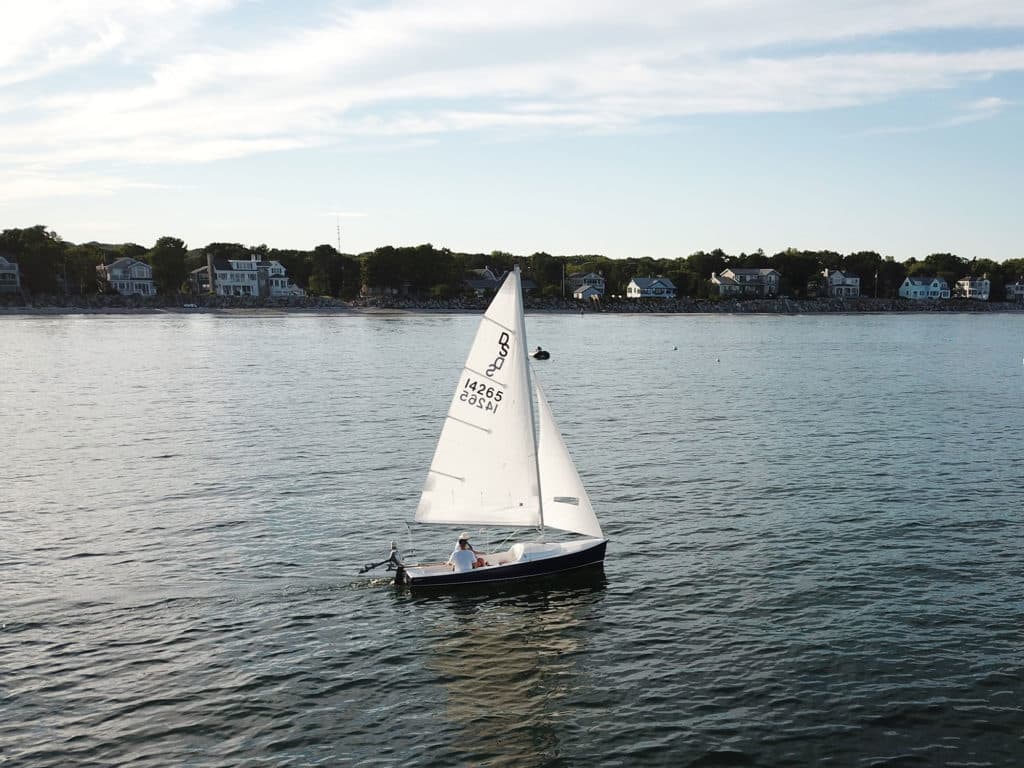
Not sure whether you want to race, cruise or just go out for an afternoon sail? Since 1958, sailors have been having a ball aboard the Uffa Fox/George O’Day-designed Daysailer. Fox, who in the 1950s was on the cutting edge of planning-dinghy design, collaborated with Fall River, Massachusetts boatbuilder O’Day Corp. to build the 16-foot Daysailer, a boat that features a slippery hull and a small cuddy cabin that covers the boat roughly from the mast forward. Thousands of Daysailers were built by various builders, and they can be found used for quite affordable prices. There are active racing fleets around the US, and new Daysailers are still in production today, built by Cape Cod Ship Building. capecodshipbuilding.com
BayRaider from Swallow Boats
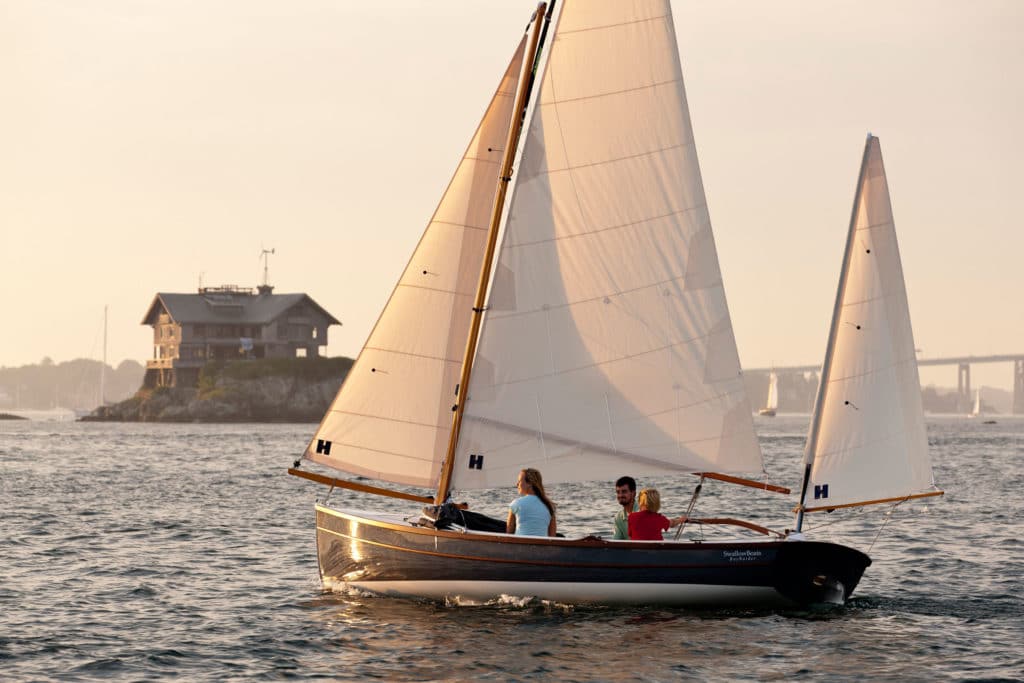
Easy to rig and trailer, the BayRaider from England’s Swallow Yachts is a relative newcomer to the small-boat market in the United States. Nearly all of its 19 feet 9 inches is open cockpit, though a spray hood can be added to keep the forward sections dry. The BayRaider is ketch-rigged with a gunter-style mainmast. The topmast and mizzen are both carbon-fiber, which is an option for the mainmast as well. The BayRaider can be sailed with a dry hull in lighter conditions or with 300 pounds of water ballast to increase its stability. With the centerboard and hinged rudder raised, the boat can maneuver in even the thinnest water.
$28,900, (904) 234-8779, swallowyachts.com
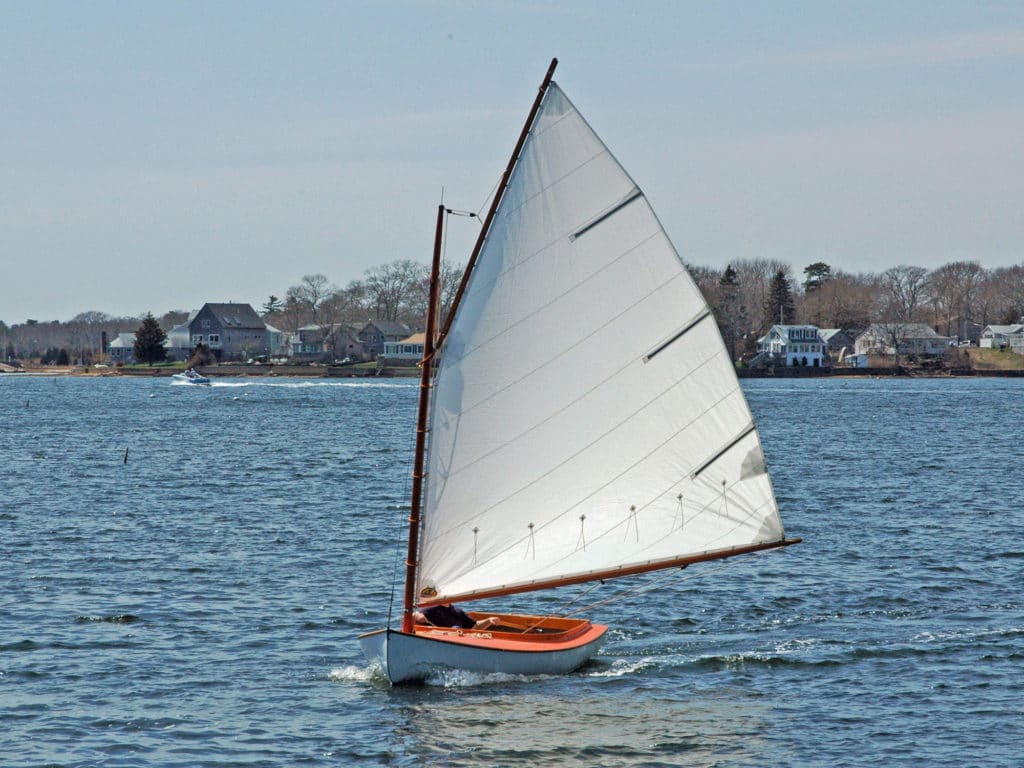
Big fun can come in small packages, especially if your vessel of choice happens to be the 12 ½-foot Beetle Cat. Designed by John Beetle and first built in 1921, the wooden shallow draft sailboat is still in production today in Wareham, Massachusetts at the Beetle Boat Shop. With a draft of just 2 feet, the boat is well-suited for shallow bays, but equally at home in open coastal waters. The single gaff-rigged sail provides plenty of power in light air and can be quickly reefed down to handle a blow. In a word, sailing a Beetle Cat is fun. beetlecat.com
West Wight Potter P 19
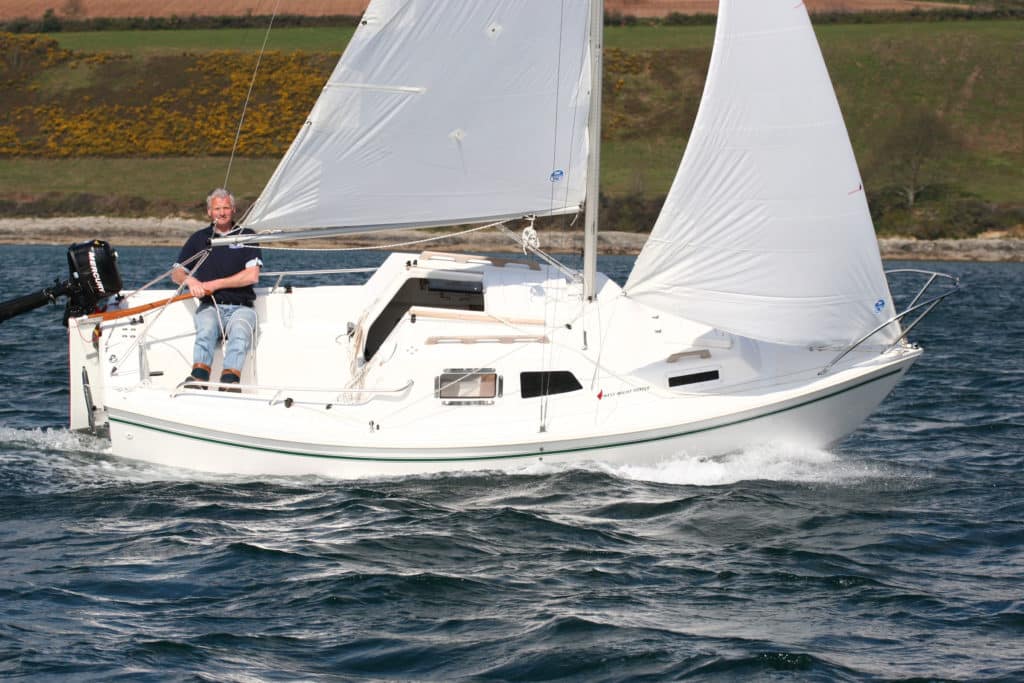
With berths for four and a workable galley featuring a cooler, a sink, and a stove, West Wight Potter has packed a lot into its 19-foot-long P 19. First launched in 1971, this is a line of boats that’s attracted a true following among trailer-sailors. The P 19′s fully retractable keel means that you can pull up just about anywhere and go exploring. Closed-cell foam fore and aft makes the boat unsinkable, and thanks to its hard chine, the boat is reportedly quite stable under way. westwightpotter.com
NorseBoat 17.5
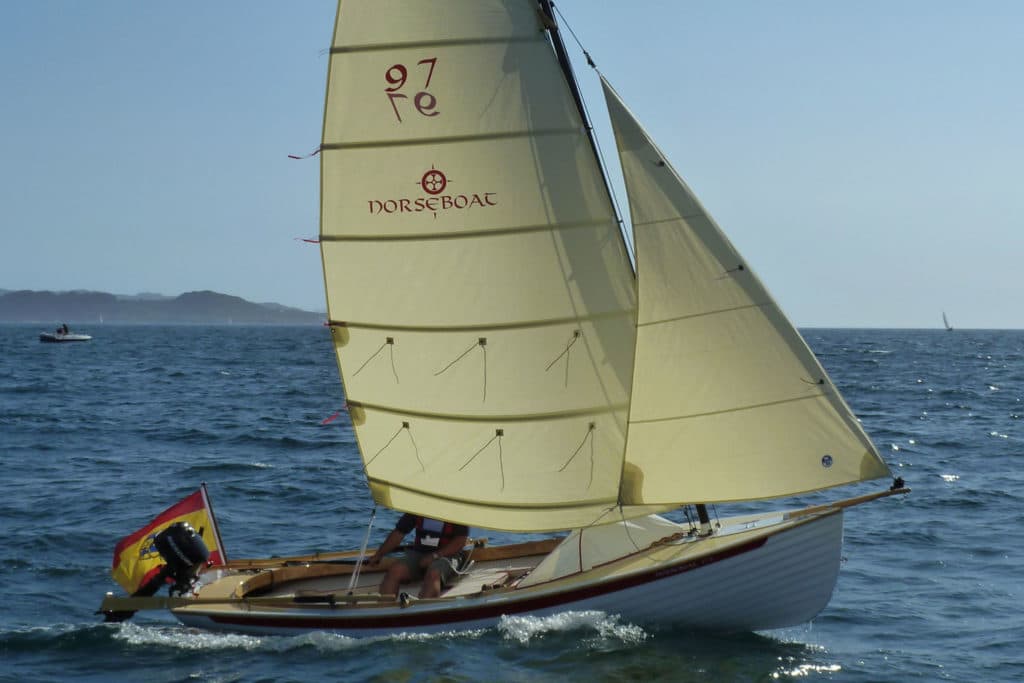
Designed for rowing and sailing (a motor mount is optional), the Canadian-built NorseBoat 17.5—one of which was spotted by a CW editor making its way through the Northwest Passage with a two-man crew—features an open cockpit, a carbon-fiber mast, and a curved-gaff rig, with an optional furling headsail set on a sprit. The lapstrake hull is fiberglass; the interior is ply and epoxy. The boat comes standard with two rowing stations and one set of 9-foot oars. The boat is designed with positive flotation and offers good load-carrying capacity, which you could put to use if you added the available canvas work and camping tent. NorseBoats offers a smaller sibling, the 12.5, as well; both are available in kit form.
$19,000, (902) 659-2790, norseboat.com
Montgomery 17
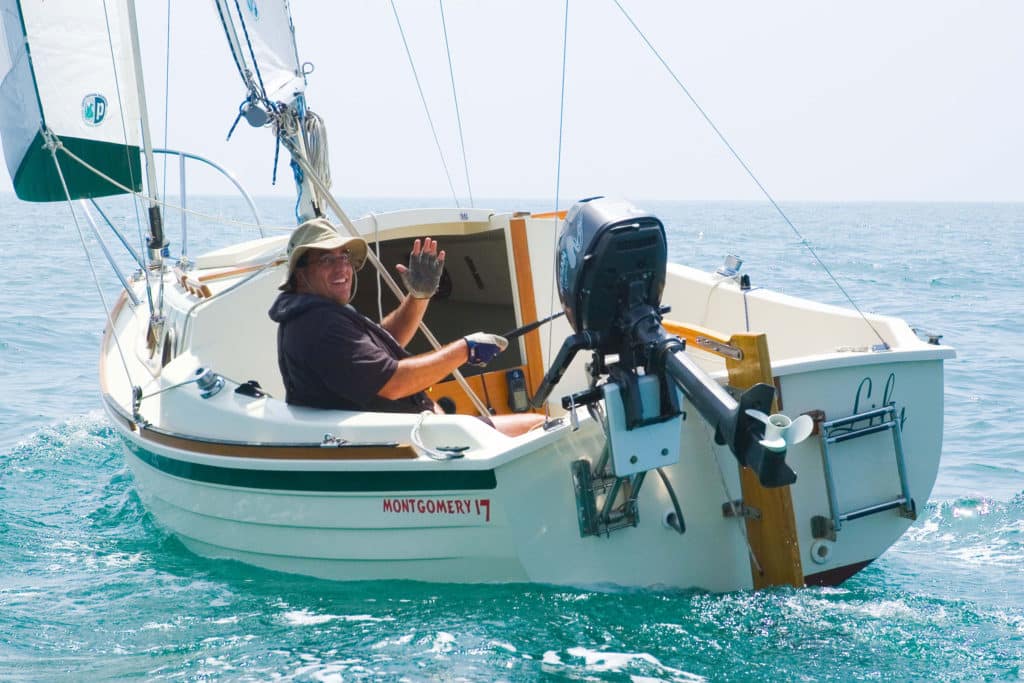
Billed as a trailerable pocket cruiser, the Montgomery 17 is a stout-looking sloop designed by Lyle Hess and built out of fiberglass in Ontario, California, by Montgomery Boats. With a keel and centerboard, the boat draws just under 2 feet with the board up and can be easily beached when you’re gunkholing. In the cuddy cabin you’ll find sitting headroom, a pair of bunks, a portable toilet, optional shore and DC power, and an impressive amount of storage space. The deck-stepped mast can be easily raised using a four-part tackle. The builder reports taking his own boat on trips across the Golfo de California and on visits to California’s coastal islands. Montgomery makes 15-foot and 23-foot models, as well. If you’re in search of a small sailboat with a cabin, the Montgomery 17 has to be on your wish list.
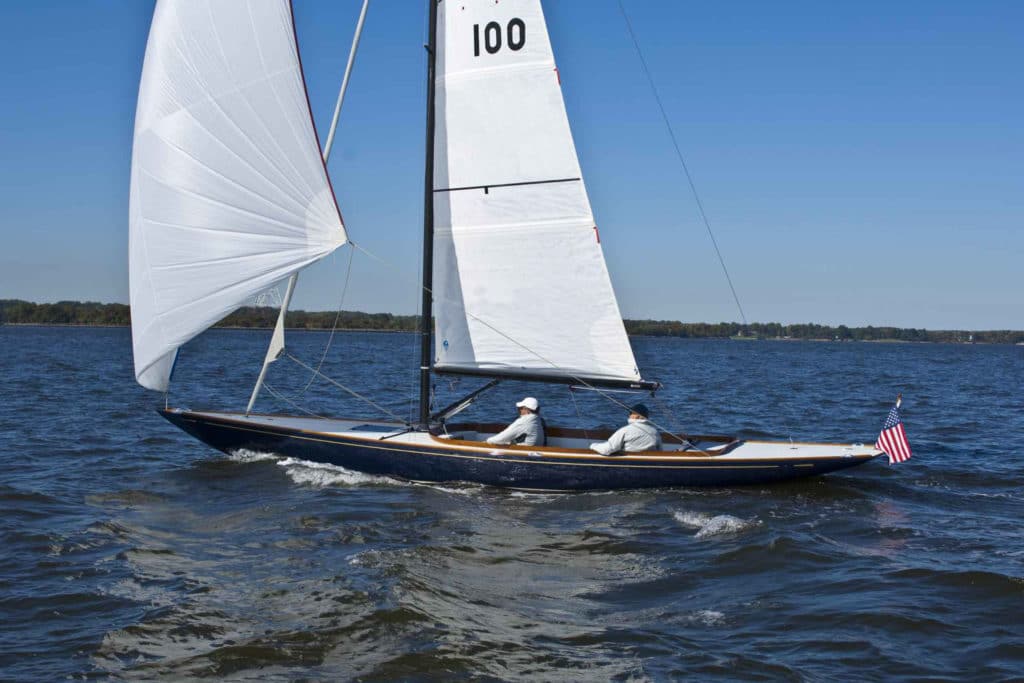
With long overhangs and shiny brightwork, the CW Hood 32 is on the larger end of the daysailer spectrum. Designers Chris Hood and Ben Stoddard made a conscious decision to forego a cabin and head in favor of an open cockpit big enough to bring 4 or 5 friends or family out for an afternoon on the water. The CW Hood 32 is sleek and graceful through the water and quick enough to do some racing, but keeps things simple with a self-tacking jib and controls that can be lead back to a single-handed skipper. A top-furling asymmetrical, electric sail drive and Torqeedo outboard are all optional. The CW Hood 32 makes for a great small family sailboat. cwhoodyachts.com
Sun Cat from Com-Pac
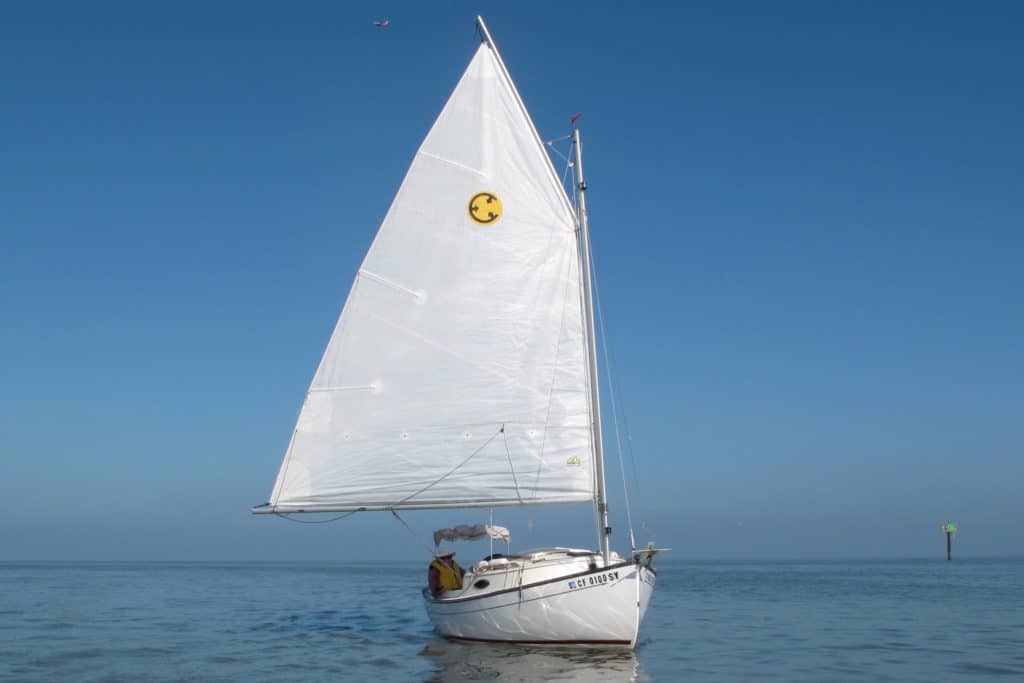
Shallow U.S. East Coast bays and rock-strewn coasts have long been graced by cat boats, whose large, gaff-rigged mainsails proved simple and powerful both on the wind and, better yet, when reaching and running. The 17-foot-4-inch Sun Cat, built by Com-Pac Yachts, updates the classic wooden cat with its fiberglass hull and deck and the easy-to-step Mastender Rigging System, which incorporates a hinged tabernacle to make stepping the mast a one-person job. If you want a personal sailboat ideal for solo sailing, the Sun Can is a great choice. Belowdecks, the twin 6-foot-5-inch berths and many other features and amenities make this cat a willing weekender.
$19,800, (727) 443-4408, com-pacyachts.com
Catalina 16.5
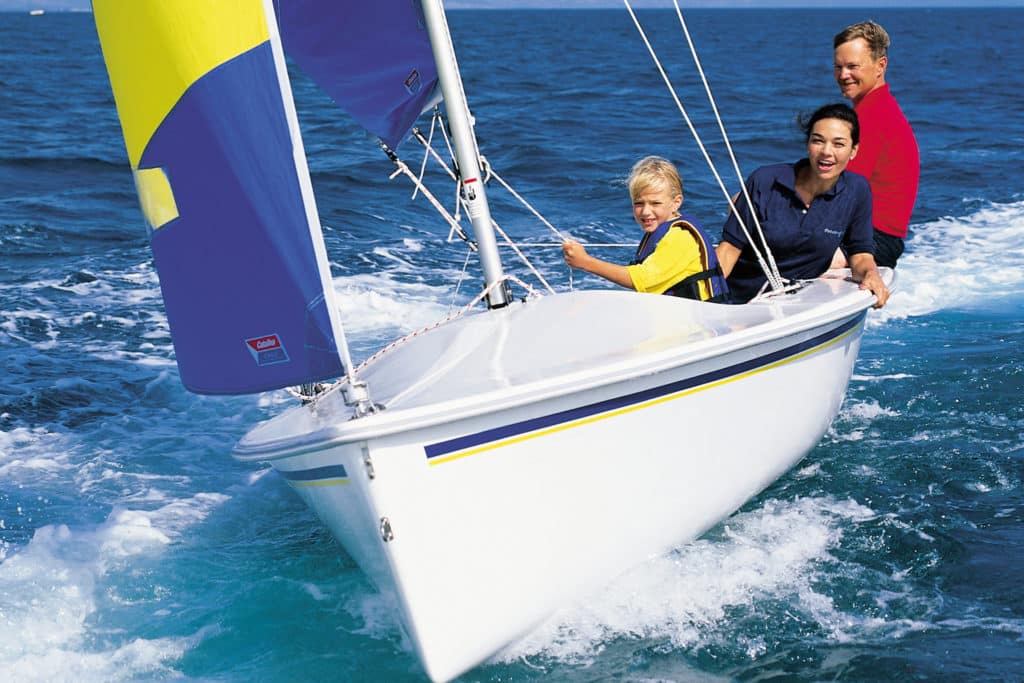
The Catalina 16.5 sits right in the middle of Catalina Yachts’ line of small sailboats, which range from the 12.5 to the 22 Capri and Sport, and it comes in both an easy-to-trailer centerboard model and a shoal-draft fixed-keel configuration. With the fiberglass board up, the 17-foot-2-inch boat draws just 5 inches of water; with the board down, the 4-foot-5-inch draft suggests good windward performance. Hull and deck are hand-laminated fiberglass. The roomy cockpit is self-bailing, and the bow harbors a good-sized storage area with a waterproof hatch. catalinayachts.com
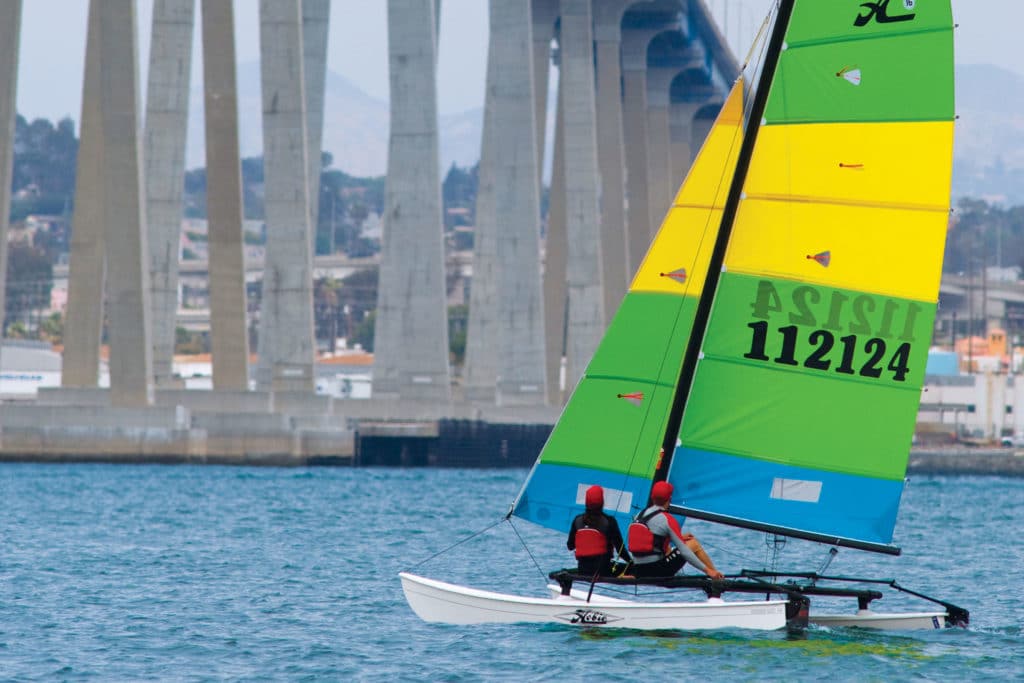
No roundup of best small sailboats (trailerable and fun too) would be complete without a mention of the venerable Hobie 16, which made its debut in Southern California way back in 1969. The company has introduced many other multihulls since, but more than 100,000 of the 16s have been launched, a remarkable figure. The Hobie’s asymmetric fiberglass-and-foam hulls eliminate the need for daggerboards, and with its kick-up rudders, the 16 can be sailed right up to the beach. Its large trampoline offers lots of space to move about or a good place to plant one’s feet when hanging off the double trapezes with a hull flying. The boat comes with a main and a jib; a spinnaker, douse kit, trailer, and beach dolly are optional features. hobiecat.com
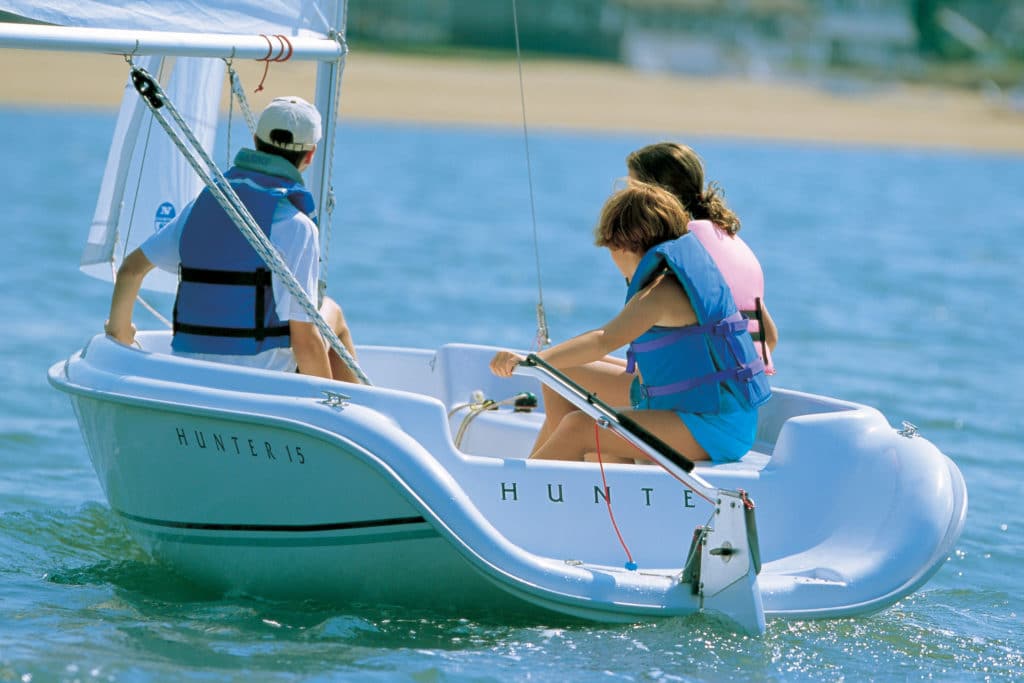
Novice sailors or old salts looking for simplicity could both enjoy sailing the Hunter 15. With a fiberglass hull and deck and foam flotation, the boat is sturdily built. The ample freeboard and wide beam provide stability under way, and the heavy-duty rubrail and kick-up rudder mean that you won’t have to worry when the dock looms or the going grows shallow. Both the 15 and its slightly larger 18-foot sibling come standard with roller-furling jibs.
$6,900/$9,500 (boat-show prices for the 15 and 18 includes trailers), (386) 462-3077, marlow-hunter.com
Super Snark
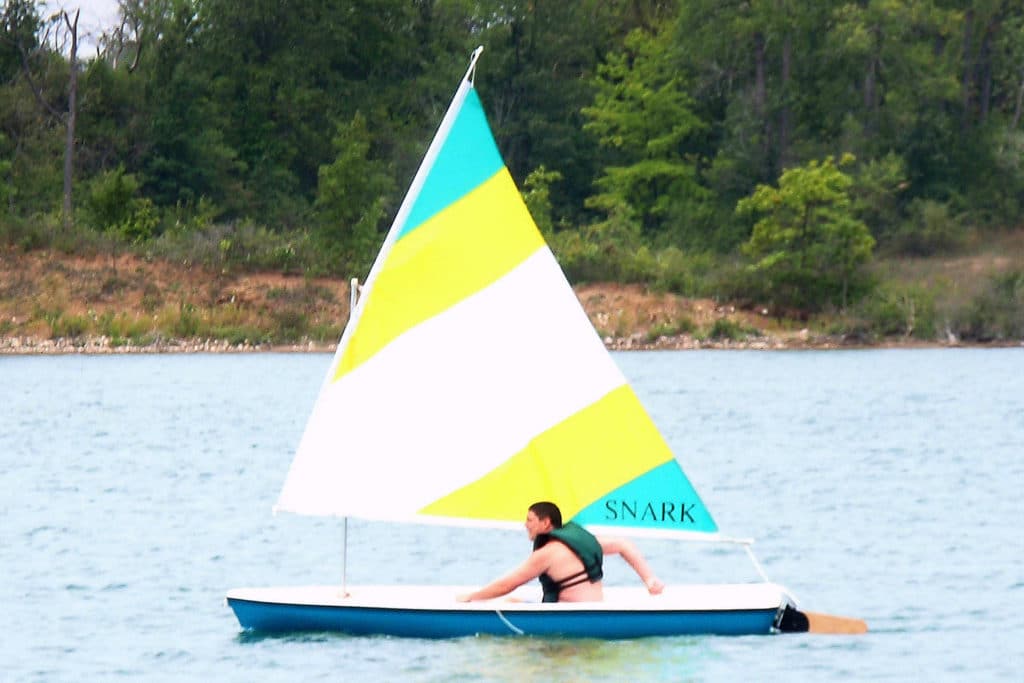
Under various owners, the Snark brand of sailboats, now built by Meyers Boat Co., has been around since the early 1970s. The Super Snark, at 11 feet, is a simple, easily car-topped daysailer that’s fit out with a lateen rig and sail. Billed as unsinkable, the five boats in the company’s line are built with E.P.S. foam, with the external hull and deck vacuum-formed to the core using an A.B.S. polymer. The Super Snark weighs in at 50 pounds, and with a payload capacity of 310 pounds, the boat can carry two.
$970, (800) 247-6275, meyersboat.com
Norseboat 21.5
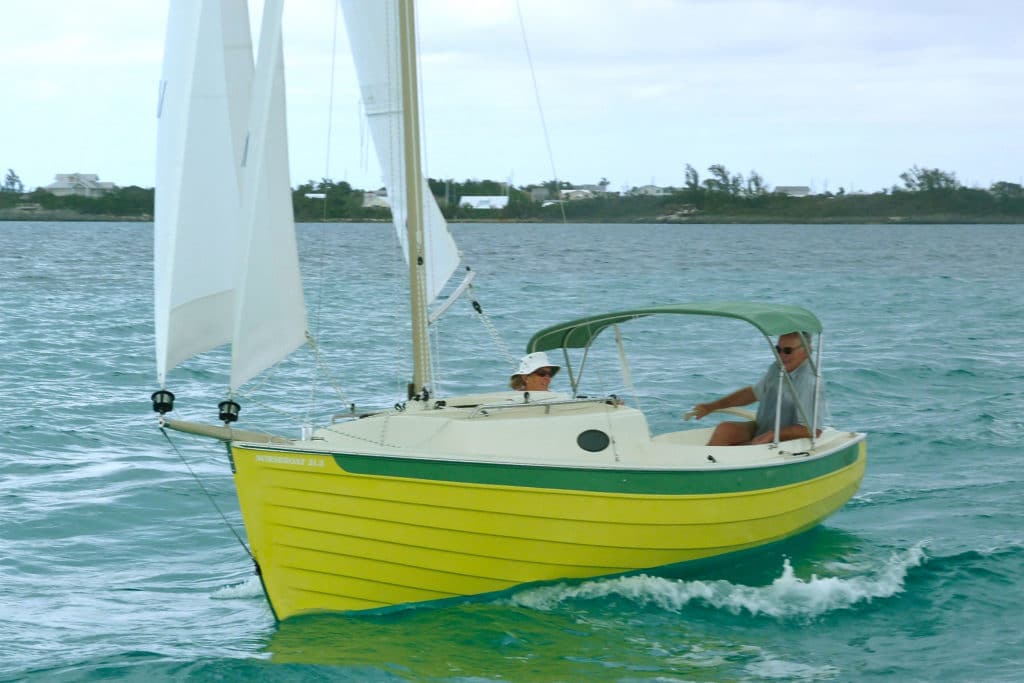
Built in Canada, the NorseBoat 21.5 is a rugged looking craft that comes in a couple of configurations: one with an open cockpit and small doghouse, and another with a smaller cockpit and cabin that houses a double berth for two adults and optional quarter berths for the kids. Both carry NorseBoat’s distinctive looking carbon fiber gaff-rigged mast with main and jib (a sprit-set drifter is optional), and come with a ballasted stub keel and centerboard. Because of its lightweight design, the boat can be rowed and is easily trailered.
$36,000 (starting), 902-659-2790, norseboat.com
Flying Scot
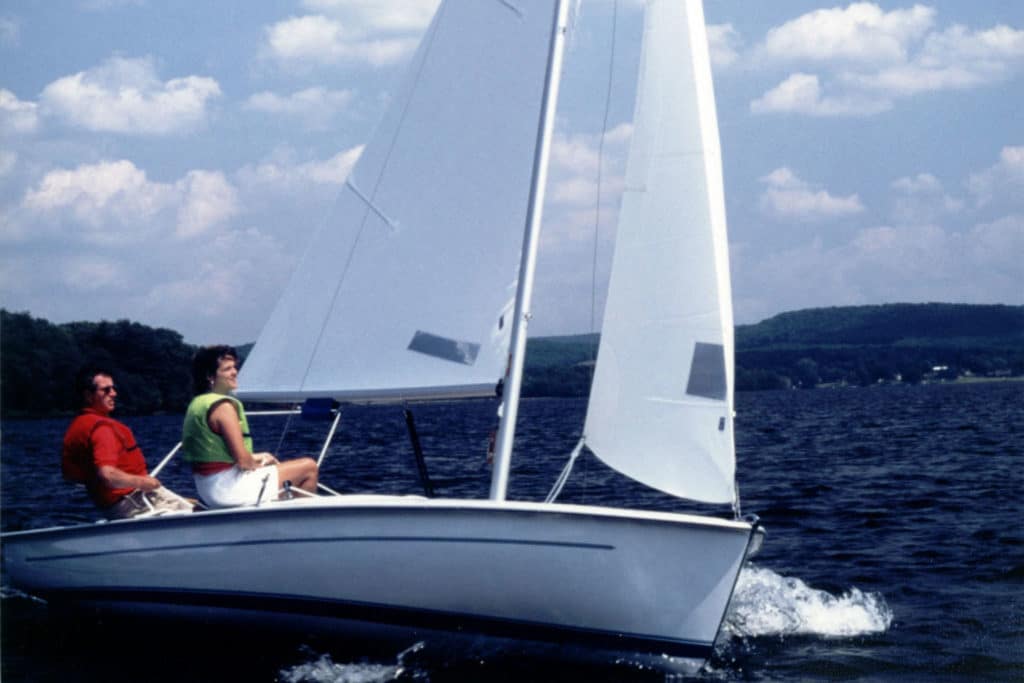
Talk about time-tested, the 19-foot Flying Scot has been in production since 1957 and remains a popular design today. Sloop rigged, with a conventional spinnaker for downwind work, the boat is an easily sailed family boat as well as a competitive racer, with over 130 racing fleets across the U.S. Its roomy cockpit can seat six to eight, though the boat is often sailed by a pair or solo. Hull and deck are a fiberglass and balsa core sandwich. With the centerboard up, the boat draws only eight inches. Though intended to be a daysailer, owners have rigged boom tents and berths for overnight trips, and one adventurous Scot sailor cruised his along inland waterways from Philadelphia to New Orleans.
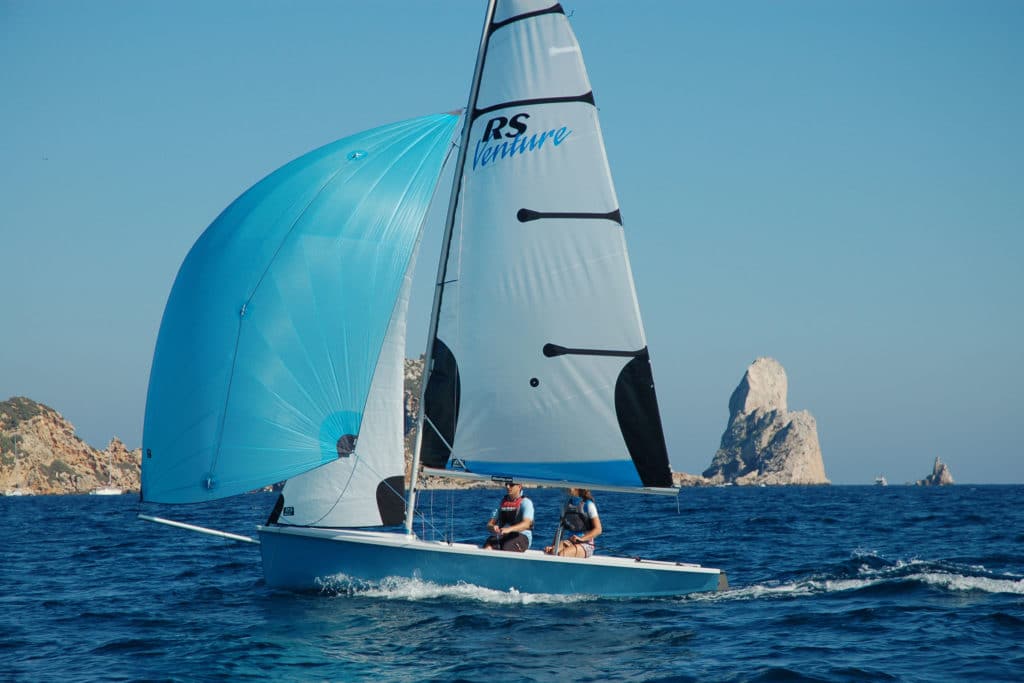
Known primarily for its line of racing dinghys, RS Sailing also builds the 16-foot, 4-inch Venture, which it describes as a cruising and training dinghy. The Venture features a large, self-draining cockpit that will accommodate a family or pack of kids. A furling jib and mainsail with slab reefing come standard with the boat; a gennaker and trapeze kit are options, as is an outboard motor mount and transom swim ladder. The deck and hull are laid up in a fiberglass and Coremat sandwich. The Venture’s designed to be both a good performer under sail, but also stable, making it a good boat for those learning the sport.
$14,900, 203-259-7808, rssailing.com
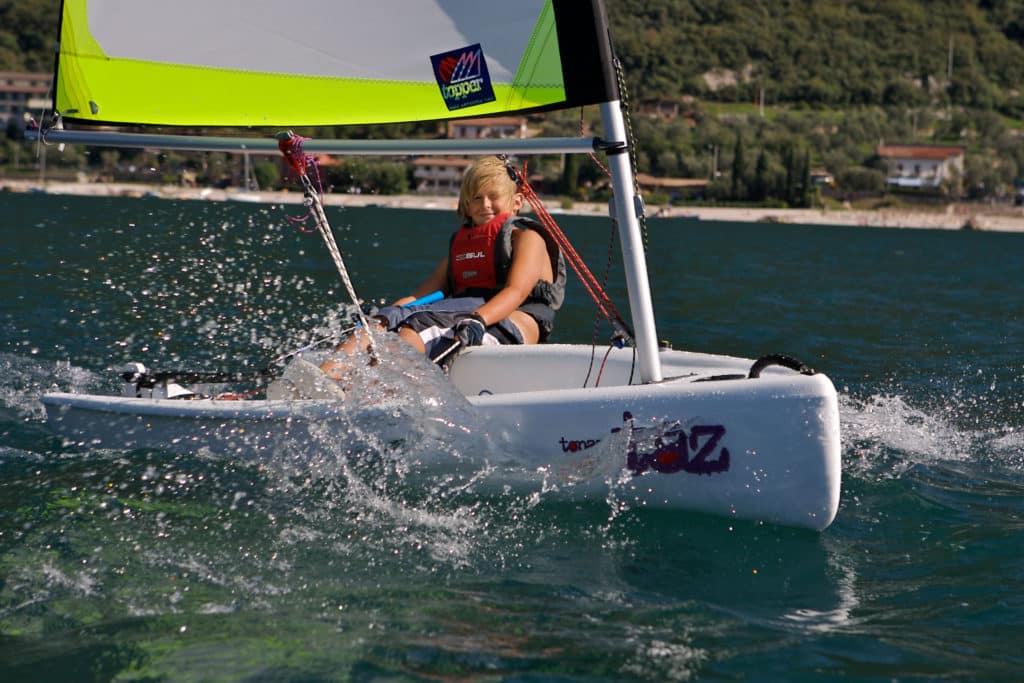
Topper makes a range of mono- and multihull rotomolded boats, but the model that caught one editor’s eye at Strictly Sail Chicago was the Topaz Taz. At 9 feet, 8 inches LOA and weighing in at 88 pounds, the Taz is not going to take the whole crowd out for the day. But, with the optional mainsail and jib package (main alone is for a single child), the Taz can carry two or three kids or an adult and one child, and would make a fun escape pod when tied behind the big boat and towed to some scenic harbor. The hull features Topper’s Trilam construction, a plastic and foam sandwich that creates a boat that’s stiff, light, and durable, and shouldn’t mind being dragged up on the beach when it’s time for a break.
$2,900 (includes main and jib), 410-286-1960, topazsailboats.com
WindRider WRTango
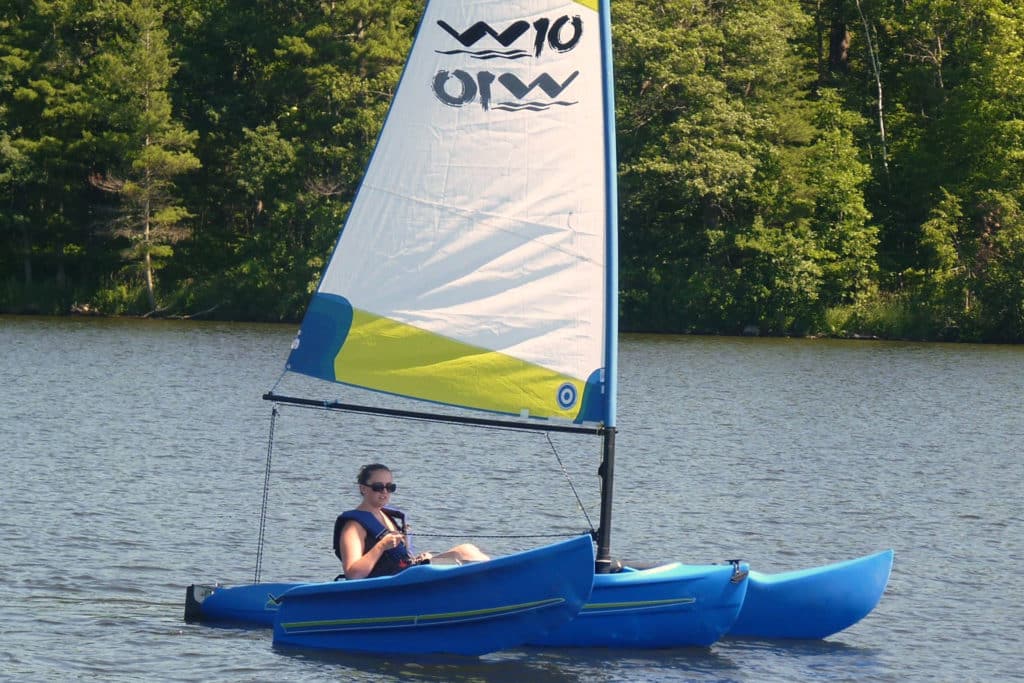
WRTango, a fast, sturdy, 10-foot trimaran that’s easy to sail, is the newest portable craft from WindRider International. It joins a line that includes the WR16 and WR17 trimarans. The Tango features forward-facing seating, foot-pedal steering, and a low center of gravity that mimics the sensation of sitting in a kayak. It weighs 125 pounds (including the outriggers and carbon-fiber mast), is extremely stable, and has single-sheet sail control. The six-inch draft and kick-up rudder make it great for beaching, while the hull and outriggers are made of rotomolded polyethylene, so it can withstand running into docks and being dragged over rocks.
$3,000, 612-338-2170, windrider.com
- More: 21 - 30 ft , Boat Gallery , day sailing , dinghy , Sailboat Reviews , Sailboats , under 20 ft
- More Sailboats
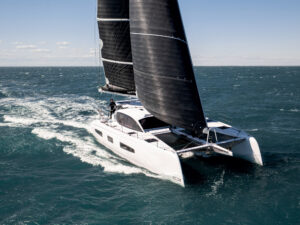
Sailboat Preview: Outremer 52
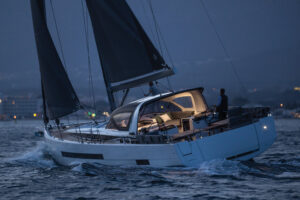
Sailboat Review: Jeanneau Yachts 55
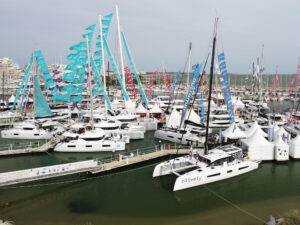
Modern Multihulls: The Future’s Electric

A Gem in New England
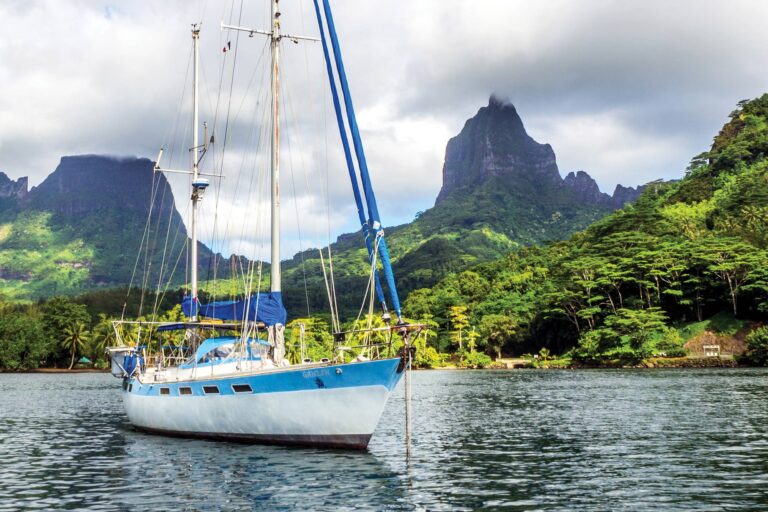
Fatty Goodlander: Have Little, Want Less
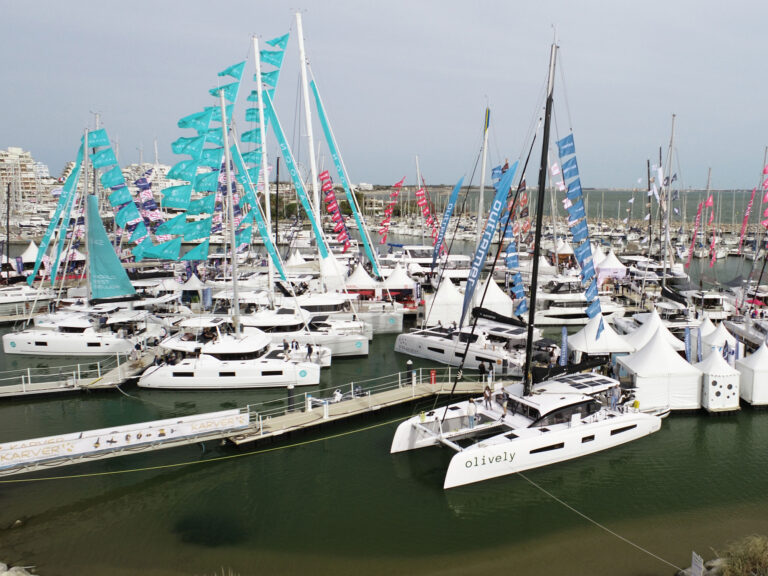
A Big, New World

Cruising World On Board: Windelo 50
- Digital Edition
- Customer Service
- Privacy Policy
- Email Newsletters
- Cruising World
- Sailing World
- Salt Water Sportsman
- Sport Fishing
- Wakeboarding

How to choose the best solo / single-handed sailboat?
What to consider in a sailboat for one person or a short-handed crew.
Keeping control of your yacht in all circumstances is usually on top of the list for most sailors. Because you are planning to be alone at sea, or because your crew is not necessarily savvy, or just does not intend to participate in the maneuvering and tasks, or even just wants to enjoy your RM’s interior comfort and modern cabins without being responsible for the navigation planning.
There are a few features to take into account when looking for the best solo or short-handed sailboat to live on – whether for coastal cruising or ocean crossings. If you are going to be the only one responsible for all operations, you might want to consider the yacht’s safety features, stability, easy maneuverability, and size, according to your sailing experience.
RM Yachts offers two plywood sailboats under 32 feet, which are strong, comfortable, and easy to maneuver for a single-handed sailor:
- RM 890+, liveaboard yacht of about 29-30 feet
- RM 970, a fast and comfortable 32-footer
Optimal features for safe and comfortable solo sailing
RM monohull yachts have been designed with optimized deck plans, which make them great single-handed sailing yachts: the deck fittings, the layout, the running rigging organization, and the ergonomics have been thoroughly thought to facilitate not only the solo navigation or the short-handed crew, but also the safety on board.
This ergonomics enable the single-handed sailor to:
- Have a perfect fore vision from the helm station.
- Have a panoramic vision from the inside charts table, thanks to the fore window.
- Have a direct access to the sheets and traveler, thanks to the “German sheet” display, and take action within seconds: hardening or easing, deal with gusts, etc.
This ergonomics also enables an easy task distribution: the blockers and jammers, the sails trimming, the winches at the right height for a standing crew member, etc. All this without having to run to the mast’s foot in heavy seas – ideal for a solo sailor or a person sailing without assistance.
Keep in Touch' Restons en contact
We will send you RM Yachts News (Only) to make sure you are up to date. Recevez (seulement) nos infos, pour être sûrs de ne rien rater !
- FR - Français
- EN - English

- Forum Listing
- Marketplace
- Advanced Search
- About The Boat
- Boat Review Forum
- SailNet is a forum community dedicated to Sailing enthusiasts. Come join the discussion about sailing, modifications, classifieds, troubleshooting, repairs, reviews, maintenance, and more!
Top 10 Sailboats Easiest & Best to Single Hand
- Add to quote
Hello Sailor's There are some great sailors on this site. In your opinion. What sailboats would you consider to fall into a top 10 category for easiest and best to single hand sail in a coastal environment. This would also include the possibly of living aboard? ( length 30 to 38 foot ) Use Up and Down the East Coast, Bahamas Thanks Diceman
Top 10 Sailboats Easiest & Best to Single Hand Have to look at the Freedom sailboats for ease of handling and roominess. Have a 38 that we just love. Very stiff. Don't look at reefing until 24+ knots.
In this size range you have two real options. The first is a cat rigged boat like the nunsuch, everything else you just have to set the boat up to do it. No boat out of the factory is set for single handed sailing. To be honest the only boat I know of in the 40ish foot range that was designed to be singlehanded is the Open 40, and they are NOT the boat for a beginner.
Stumble said: In this size range you have two real options. The first is a cat rigged boat like the nunsuch, everything else you just have to set the boat up to do it. No boat out of the factory is set for single handed sailing. Click to expand...
I bought my Hunter Vision 32 for coastal cruising .... easy to sail and great at the dock! All lines back to the cockpit, two jiffy reefs, electric winch for Main, lazy jacks, furling jib etc. Just Launched - Hunter Vision 32 | Tom Dove
Thanks ereiss for you suggestion. I should have said Wanted Top 10 on this post. I could not edit the heading of the post or if there is way I do not know how. Thanks Diceman
I don't know what you mean in that last post? You want us to put down what we think are the top ten? Very few have sailed on ten different boats solo so how the hell would they know? You will just get drivel. Beneteau 393 I have done about 15,000 miles solo and I prefer to handle her myself. I would prefer best as solo Jeanneau 54 Beneteau 54 Beneteau 50 Jeanneau 49 Beneteau 473 47 footer.... Beneteau 46 Beneteau 423 In that order. But if money was no object I would solo an Oyster 57, but I would have a cleaning crew at each port! Basically, get the biggest boat you can. And only buy a "proper" boat, a modern, production boat, cheap, reliable, roomy etc.
MarkofSeaLife said: ......I would prefer best as solo Jeanneau 54...... Click to expand...
Thanks Stumble & RonRelyea MarkofSeaLife MarkofSeaLife- Your right I should not have put the 10 in the post. Just should have said "What boat do you think would work the best for---". I have thought about staying in the 32 to 34 foot range. I do like the roominess of the Morgan 382. Draft I'm sure is a issue to be concerned about. I have a wife that will be going most of the time but not helping much in the sailing department except at the helm a little. I did take some lengthily sail lessons out of Maryland (not the 4 day deal) Up and including ASA 105 over the past two years and spend some time on Chesapeake Bay 30 to 46 foot boats. This by any means does not classify me as a sailor. Far from it. If I had not spent the money and taken the time to try to learn the right way to go at sailing I would have found my self in big trouble. Not to say I will not encounter lots of problems just that I will be better prepared for them now. My asking for suggestion's on a boat came along because there are so many boat's to choose for sailing. All have a job to do just that some do a better job then others at a certain thing. I thought this site with it's long list of season sailors could offer some great advise on what boat's would work best. No need to reinvent the wheel. Thanks Diceman
Sloop rigs = easy to single hand But with varying annoyances like winches too far from the wheel or tiller.
If you really plan on single-handing in coastal conditions, I would suggest that you look for moderate to light displacement for the length boat since they have more easily driven hulls that can get by with less sail area. I also recommend a fractionally rigged sloop since the have smaller headsails and so are easier to tack and trim shorthanded, although they are scarer in that size range. Most Fracs also have enough rig flex that you can avoid reefing or sail changes across a wider range of conditions. I would suggest something like a J-34c, Express 34, or a Farr 1020 (I routinely single-hand the 38 foot version of this boat). All are pretty handy to sail since they are easily driven hulls and can sail with minimally overlapping headsails, without giving up sailing ability. Jeff
Hmmm interesting question. Easiest will be small but 'BEST' ? may be quite large. I am a full time liveaboard and single hand about 50% of the time in fairly coastal conditions although the passage I am doing tomorrow is one of the rougher ones St Vincent up to St Lucia with a known acceleration zone and rough sea spot to the north of St Vincent. My boat is a fairly light 44ft cutter with roller furling on the headsail only. I would say that having a roller furler on the staysail as well would make things easier and as I get older [ 65 now ] I might add this. I have slab reefing on the main and would not change this. Mainsail hoist and reefing lines are not lead aft. With good forecasting I rarely need to reef on passage and the strongest conditions I would choose to sail in require that I use the first reef on the main and staysail only. 30 knots gusting 35. When conditions are rough and seas are short [ the dreaded Caribbean two step ] my old lady maintains way much better than a 32 footer. So maybe this is best? BTW she is a New Bombay Trading Company Explorer 44 and very definitely NOT FOR SALE OR HIRE.
I would say a modern production boat would be easiest. Furling main and jib, self tailing winches, auto tack. Easy to dock. Easy to control under power. I can tell you that the 2005 33' Hunter I used to sail was as close to idiot proof as possible.
Thanks everyone for all your answer"s to the post. Your suggest's help as I sort through the boat's that are in my price range. Thanks Again Diceman
Freedom and Nonsuch... No brainer. Rest of the boats are far behind. Freedom 32 brochure http://freedomyachts.org/viewtopic.php?f=16&t=8567
posted by MarkofSeaLife :"Very few have sailed on ten different boats solo so how the hell would they know? You will just get drivel." he has a point, but even with this in mind, many sailors know what it takes to single hand even though they have limited experience on many different boats. Take my Tartan 37 for example, I single hand it often and know what it takes. It really is set up fairly well, although one point of contention is that you have to leave the helm to adjust the main at the companionway. Not bad if you have a decent autopilot or if you lock the helm down for a moment but it would be nicer to be able to reach it from the helm. Otherwise, I would say not a problem. The draft is sweet at 4'-2" (centerboard model) and stable enough to take offshore (48% ballast/disp) 272 disp/length ratio, 16.1 sail area/disp.
I would have a good look at Nonsuch. For one person a 30 is more than adequate. Because of the beam it has the attributes of a much larger boat. There are two interior arrangements that are very different - Classic and Ultra. The latter are typically more expensive.
The one Nonsuch I have been on was a 30 Ultra with the dinette table removed. I thought I had stepped into a house. It was an Alice in Wonderland moment. My brain actually started imagining a ping pong table in the middle of this 'room" I was in. They are cavernous. And that comes from someone who is used to a modern Hunter.
To echo what others have mentioned, "easiest and best" I believe come with experience and familiarity, regardless of the boat. I am pretty comfortable single handing my own boat. But stepping aboard the exact same make and model boat, yet setup differently for the skipper's preferences, I am flat out lost. This statement will likely draw scorn but, for older boats (like mine) that still have all the halyards at the mast, I've come to the conclusion that an autopilot will be easier to fit and more useful for singlehanding than retrofitting the onslaught of deck organizers, blocks, stoppers, and cabin top winches to run everything aft to the cockpit. I've made the decision to stick with hank on sails and keep a modest inventory to change the headsails to conditions as I sail mostly on the bay. Your preferences for furling or non-furling and local waters will dictate how the boat is rigged. I'm definitely in the "less is more" category, which seems to be against modern thinking. cheers, -Ike s/v Skol Berkeley, CA
Agreed that for your two stated criteria the Nonsuch is way ahead. It has much more beam (and carries that beam far forward) than marconi rigs. If you haven't been below on one, you'll be impressed with the room. It does feel like a house. It is also set up for easy sail handling right out of the box. Short tacking up a channel? No headsail, no problems! If you go with a marconi rig I'd say that what you are looking for is what Jeff H suggested. The lighter the boat, the less sail area you need to handle and the lighter and easier those sails are to handle. So you want something lightweight. You probably also want roller furling headsail(s) and a roller furling main. The furling mains have some disadvantages, but for single handing, they can't be beat. Easy to put away, hoist or reef. Lines should obviously be led aft and as many as possible should be within reach of the helm(s). You'll want an autopilot and/or tiller lock and you might also want a saysail boom for your headsail so you don't have to mess with it when tacking or jybing. Island Packets are famous for always having staysail booms.... MedSailor
Thanks Everyone Again. I think that all of your suggestions thought's will be very useful to me and other's who read these different post in a search for the boat they think they my want to buy. Diceman
I vote the Flicka. Smaller is easier.
How long (years) would you say it would take a beginner to learn sailing and be able to handle a 40' along the coastlines of US?
Your question is a lot more like "How long is a piece of string?" than you probably realize. I'll let others chime in with more nuanced answers, but to answer your question directly, I'd say 1-3 years if you were FULL TIME dedicated to it, and 3-7 as a part time proposition depending on your effort and study, 6-15 as a background thing that you didn't devote a lot of time to, but did devote some. BTW I'm assuming that you mean singlehanded since that's the title of this thread. Cut the times by 30-50% if you are taking COMPETENT crew with you. Medsailor
Thanks MedSailor, and Yes, I'd be single handed doing this as I don't plan on support crew, although the wife would be onboard.
- Amount of freeboard
- Keel configuration - as it impacts turning and sideslip
- Propellor. Some give miserable reverse, others have good thrust in reverse
Really depends where the hell you are going... coastal cruising,,, island hopping, or crossing a few oceans.... Im with Sealife if your going places... bigger the better... if your just cruising the BVI's the Nonsuch is the clear winner
I would have to give a nod to Greg's recommendation along with several others. Nansuch. Of all the boats I have delivered a 32 & a 36 they were like sailing a dingy. Only used a wench handle for the last 1' of the main halyard, adjusting the boom for draft. 98% of the time the main sheet was pulled by hand and if needed the mainsheet wench could be reached while holding on the wheel. I just couldn't get over that massive tree just aft of the bow. Freedom might be similar. climbing down the lazaret you could walk around the engine. Huge area, would hold almost as much stuff as my garage. Drawbacks they seem to hold there value and can be pricey.
You can single anything. I single my P35. I've singled a properly set up T37. Neither is as easy as a Nonsuch, but it's all in the set up.
- ?
- 174.3K members
Top Contributors this Month

Best Single Hander
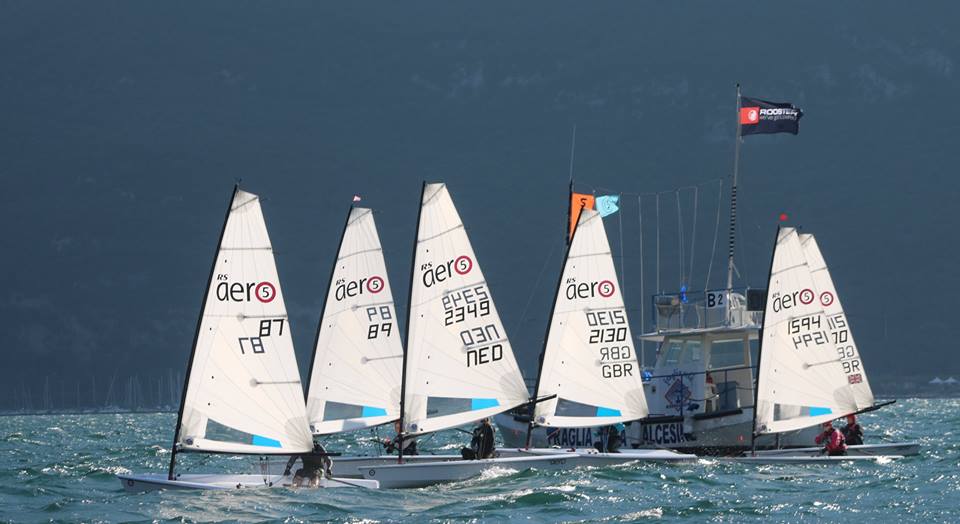
Here at RS Sailing, we pride ourselves in designing sailboats that will capture the hearts of young and budding sailors at the very beginning of their sailing journey, and through our range of training and racing dinghies, pave the way for whatever pathway they choose. Whichever route an RS Sailor opts for, they can expect challenge, adventure, friends for life and a reliable boat that serves their purpose.
Here we showcase our single handed sailboat range
So what’s the appeal of single-handed sailing? What makes so many avid sailors enthusiastically take to the open sea or a near frozen lake in the middle of winter to sit in a small boat by themselves? Well aside from the obvious convenience of being able to sail totally on your own terms, it is often the simple but limitless release and freedom that sailing your own boat on your own piece of water brings. For the more competitive types, it’s the determination to cross that finish line first or just perfect that manoeuvre a little bit more before taking to the bar to explain the entire experience to a group of mates that never bore of hearing about the one thing that they are all so passionate about. Whatever the motivation, it’s a fire that burns in the hearts of sailors of all ages, shapes, sizes and walks of life and we’re determined to encourage it!
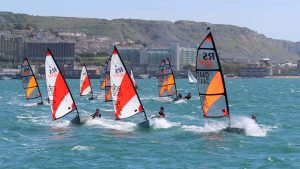
The RS Tera is a single-handed sailing dinghy, which with a hull length of 2.87M and constructed using the strong and durable RS Comptec PE3 technology, is perfect for young children learning to sail. Alongside this, the RS Tera boasts a high level racing circuit worldwide for children up to age 15 and offers two key rig options; the Sport, which is designed to be underpowered and forgiving for the lighter or less experienced sailor, and the Pro, providing a more powerful option.
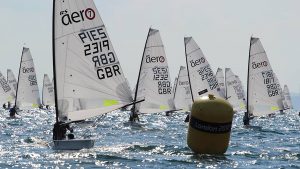
Many young RS Tera sailors aspire to progress to the new and revolutionary RS Aero, which since its launch in March 2014 has broken the mould of traditional adults single-handed hiking boats. Its ultra-light weight hull of 30kg matched with its sheer simplicity makes it the ‘road bike’ of sailing; an easy to transport, easy to rig boat that with its incredible responsive and light feel seems to offer almost limitless enjoyment to so many sailors around the world.
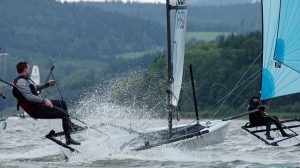
At the high performance end of the RS single-handed sailing spectrum sits the RS700. Its single trapeze and powerful asymmetric spinnaker makes it both challenging and thrilling for its sailors. The weight equalisation system that the RS700 shares with its double handed sister ship, the RS800 means the boat can be raced competitively by sailors of a wide weight range. The relative simplicity of the boat and its weight equalisation makes the notorious race circuit tight and exciting yet accessible and, thanks to the friendly fleet and excellent social side, forever welcoming!
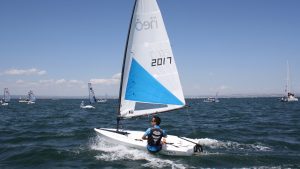
For the less competitive types, or for those looking to develop their sailing skills before taking to the race course, the RS Neo is a stable and spacious platform designed for adults to sail by themselves with the option to add a jib, either for a bit more of a challenge or to allow for a young crew to hop in the front! Using the same RS Comptec PE3 Construction technology as the RS Tera, the RS Neo is strong, easy to maintain and stiff, which alongside durability, adds to the performance of the boat.
If 2018 is your year to discover or re-discover your own passion for sailing and you’re wondering where to go first, drop us a line on 01794526760 and someone in our team will be happy to answer any of your questions. Otherwise check more details on our entire range of single handed sailboat here.
< Back to Blog Home
- Sign up for RS stories, offers, epic wipeout videos and much more!
- First Name: *
- Last Name: *
- Comments This field is for validation purposes and should be left unchanged.
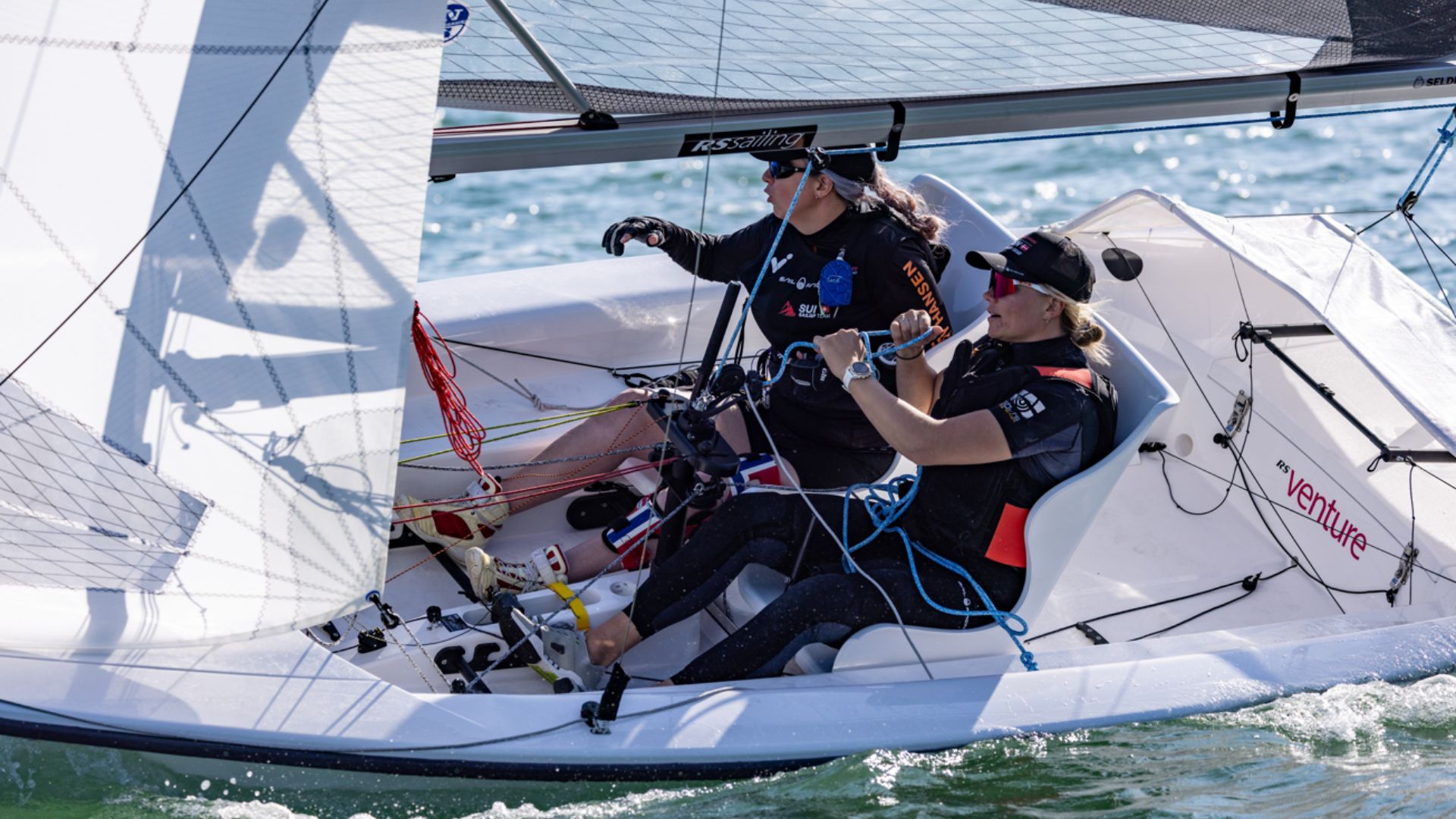
‘Open’ Category announced for the RS Venture Connect World Championship 2024
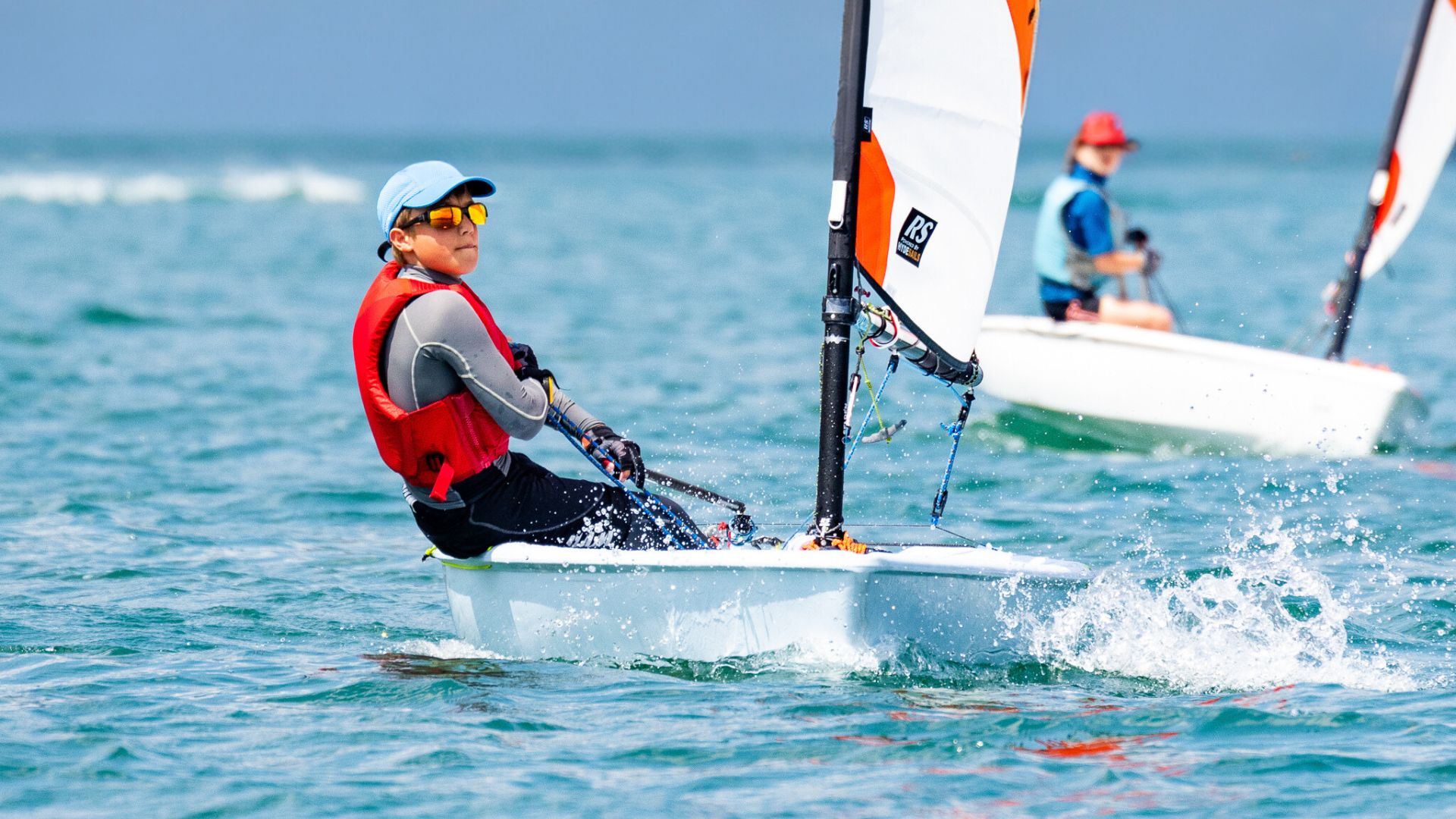
RS Tera North American Championship held at Los Angeles 2028 Olympic Venue
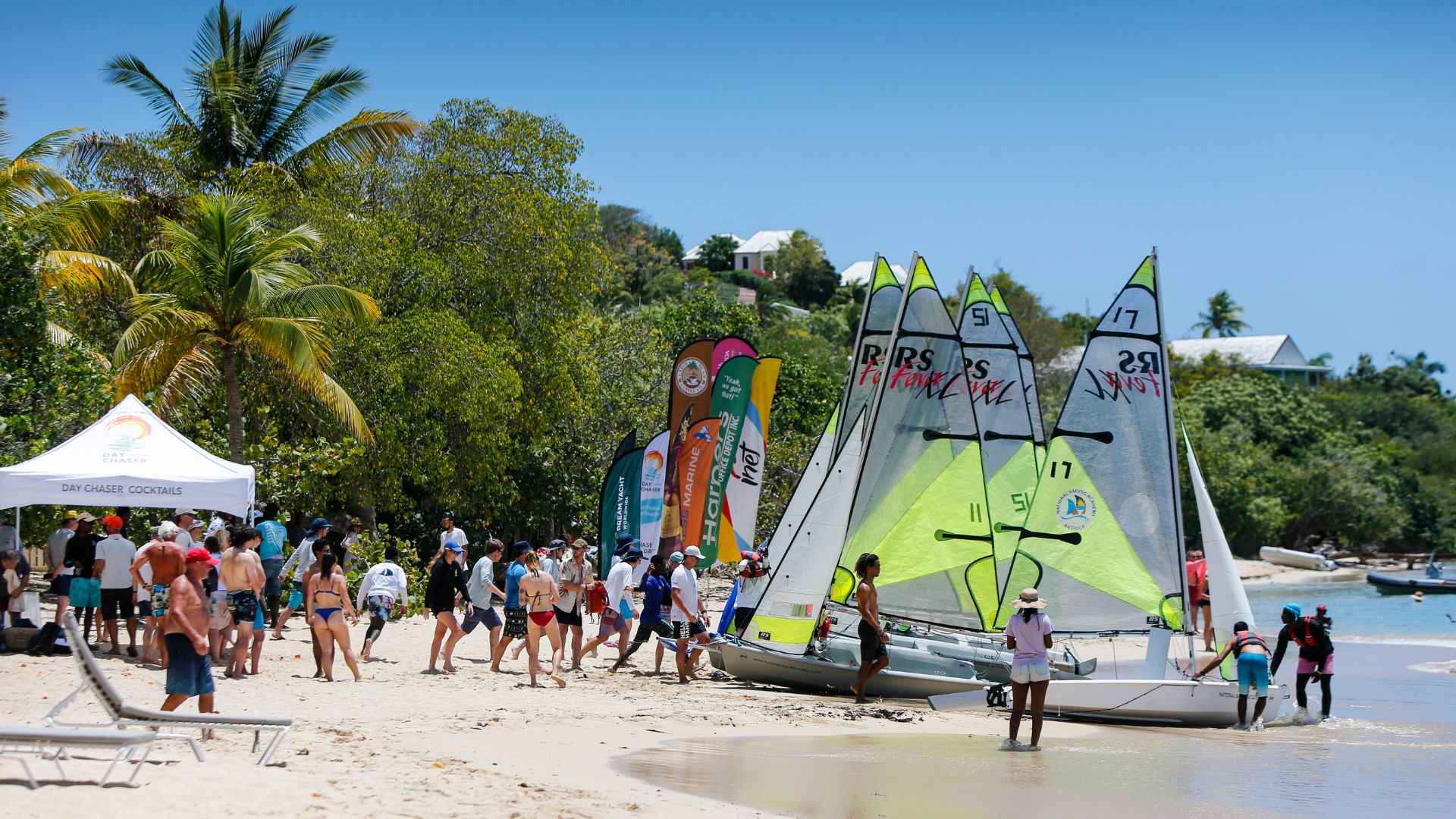
RS Elites and RS Fevas at the 55th Edition of Antigua Sailing Week
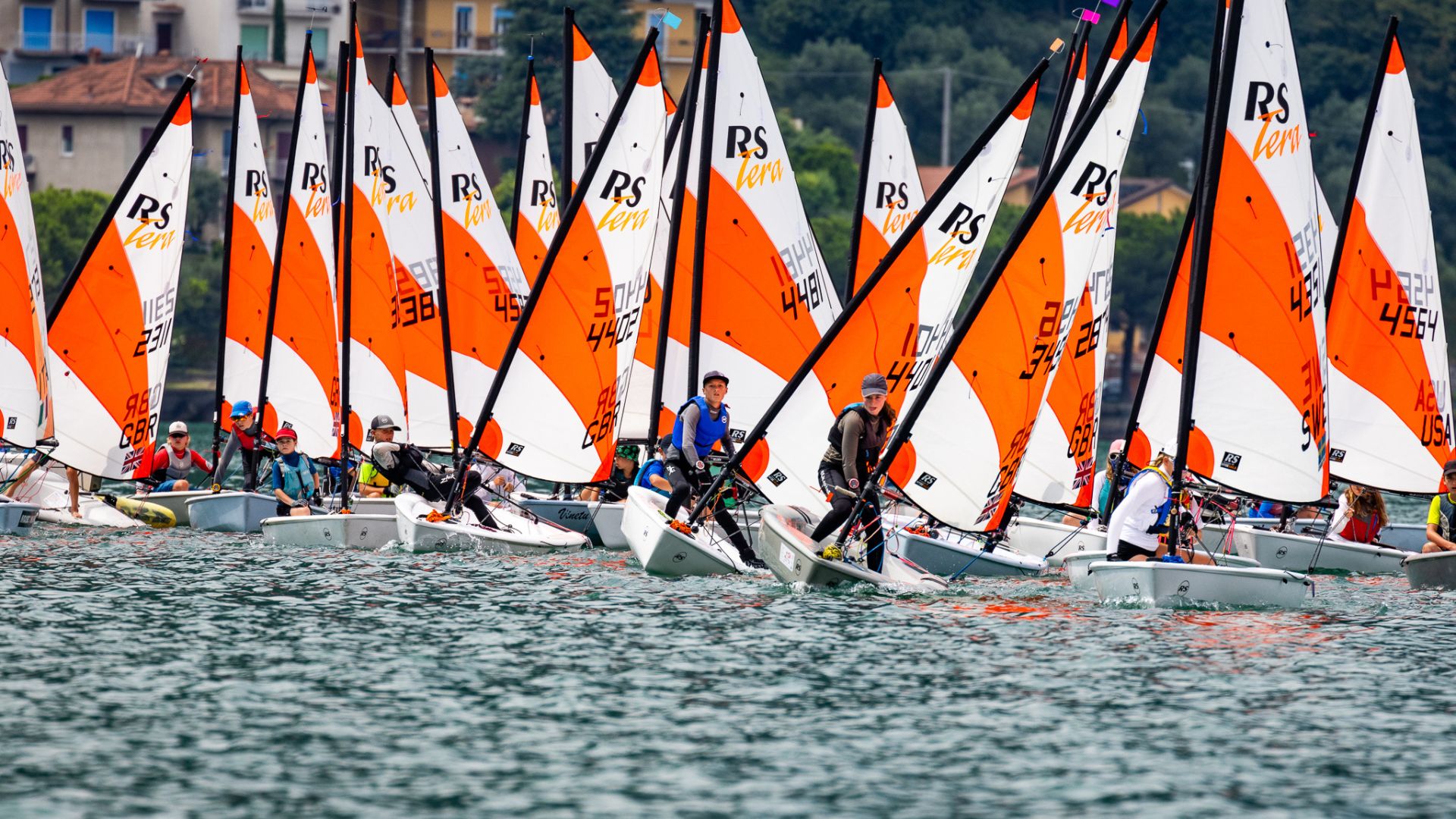
RS Tera World Championship 2024 Already Breaking Records with Fully Booked Entry List
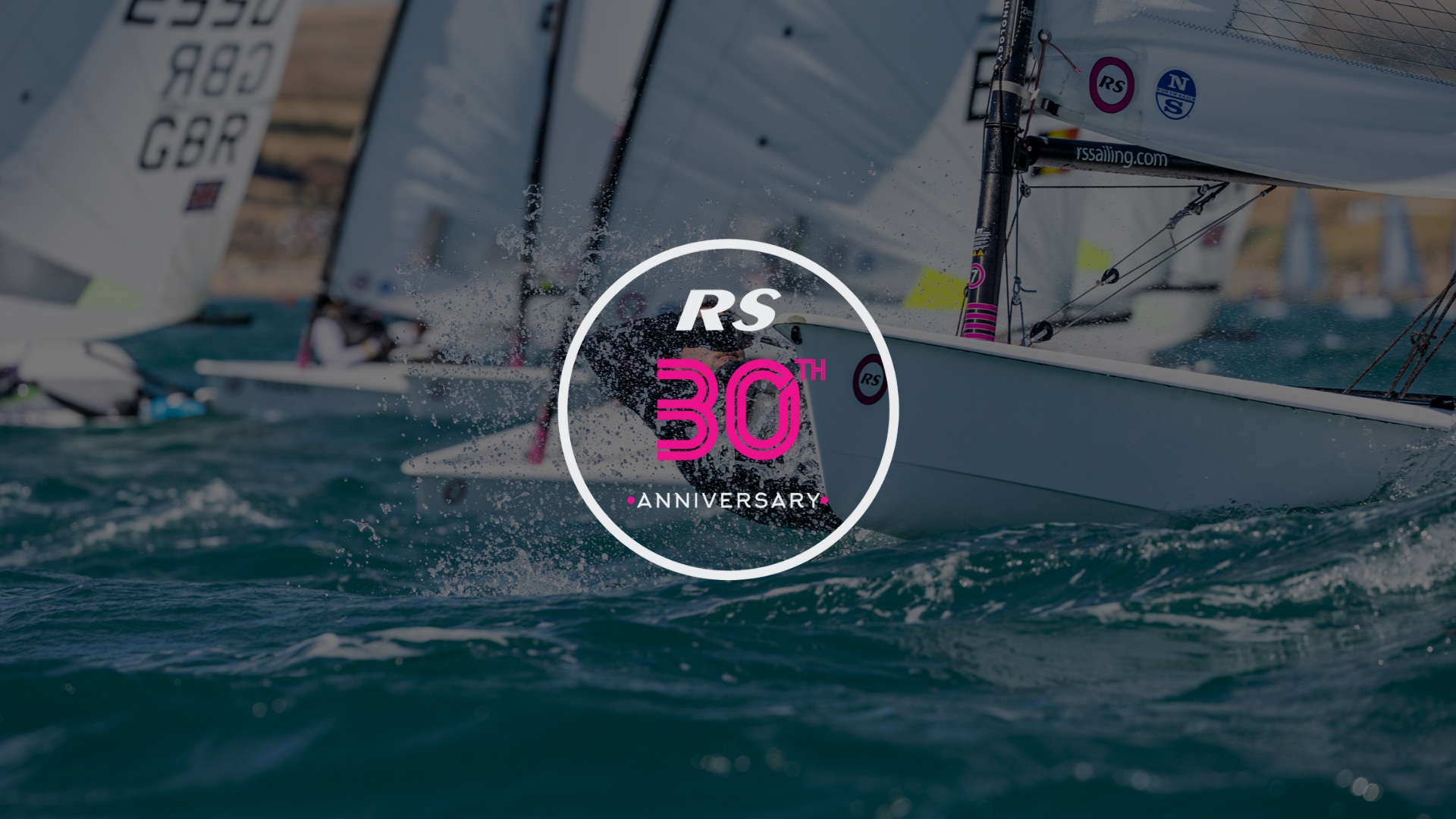
30 reasons to attend the RS 30th Anniversary Regatta
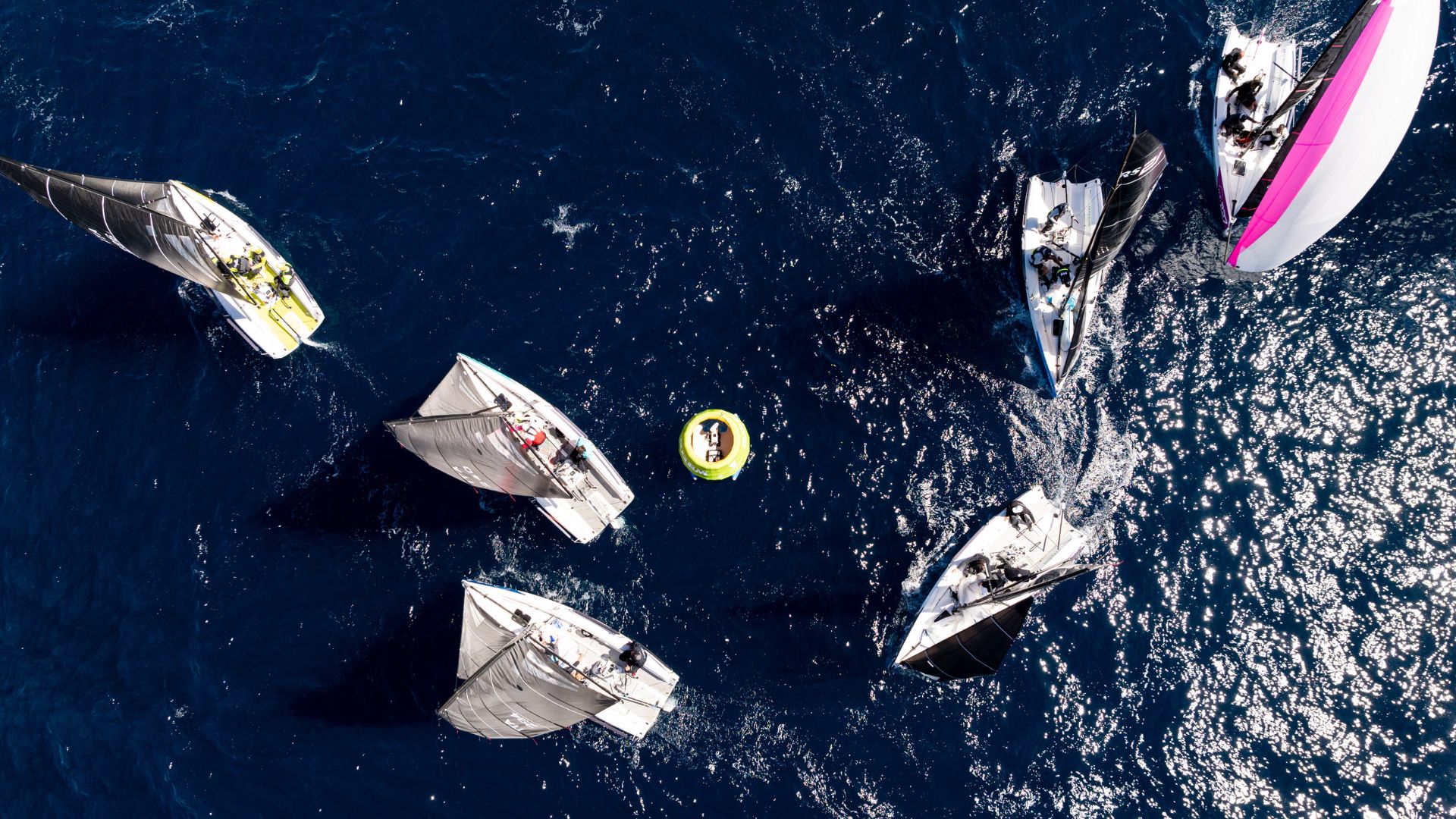
RS21 Class supports Inclusion Sailing with the International Inclusive Keelboat Championship 2024
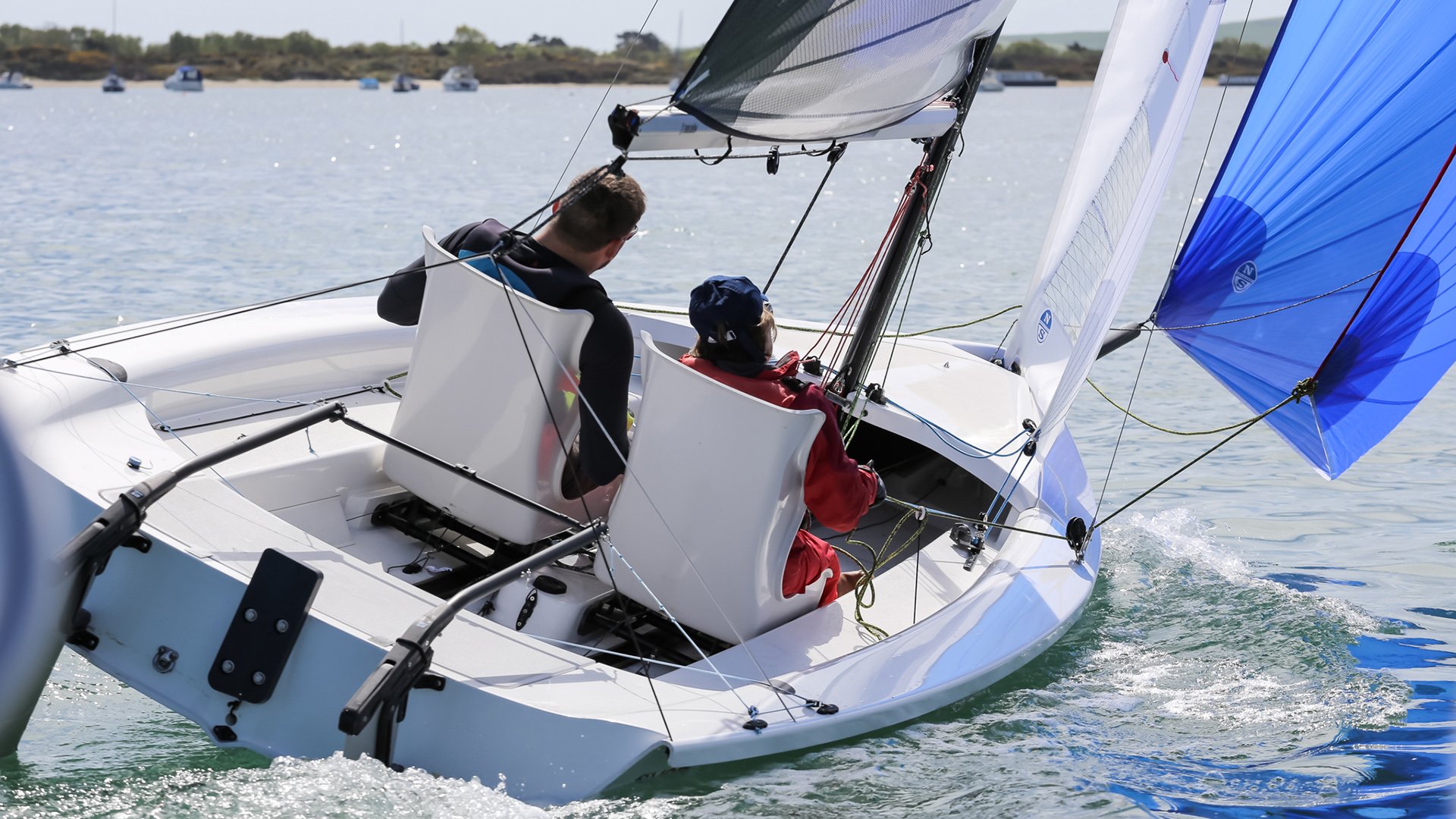
Olympic Flame to be carried by RS Venture Connect Inclusive Sailing Program Mare Inseme

RS Fest Miami brings the hit RS Sailing Festival to the United States
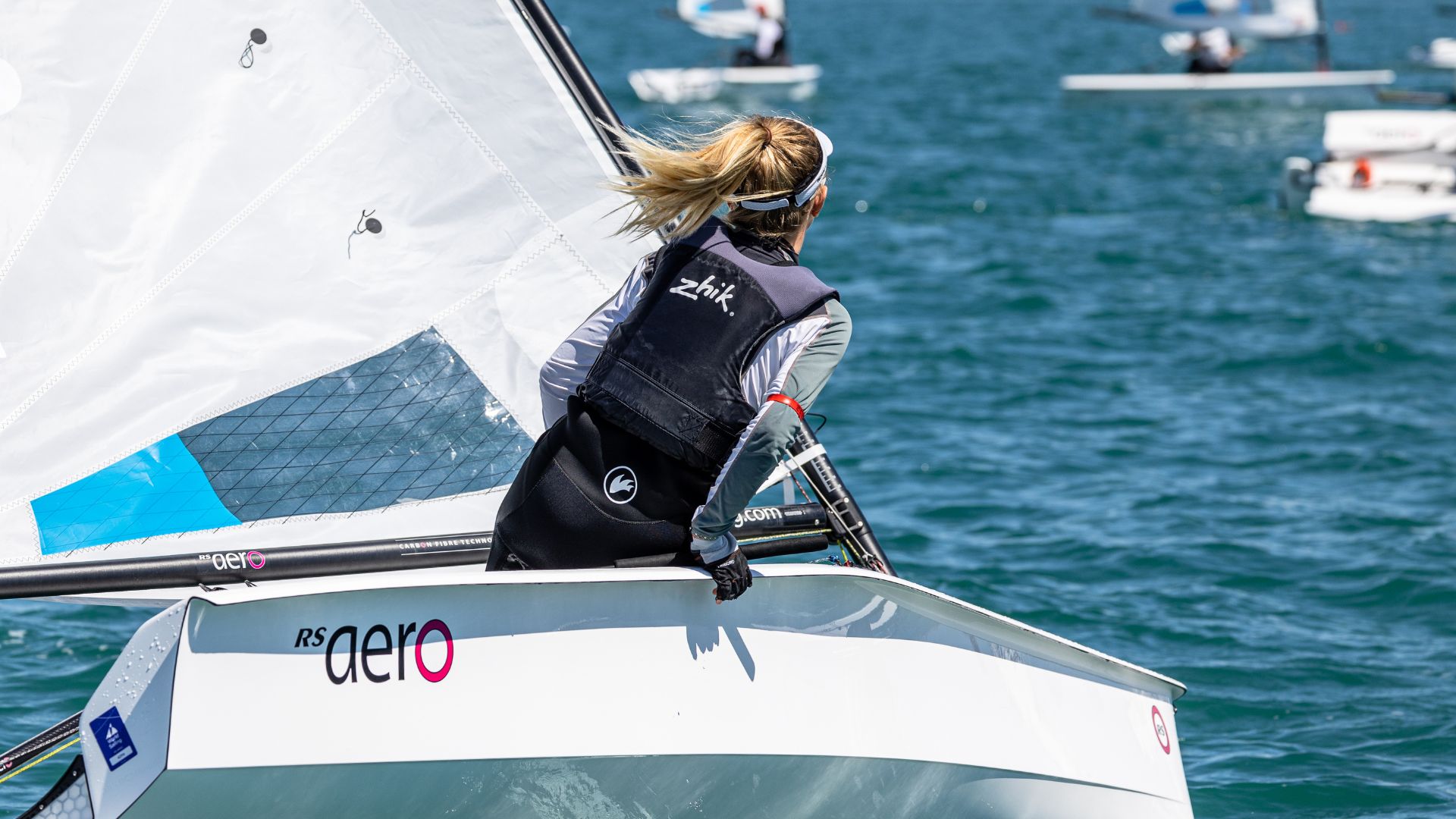
Join the RS Team! – Parts and Dispatch Summer Job

Entries Open for the RS Venture Connect World Championship 2024

What’s included with your entry for the RS 30th Anniversary Regatta?
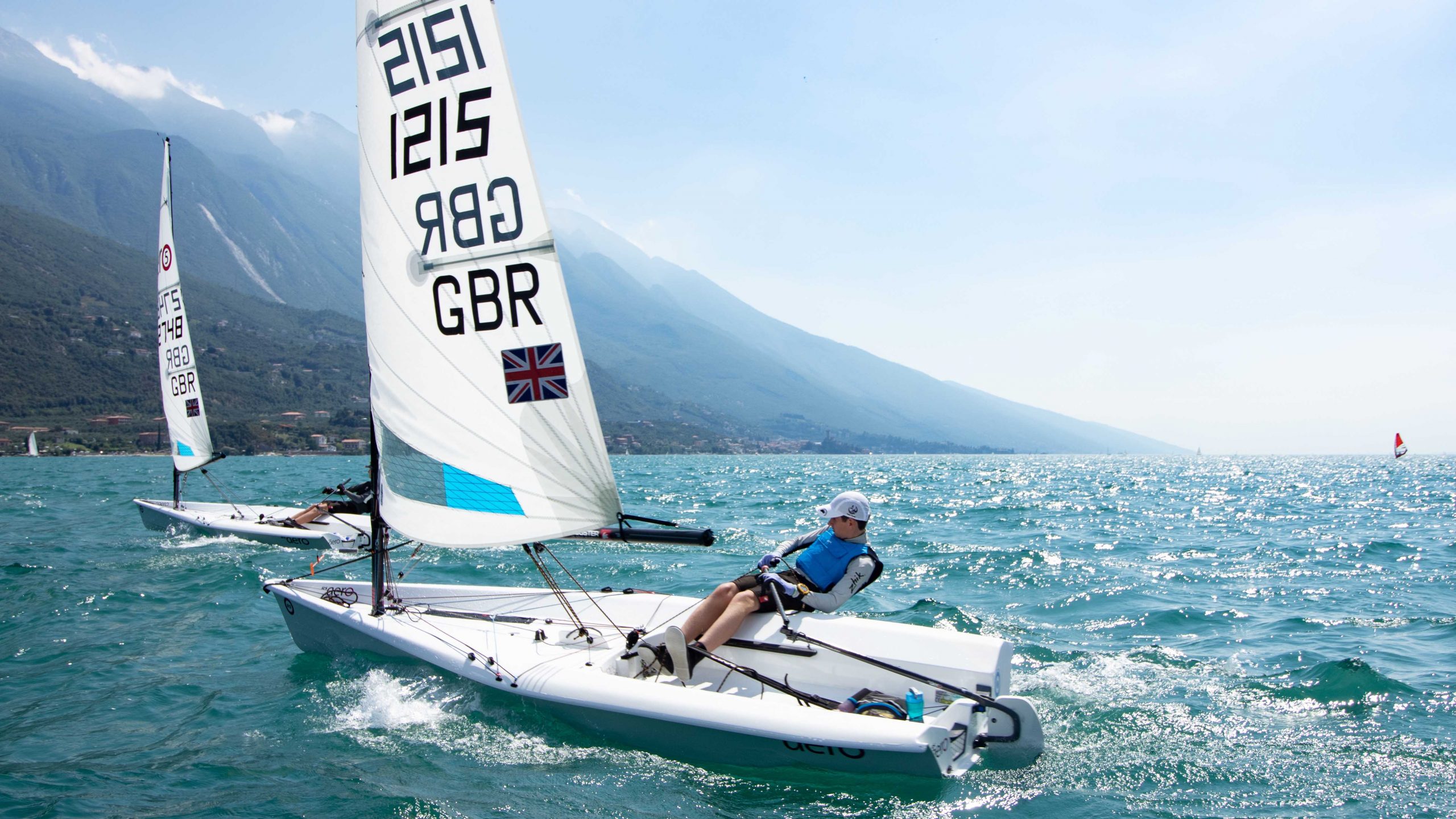
Life after Toppers? You need to try the RS Aero!
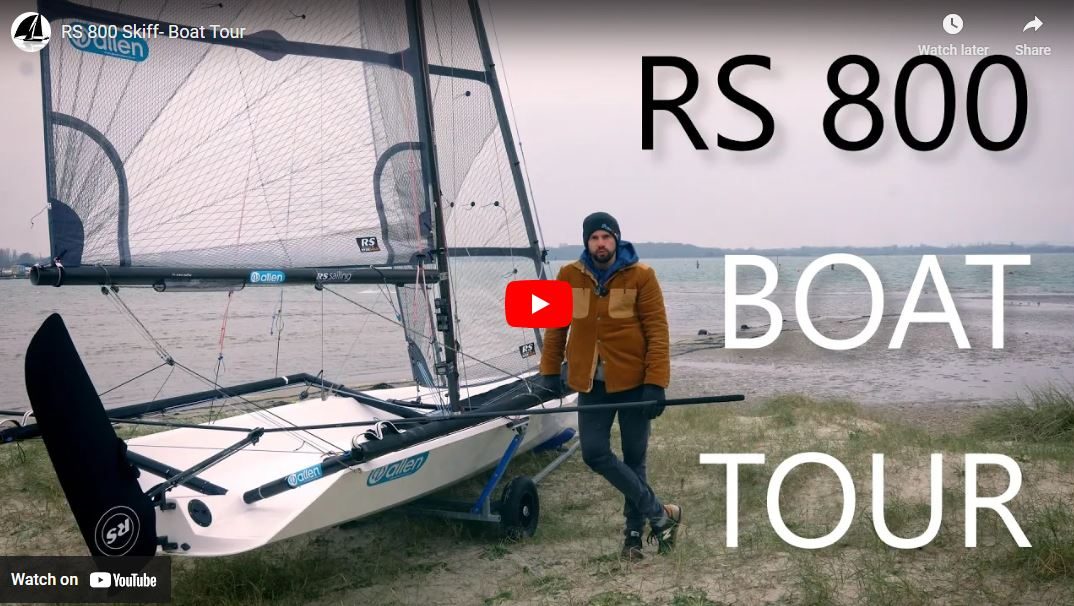
Mozzy Sails – RS800 Boat Tour
Pin it on pinterest.

Home Single handed sailboat
Have you been dreaming of solo afternoons, a short coastal trip, or a day’s sail all by yourself? Experience the magic of single-handed sailing...
All our yachts, whether it is the 38 or 70, have in common that they are easy to handle and suitable for single-handed sailing. All the controls, such as the jib winches, are located at the steering position. If desired, the mainsheet can be made electric on a captive winch allowing you to adjust the mainsail by the touch of a button. The excellent manoeuvrability of our single handed sailboats will make sure leaving and returning to your dock is never a hassle. But who better than one of the Eagle owners can explain the easy handling and manoeuvrability of our single handed sailboats:
Hi, Just wanted to let you guys know that the boat has been an absolute joy so far… I absolutely love it. I’ve been sailing it 2-3 times a week since it arrived and it has basically been flawless. I do a lot of single-handed sailing and it has been really perfect for that. Not to mention the number of compliments I get from people in the marina, which is incredible… It is probably the most talked about sailboat in Marina del Rey right now. Anyhow, just wanted to pass along this feedback – thanks for making such an amazing boat!
I first encountered the Eagle range of sailing yachts in Sainte Maxime, VAR, Southern France. Needles to say the area is awash with magnificent craft, however the Eagle 54 stopped me in my tracks. It started me on my journey seeking an Atlantic-coast seaworthy modern day-sailor. Believing that something around 10m would fit the bill, I spent about 24 months investigating, and test-sailing, several options.
At the end of the day the deciding factors were (in no particular order): Maneuverability, Ergonomics, Single handed sailing not critical, but advantageous, Stability and predictability, Ability to point, Off wind sailing, Centre of gravity, Feel when helming - which was very important, Ability to keep the skipper and crew dry, even in Irish Atlantic swells and conditions, Fun, Performance. And of course, design, build-quality, and finish.
Our Eagle 38 was ordered, and delivered, and launched on the 30th August of this year. She is a beautifully and highly technically well built and appointed day-sailor, and one that ticks every single box on the wish-list. She arrived on time, in wonderful condition, Steven having arrived the day before. The launch was seamless, by no means rushed, and had been clearly well planned by Leonardo Yachts.
Within 24 hours of her arrival, and on day one post her launch, we were beating at a steady 7 kts in a 1m swell, with about 10kts true wind. We bared away to a reach and were managing 8 to 8.5 kts without any effort whatsoever. Coming alongside the pontoon is a pleasure.
In terms of value for money, I would have to say that while these magnificent yachts may seem to be expensive, once fully kitted out, these boats represent very good value for money.
Thanks Leonardo Yachts,
Gary Delaney.
With the classic lines but modern technology and underwater body, our single handed yachts are fast but comfortable sailers. Due to the relatively low weight, of which a substantial part is placed in the keel, the Eagles are stable sailers. And due to the classic lines, the waterline increases when the single handed sailing yachts catch some wind and slightly heel. Just a small breeze will get the Eagles starting to fly and they will remain comfortable in stronger winds as well.Our Eagles are the perfect yachts for a single hander. If you share our passion for single handed sailing, we would be honoured to help fulfil your aspirations.
Get in touch and explore all our options.

IMAGES
VIDEO
COMMENTS
The J/109 is unquestionably one of the best single-handed or double-handed sailboats that money can buy. Whether you're looking for a coastal cruiser or a long-distance single-handed vessel, the J/109 will rarely disappoint. ... The fact that it has a lightweight hull and is easy to rig makes it one of the most popular racing sailboats in the ...
In this article, I talk about single-handed sailing and look at the nine best sailboats for one person, ranging from small lake dinghies all the way to comfy cruisers capable of oceanic crossings. Here are the best sailboats for solo sailing. RS Aero. Jeanneau Sunfast 3200. Beneteau Oceanis 62.
Solo bluewater sailboats are designed to be sailed by a single person, making them ideal for solo circumnavigation or long-distance cruising. You can get the Contessa 32 and Westsail 32 for as little as $30,000. The maintenance and repair costs of the seven boats range from $5,000 to $50,000 per year. Marina fees and insurance can range from ...
Sail an RS Aero for the pure exhilaration; Lift on the roof alone or with a youngster - rig in minutes - launch with ease. World Sailing International Class. Incredibly fast growing around the world - by the best-selling modern single-hander. Event programmes building quickly; World Championships from 2017 onwards
So, now let's see the best boats for single-handed sailing! HANSE 371. ... It has all of the requisite features to easily adapt it to perform admirably as a sailing or racing sailboat. The boat features two double cabins, a chart table, a galley, and a head compartment. >>Also Read: Best Sailboats Under 20ft.
The Dehler 30 One Design is selected Sailing World Magazine's Best Offshore Racer in its Boat of the Year competition. The 30-foot pure raceboat is designed for racing with fewer crewmembers ...
Short answer single handed sailboats: Single handed sailboats, also known as dinghies or small keelboats, are sailing vessels designed for easy handling by a single person. They typically feature smaller sizes, efficient rigging systems, and self-tacking jibs to facilitate solo sailing. Popular examples include the Laser, Solo, and Sunfish. Exploring the World of Single Handed
Best Single-Handed Sailing Catamarans. ... This flies in the face of the design ethos shared by most older "classic plastic" monohulls built for the club racing scene. Most cruising catamarans are rigged with straightforward fractional sloop rigs with large, full-batten mainsails. The mains typically feature slab reefing, and the foresails ...
Picking out a great vessel is imperative to enjoying a great sailing experience. We have selected the creme de la creme of sailboats suitable for a range of budgets and needs. Jeanneau Sun Odyssey 380. Beneteau First 44. Fountaine Pajot Isla 40. Hylas 57. Leopard 42.
For those seeking competitive solo sailing, the J/70 is a top-tier choice. Its responsive handling and speed capabilities make it an excellent option for single-handed racing. 8. Melges 14. The Melges 14 is a versatile and lightweight sailboat. It's well-suited for solo sailing thanks to its user-friendly rigging and comfortable cockpit.
Hallberg Rassy 352. This is a sturdy and high-quality sailboat built between 1978 to 1991. It features a progressive design, combining a walk through with the aft-cabin from the main saloon. It is made with a tall and standard rig each supported on double and single spreaders, respectively.
Find specifications and pricing information on the best selling one-design racing sailboats on the market and choose the perfect one for you with itBoat! Explore. Powerboats. All / 13209 Cabin Cruisers ... "Dragon", "SB20" or "Melges"), others can be used for single-handed sailing (for example, "Beneteau Figaro"). As a rule, each one-design ...
For almost 20 years, we've called this awards program SAIL Best Boats, but this year, we're refining and renaming this program to better and more fairly represent the boats we've selected. Restricting boats to categories and labels—such as Best Cruising Monohull 30-40 feet and Best Performance Monohull 40-50 feet—doesn't bring our readers the full picture.
The CW Hood 32 is sleek and graceful through the water and quick enough to do some racing, but keeps things simple with a self-tacking jib and controls that can be lead back to a single-handed skipper. A top-furling asymmetrical, electric sail drive and Torqeedo outboard are all optional. The CW Hood 32 makes for a great small family sailboat.
The Contender is an international class and among the most popular singlehanded trapeze dinghies in the world. Its rig and controls allow for easy de-powering, with past champions ranging in weight from 60-90kg. The RS600 is another trapeze boat, offering affordable second-hand options for those looking to get into this style of singlehanded ...
How to choose the best solo or single-handed liveaboard sailboat? Best size (30ft, 32ft, etc.), safety and performance features, easy to manoeuvre, etc. Our sailing boats. RM890+ RM970+ RM1080; ... RM monohull yachts have been designed with optimized deck plans, which make them great single-handed sailing yachts: the deck fittings, the layout ...
I would suggest something like a J-34c, Express 34, or a Farr 1020 (I routinely single-hand the 38 foot version of this boat). All are pretty handy to sail since they are easily driven hulls and can sail with minimally overlapping headsails, without giving up sailing ability. Jeff.
The RS Tera is a single-handed sailing dinghy, which with a hull length of 2.87M and constructed using the strong and durable RS Comptec PE3 technology, is perfect for young children learning to sail. Alongside this, the RS Tera boasts a high level racing circuit worldwide for children up to age 15 and offers two key rig options; the Sport ...
All our yachts, whether it is the 38 or 70, have in common that they are easy to handle and suitable for single-handed sailing. All the controls, such as the jib winches, are located at the steering position. If desired, the mainsheet can be made electric on a captive winch allowing you to adjust the mainsail by the touch of a button.